Puglia without a car: Everything you need to know!
Some links in this post are affiliate links, which means I earn a small commission if you book through them, at no extra cost to you. This support helps keep this site running, the suitcase wheels spinning, and lets me keep writing ultra-detailed travel guides that are free for you to use to plan your next adventure.
Travelling Puglia without a car certainly isn’t easy, but it is possible! Here’s everything you need to know before tackling this southern Italian gem using public transport.
Have you got Puglia on your Italy bucket list but don’t want to waste precious pasta money on a rental car? Or maybe your idea of a holiday just doesn’t include hair-raising rural roads or expert-level Tetris-style carparks?
Most travel blogs and guidebooks will tell you that it’s impossible to travel Puglia without a car, but that’s not true at all. Sure, a little Fiat 500 is the easy way to see the region, but for some people that’s not an option. Whatever your reason for going wheel-free, this guide will make your journey infinitely smoother.
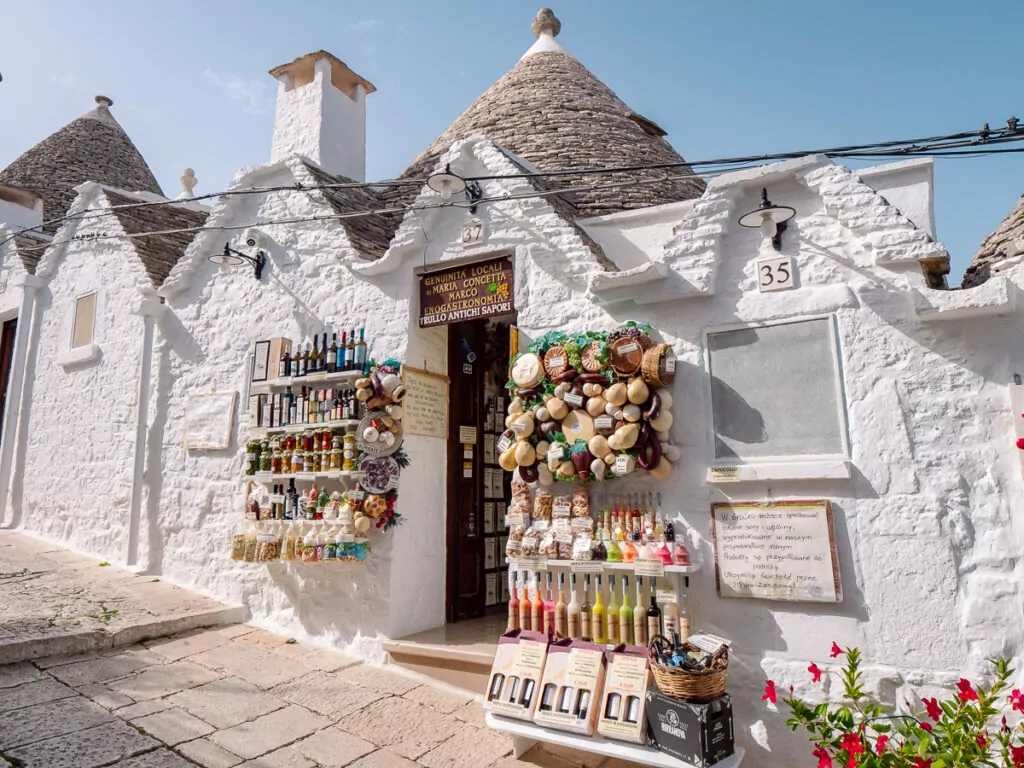
I do want to manage your expectations though, you will need to make some compromises. The coastal towns are linked by trains but the inland spots are harder to reach, some routes are very infrequent so there’s not much room for error, and often the bus or train stations are actually out of the historical centres so you’ll need to walk a bit or grab a cab.
On my three month no-fly Europe trip I spent two weeks in Puglia travelling by bus and train, visiting the cultural hub of Bari, seaside towns of Monopoli and Polignano a Mare, Baroque capital of Lecce, white city of Ostuni, and the Trulli town of Alberobello, plus a side trip to Matera in the neighbouring region (an easy add on). And believe me when I say that I made a bunch of mistakes, so you don’t have to!
In this guide I’ll tell you literally everything I wish I knew before coming to Puglia without a car, from transport tips and tricks, to which towns are worth the effort to visit by public transport, to helpful travel advice to ensure your journey is as smooth as possible. I’ve also given you a recommended itinerary if you’re up for an adventure, or listed some suggestions for where to use as a base if you’d prefer day trips.
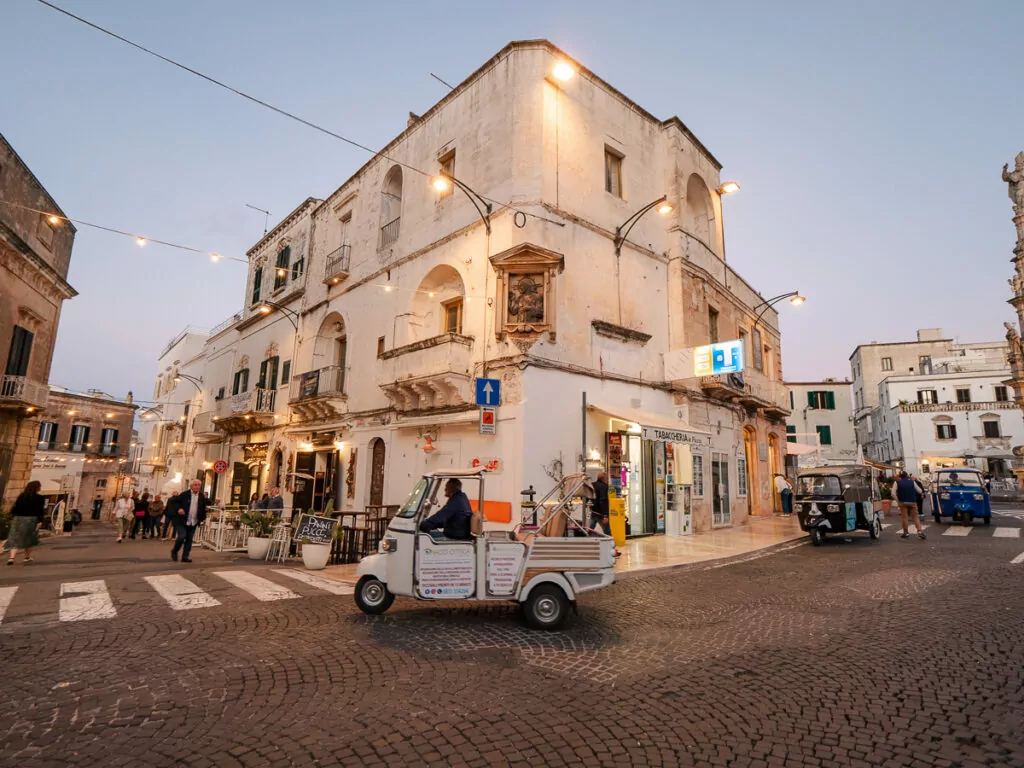
Please note this blog contains affiliate links that give me a small commission from any purchase, at no extra cost to you. I would never advertise anything I wouldn’t use myself, and this commission helps Finding Alexx reach more travellers. Thank you for supporting me!
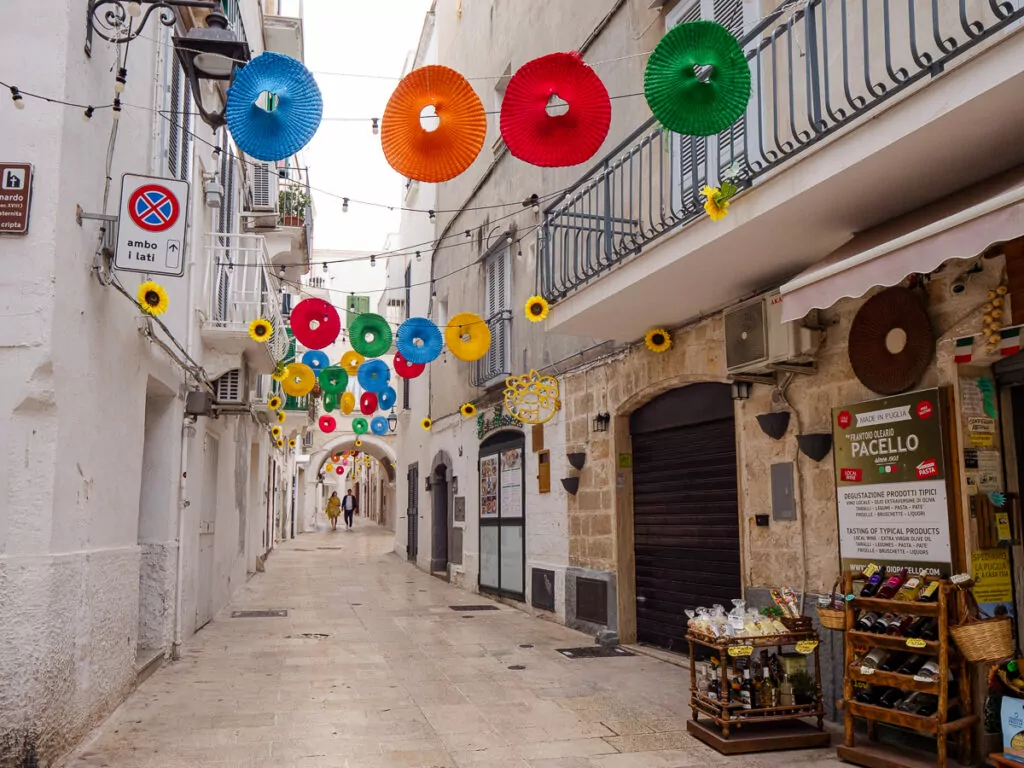
What you need to know before travelling Puglia without a car
Quick note: The terms ‘Puglia’ and ‘Apulia’ refer to the same region, Apulia is the Anglicised version but I’m not sure why that’s needed when Puglia isn’t difficult to say haha. I use Puglia throughout this blog post but just wanted to let you know they’re the same place!
How to get to Puglia
✈️ By air
Fly into Bari (BRI) or Brindisi (BDS), both airports are serviced by low cost carriers like RyanAir, EasyJet, etc. so you can easily find cheap flights.
From Bari Airport you can catch a train to Bari Centrale (though the airport train station is a 15 min walk from Arrivals), catch a bus to the city, pre-book a transfer, or take a taxi.
From Brindisi Airport it’s an easy 10 minute bus from the terminal to the city centre.
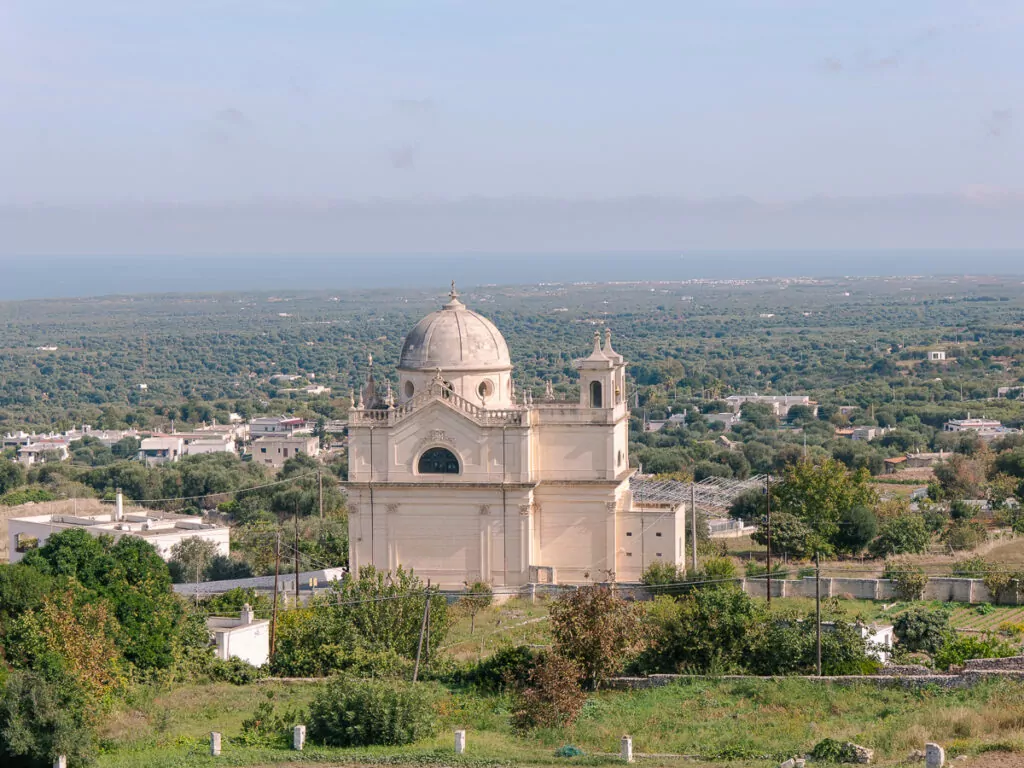
🚂 By train
If you’re coming to Puglia from Northern Italy by train, there are direct high-speed services that connect places like Rome, Milan and Florence to Bari, Brindisi and Lecce. Travel times really depend on the specific route but to give you an idea:
- Milan to Bari: 8-8.5h
- Rome to Bari: 4-4.5h
- Florence to Bari: 6-6.5h
There are also night trains that connect Puglia with Rome and Milan, which are a fantastic way to maximise your travel time and get accommodation + transport for one price.
I took the Intercity Notte 752 from Bari to Milan after my time in Puglia, I used my Eurail Pass and then paid €120 for a private cabin reservation, it was a comfortable 14h journey and ended up being cheaper than any last minute accommodation I could find in Milan!
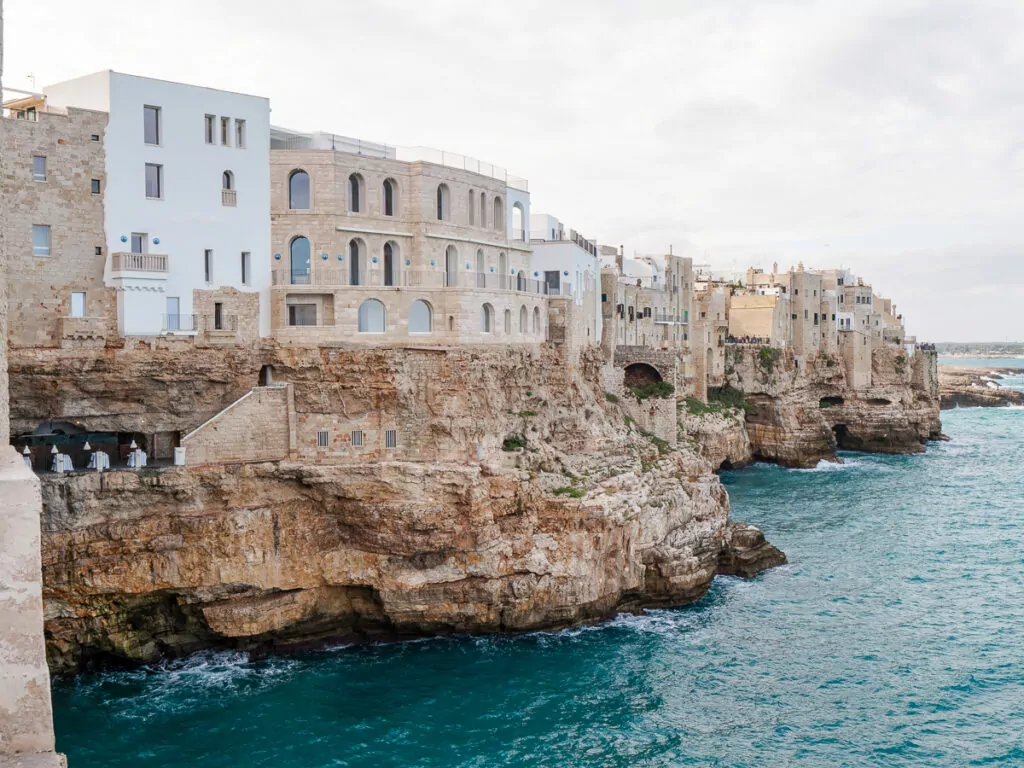
⛴️ By ferry
Puglia is surprisingly well-connected internationally by ferry, with direct sailings from Albania (Durres), Montenegro (Bar), Croatia (Dubrovnik) and Greece (Corfu, Igoumenitsa, Patras).
I took the eight hour day ferry from Dubrovnik and it was ideal, a big boat with lots of comfortable-enough seating, a games area, outdoor decks and more. Nothing fancy, but I was on a mission to see Europe without flying for three months so this was perfect!
Ferry schedules are seasonal, check out the options at FerryHopper >>
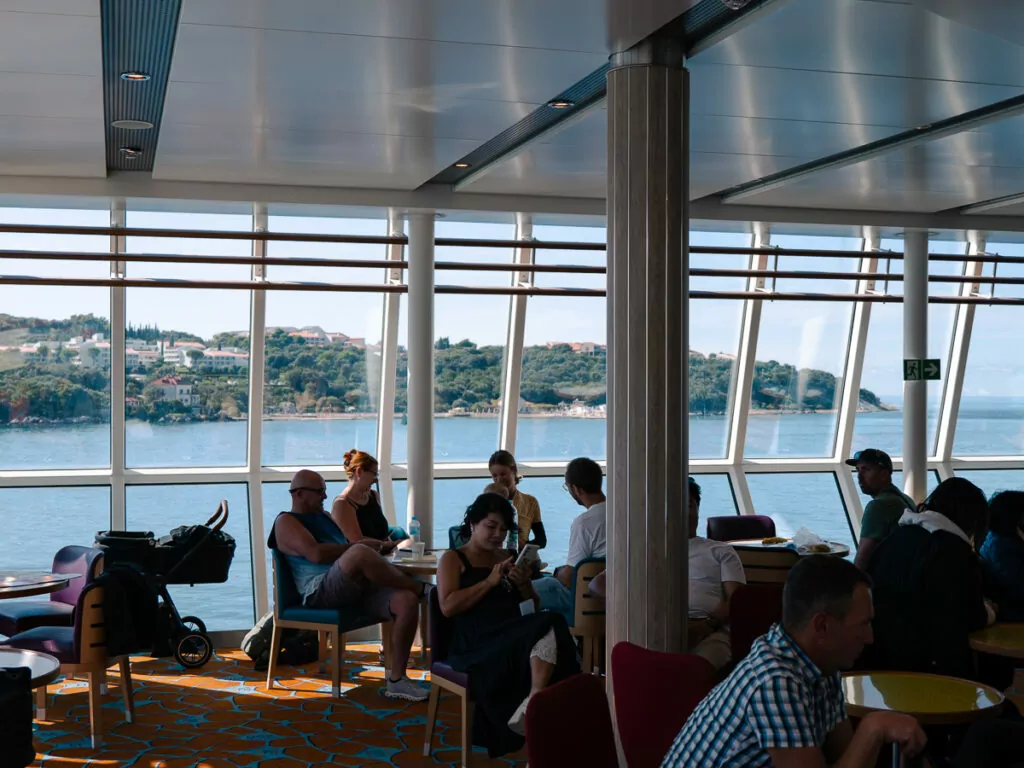
Do you need a car in Puglia?
I won’t lie, Puglia with a car is easier, more convenient and a lot more comfortable.
But, as Theodore Roosevelt said, “Nothing in the world is worth having or worth doing unless it means effort, pain, difficulty“. Clearly he also tried to reach Alberobello from Ostuni by public transport with 30kg of luggage in 32°C heat and 90% humidity 🙃
You do not need a car in Puglia, provided you’re willing to make some compromises.

By compromises, I mean:
- Needing to pre-plan your public transport or spend large on private transfers
- Sticking to the hot spots that are well-connected, and missing out on hidden gems
- Sometimes taking indirect and drawn out journeys to get from A to B
- Walking from train or bus stations to your accommodation
- Having to work around limited bus schedules which can cut into your sightseeing time
- Managing your expectations around what’s possible so you’re not disappointed
But there are benefits of going car-free too!
- No need to worry about parking or have to pay extra for accommodation with parking
- Public transport is much cheaper than rental car + petrol
- Avoid the stress of driving on Italian roads
I still think Puglia without a car is 100% worth it, it just requires more research and planning vs. if you had the freedom of your own vehicle.
🗺️ Looking for more car-free travel itineraries? Check out my guide to visiting the Dolomites without a car
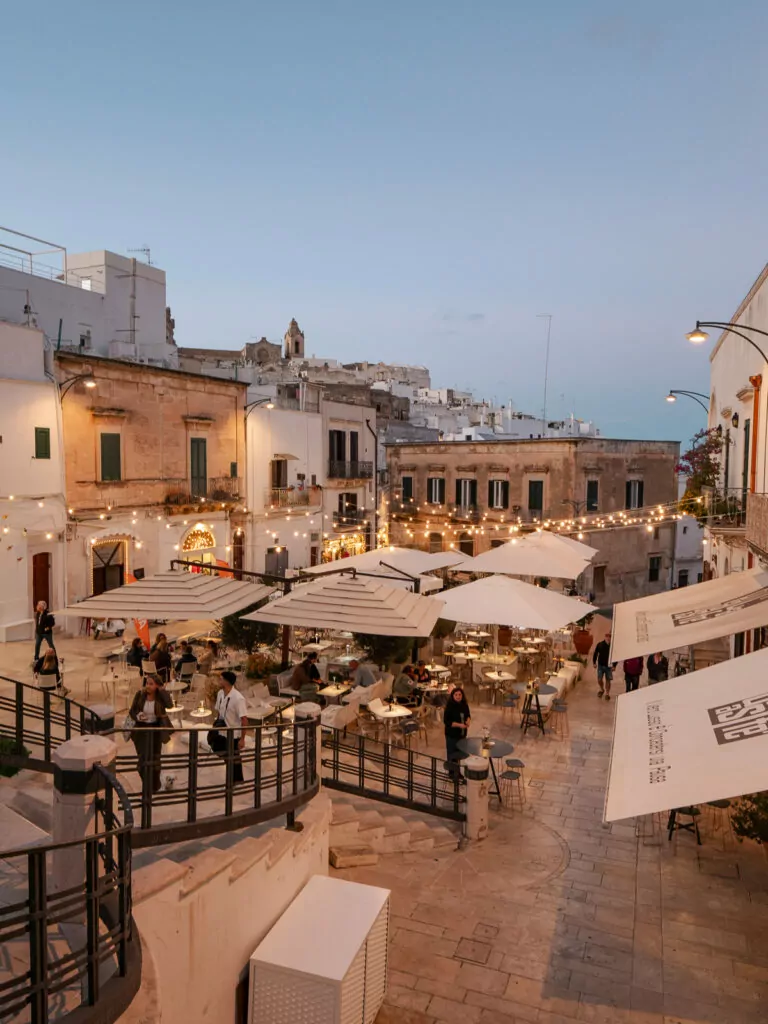
How to get around Puglia without a car
You can reach lots of Puglia’s hot spots with trains and buses (and a bit of patience…), plus there are private transfers, taxis or tours if you’ve got money to spend.
Trains in Puglia
Trains in southern Italy in general are nowhere near as well-connected as the north of the country, but there are convenient and frequent trains between the major coastal towns of Bari, Monopoli, Brindisi and Lecce to name a few, plus some regional trains serving smaller inland stops on a less frequent schedule.
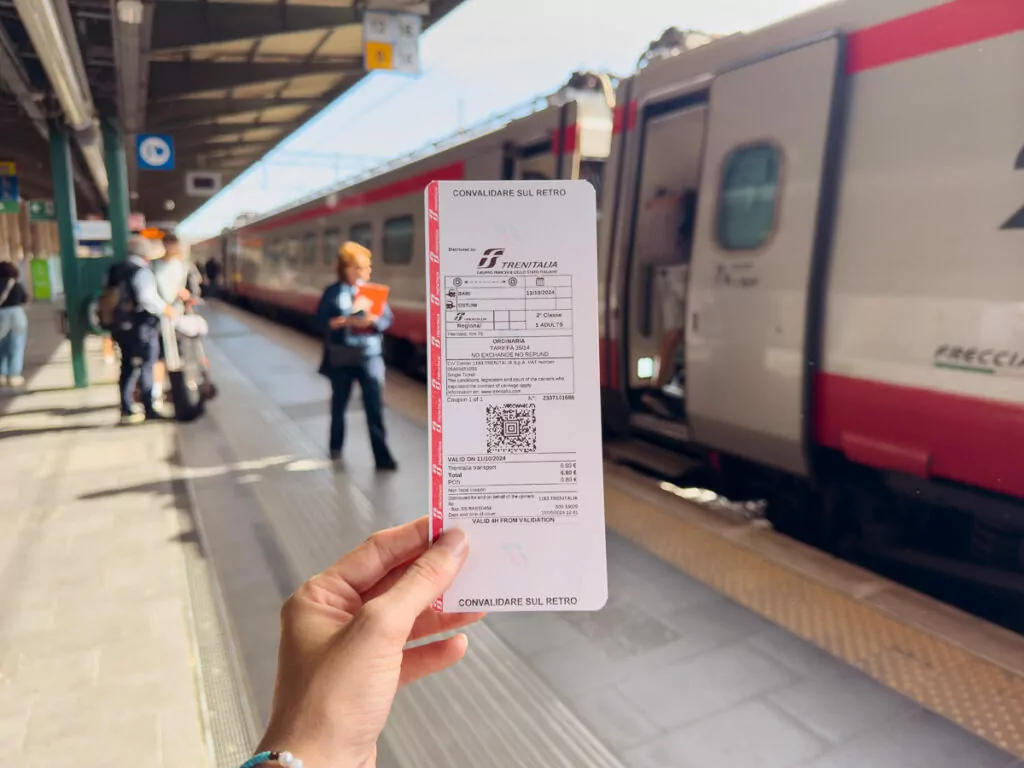
Important things to know about trains in Puglia:
- If you have an un-timed paper ticket from one of the ticket machines, you need to validate your ticket on the platform. If you don’t do this, you could get smacked with a nasty fine!
- If the ticket validation machine isn’t working (fairly common as the understaffed Puglia train stations) then as soon as you get on the train you should try and find a conductor and let them know
- Trains can be delayed or cancelled without notice, if you absolutely need to be somewhere by a certain time then catch an earlier train just to be safe
- You can book tickets on Trainline, on the Trenitalia app or website, or at the station’s ticket machines
- High-speed Freccia trains at busy times might require advance booking (e.g. the Rome to Lecce via Bari trains, because the seats can get booked up), but regional routes and normal non-fast trains are fine to book last minute
- Strikes generally happen at least a few times a year, sometimes these are operator-specific (e.g. just Italo trains or just Trenitalia trains), some are regional, some are nationwide. Strikes in Italy are always scheduled and announced in advance (see up to date strike info here) so you can plan around it.
- Most train stations are quite far from the historical city centres, so there might be a bit of a walk to your accommodation. Ostuni’s train station is actually so far from the city that you need to walk 5 mins to the bus stop and then catch a bus to Ostuni town, then walk 10 minutes to the centre 🫠
- Make sure you get on the right train! There are multiple train operators and one ticket won’t work for a different operator, e.g. if you buy a ticket for a Regionale Veloce train (the fast regional trains) then you won’t be able to use that on a Freccia train (the high-speed intercity routes)
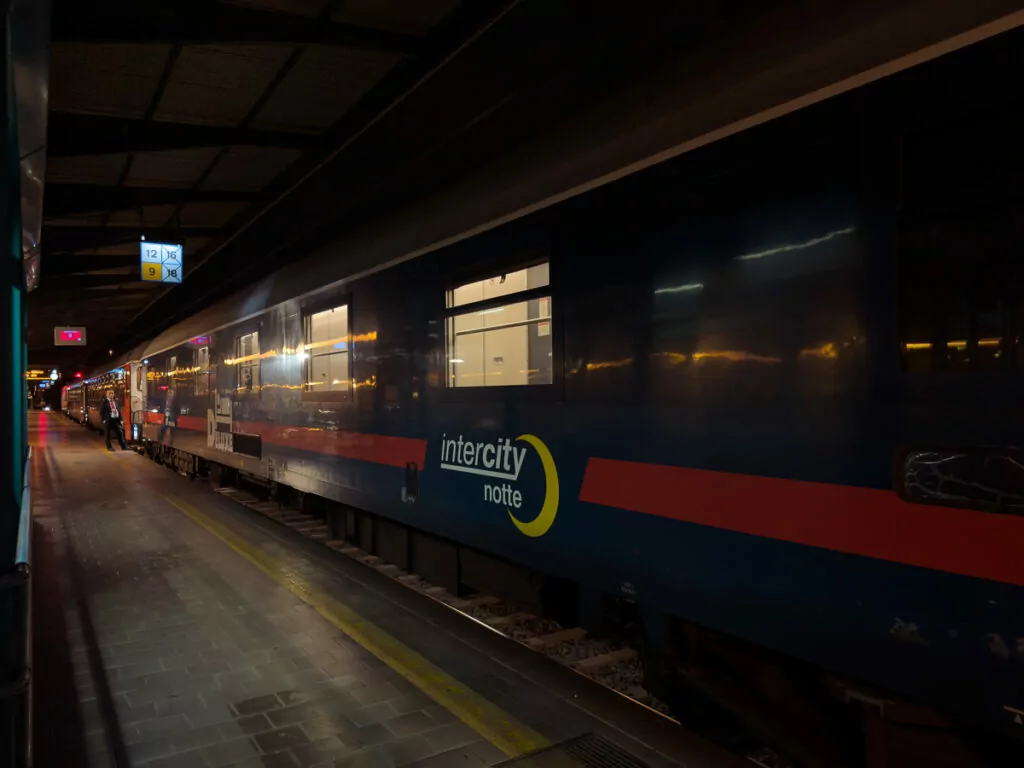
Buses in Puglia
Buses fill the gaps in the public transport network, connecting towns and communes where trains don’t reach.
I want to be careful about giving you specific information here because the bus system is pretty messy, so much of what I read online was incorrect and I think that’s because they just change things so often!
The most important things to know are:
- There are multiple bus operators including Ferrovie del Sud Est (FSE), FlixBus, Marino and STP
- Google Maps is actually fairly accurate in my experience and provides options from most (if not all) operators
- But in saying that, the best option is to find your ideal route on Google Maps and then go to the local information centre to check that it’s correct as they’ll have the most up-to-date info
- You can use Omio or Trainline to check routes and buy some tickets online, but they don’t show as many options as Google Maps
- Schedules change seasonally and some routes might only run once or twice a day
- Weekend schedules are limited
- Bus stops might not be well sign-posted or might have out-of-date schedules printed, don’t trust it unless it says the dates it is valid for
- Regional buses in Puglia like FSE or STP don’t need to be booked in advance, but FlixBus tickets are priced dynamically (meaning they get more expensive the busier the bus is) and tickets can sell out during popular travel times
- Many regional buses are cash only on board or you can buy tickets from tabaccheria (a small convenience stall or store)
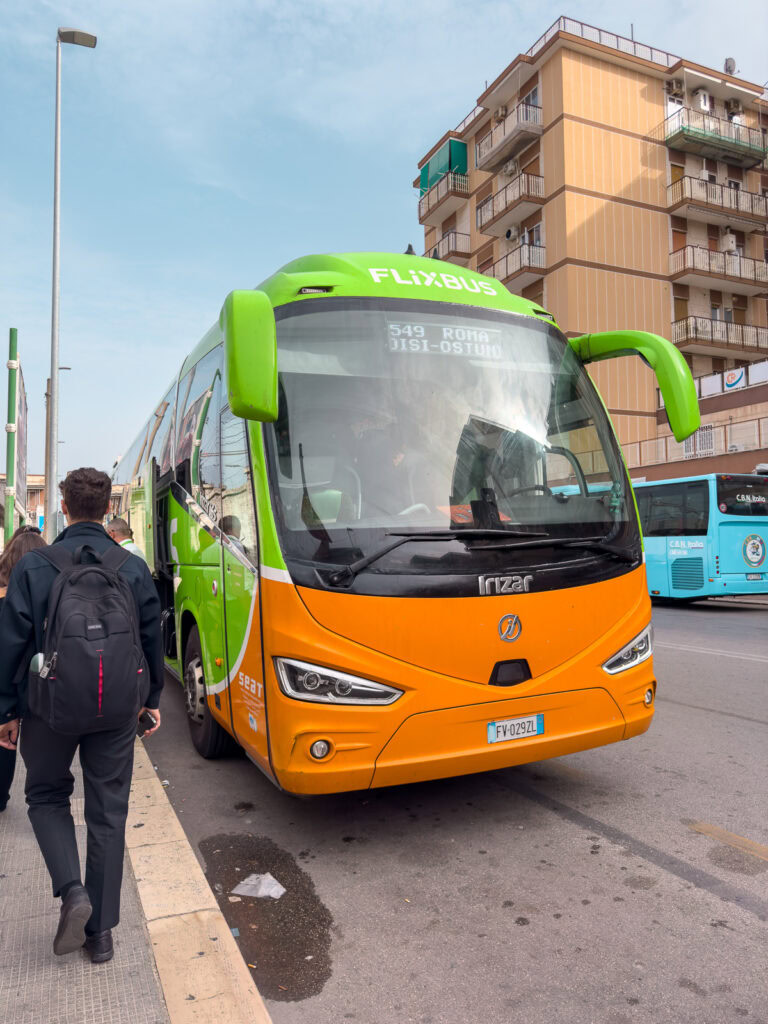
Private transfers in Puglia
If all that info is already stressing you out, and you’re not too tight on your travel budget, you could book private transfers to get between places that aren’t on the easy coastal train route.
Prices differ drastically depending on where you’re going, but expect to pay upwards of €120 for a car/van for a one hour drive. You can search for transfer options on Viator or GetYourGuide.
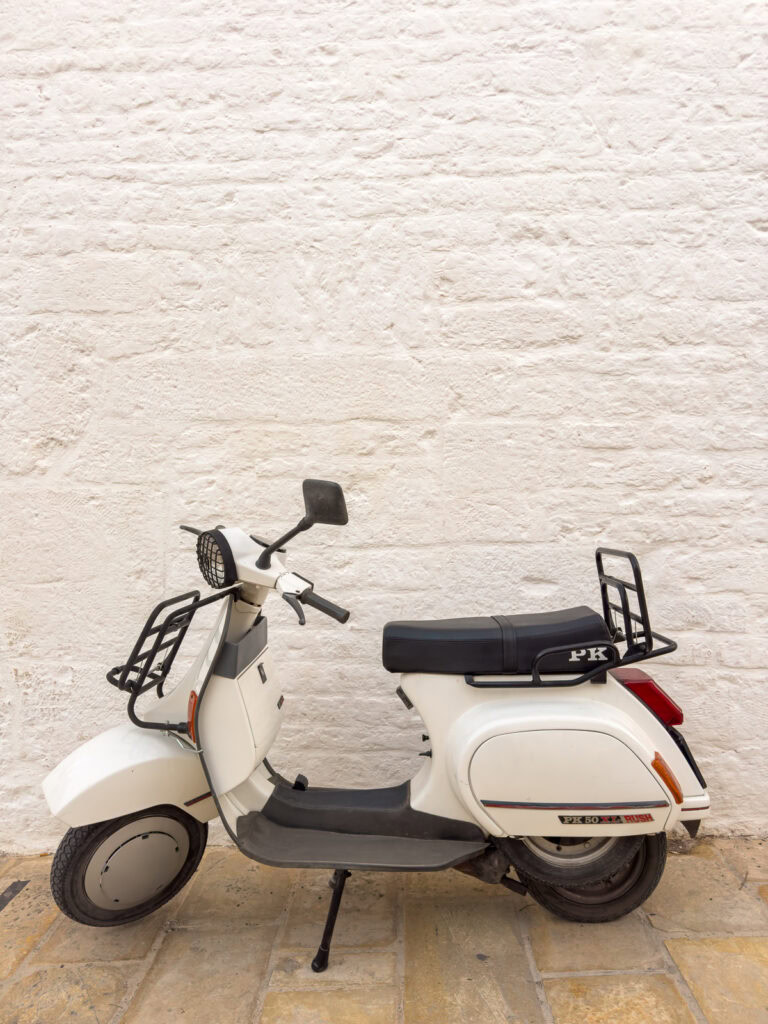
Tours in Puglia
For a super smooth Puglia experience without needing your own vehicle, consider booking a small group tour. You’ll get from A to B without any stress, have an expert guide to show you around, and get to meet some ready-made travel buddies.
Some top-rated Puglia tours are:
- Explore Southern Italy with Intrepid
- Premium Puglia with Intrepid
- Cycling Puglia & Matera with Exodus
- Seductive Southern Italy with Culture Trip
- Puglia & Matera with Italy on a Budget
- Highlights of Puglia with Explore!
- Puglia Explorer with On the Go
- A Taste of Italy with Explore!
All of those links are to TourRadar which is like the Skyscanner of tours, if you book through TourRadar you can save $100/€100/£100 with the promocode ALEXX100 💰
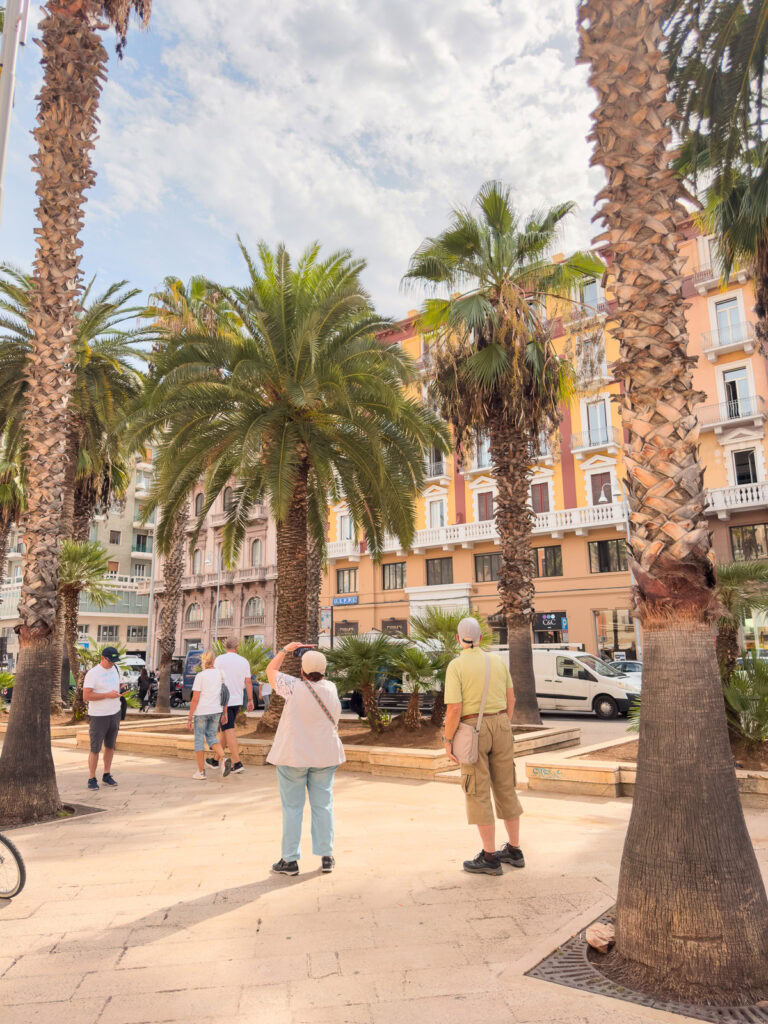
How long to spend in Puglia
Puglia has lots going on, and the various cities/towns offer vastly different experiences, so at a minimum you’ll want to visit three or four different places. Travelling by trains and buses often takes longer than if you had a rental car too, so some buffer days are necessary in case of any issues.
The ideal length of time for visiting Puglia without a car would be two weeks to really have time to explore without rushing, that’ll let you overnight in up to 5-6 different spots (if you wish), with lots of time for sightseeing and soaking up the vibe.
With 10-14 days you could still see a lot, either by reducing your overnight stops to 3-4 max or by travelling at a faster pace (or a mix of both).
If you’ve got one week (or less) in Puglia I’d suggest splitting your time between two places at the most or just choosing a single base, and doing day trips from there.
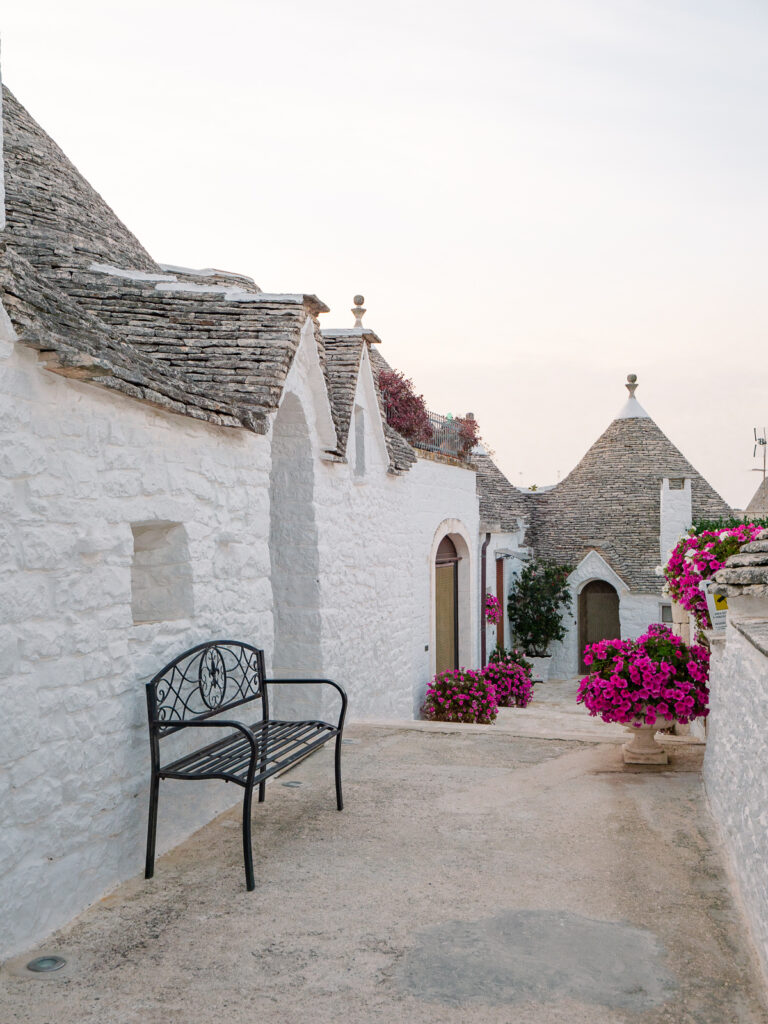
When to visit Puglia
The best time to visit Puglia without a car is the shoulder season, from April to early/mid-June and then mid-September to end of October. These months have pleasant and mild weather, fewer tourists to compete with for bus seats, but transport schedules will be more frequent than the off season.
What to expect for different seasons in Puglia
🔥 Peak summer (July/August): Hot and sunny with lots of fun stuff going on, but suuuuper crowded. Beaches are packed, accommodation prices skyrocket, popular bus routes between tourist towns get full so your travel plans can get disrupted. Avoid it if you can, if you can’t change your dates then I’d recommend booking in advance, using one place as a base and doing day trips, and understand that things will be hectic!
🍂 Autumn (September/October): My favourite time in Puglia! Lovely warm days but it can get chilly when the sun goes down. Crowds start to thin from mid-September, places like Alberobello, Monopoli and Matera are still busy with daytrippers from Bari right through to end of Oct, but after 5pm they go back to ‘normal’ and feel much more local. Olive harvest season means there are olive experiences on offer at some masserie (farmstays).
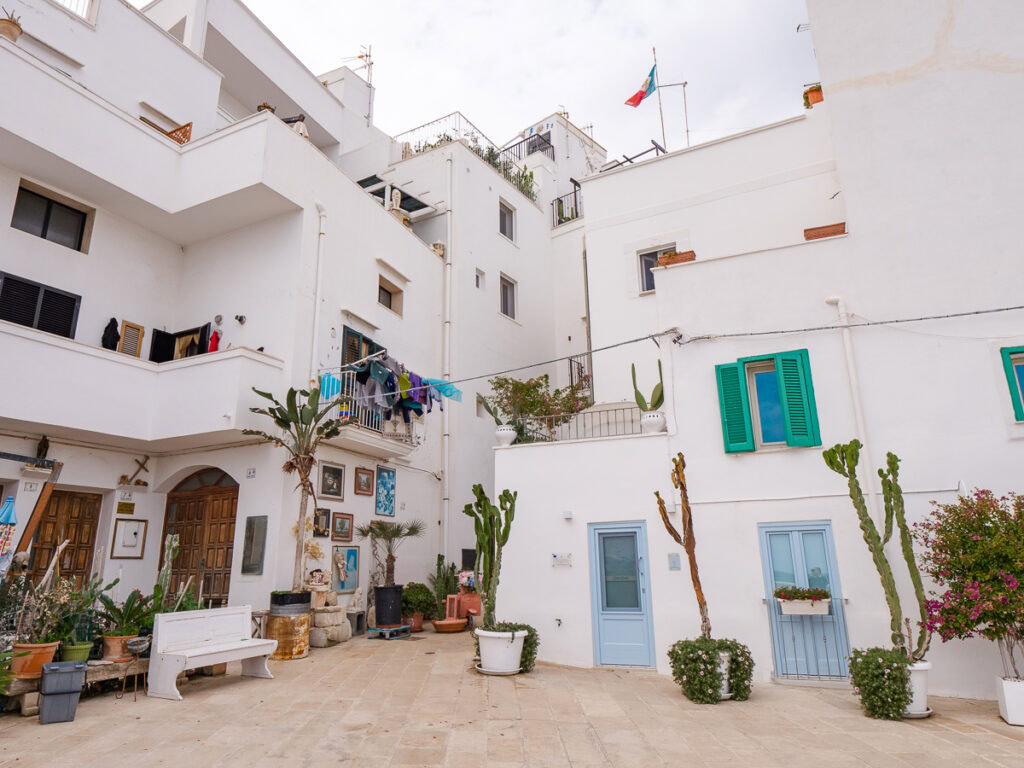
❄️ Low season (November-March): Cool temps, quite a bit of rain, hardly any tourists. Some businesses close for the off season, especially in the coastal towns, but you’ll always find fantastic food and moody landscapes. Transport schedules are pretty limited to what locals use.
💐 Spring (April-June): Mild weather returns, tourist activities and transport come back to life. Easter is busy busy busy (like anywhere in Italy) but aside from that spike it’s a gradual rise in crowds and prices. Mid-June marks the end of the school year for Italy so domestic visitors start pouring in from then onwards.
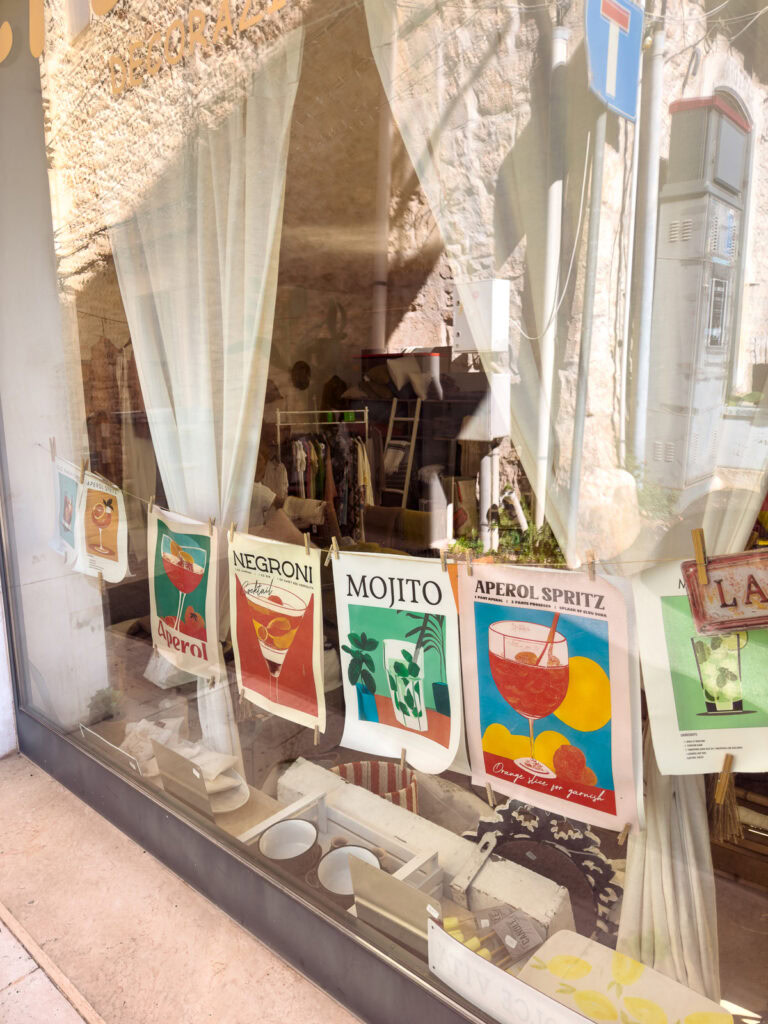
What to pack for Puglia
This is a prime example of how you can learn from my mistakes: PACK LIGHT. Puglia’s cobblestone streets and steep hillside villages are not made for heavy suitcases or backpacks!
The train and bus stations in Puglia are usually quite a distance from the main tourist areas, so expect to walk 10-15+ minutes from your drop-off point to reach your accommodation. Pack with that in mind and you’ll be fine.
Some essentials are:
- Comfortable walking shoes (I swear by my Allbirds)
- A reusable water bottle
- SPF, a hat and sunglasses
- A day bag for exploring, I use a Brevite Jumper
- A power bank because Google Maps chews up your battery
- Layered clothing, those hillside towns get hot hot hot in the middle of the day but coastal winds or after sunset can bring some chill
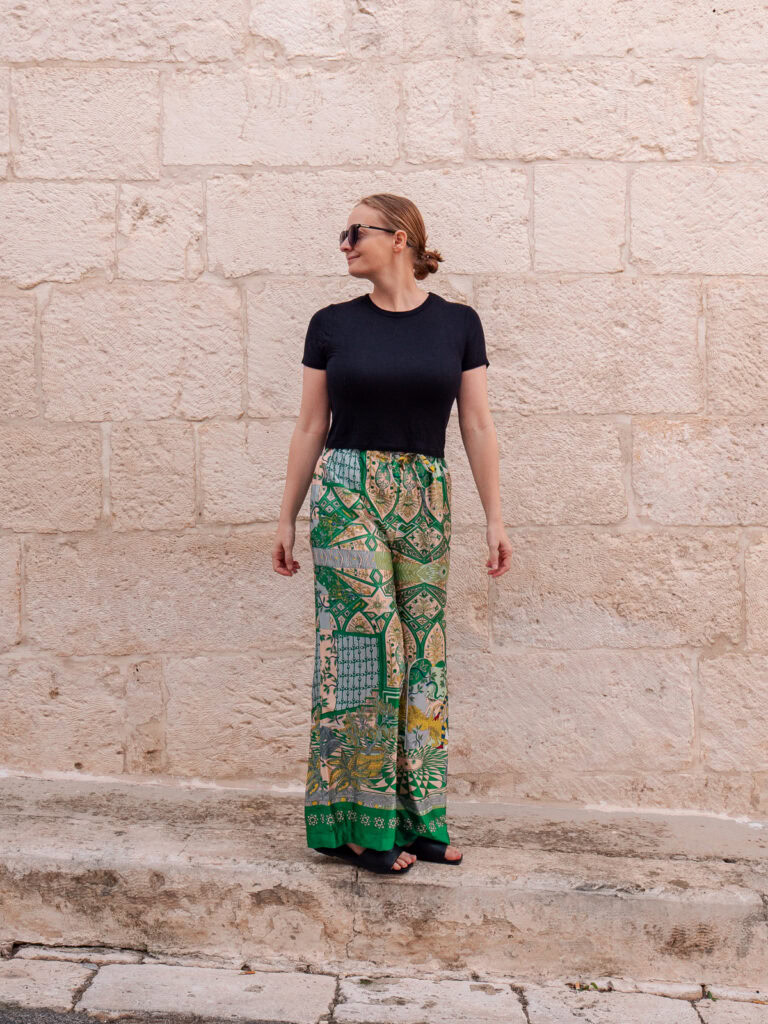
Accommodation in Puglia
Puglia is still quite old school in terms of its tourism infrastructure, with the majority of accommodation options being owner-managed or independent local operators.
If you’re on a budget, the backpacker hostel scene is limited (there are less than 10 in the whole region) but there are guesthouses and homestays offering affordable rooms instead.
Keep in mind that these might not have the amenities you’d get in a hotel, e.g. there may not be an elevator, air con, luggage storage after check out etc. On the plus side though they sometimes have kitchen facilities and offer a much more authentic hospitality experience.

Big hotels are few and far between, and you definitely pay a premium for them. I’d say hotels are almost never worth it in Puglia unless you desperately need extras like late checkout or somewhere to leave luggage.
I booked a hotel in Bari because I had a night train at 9pm and needed to be able to use luggage storage and wait in the lobby until then, and the cheapest option was €120 for a single room with nothing except a single bed, a desk and a bathroom, no minifridge, kettle etc. 🙃 ouch.
There are private apartments you can rent throughout Puglia, there are options for all budgets and you can find lots of them on booking.com.
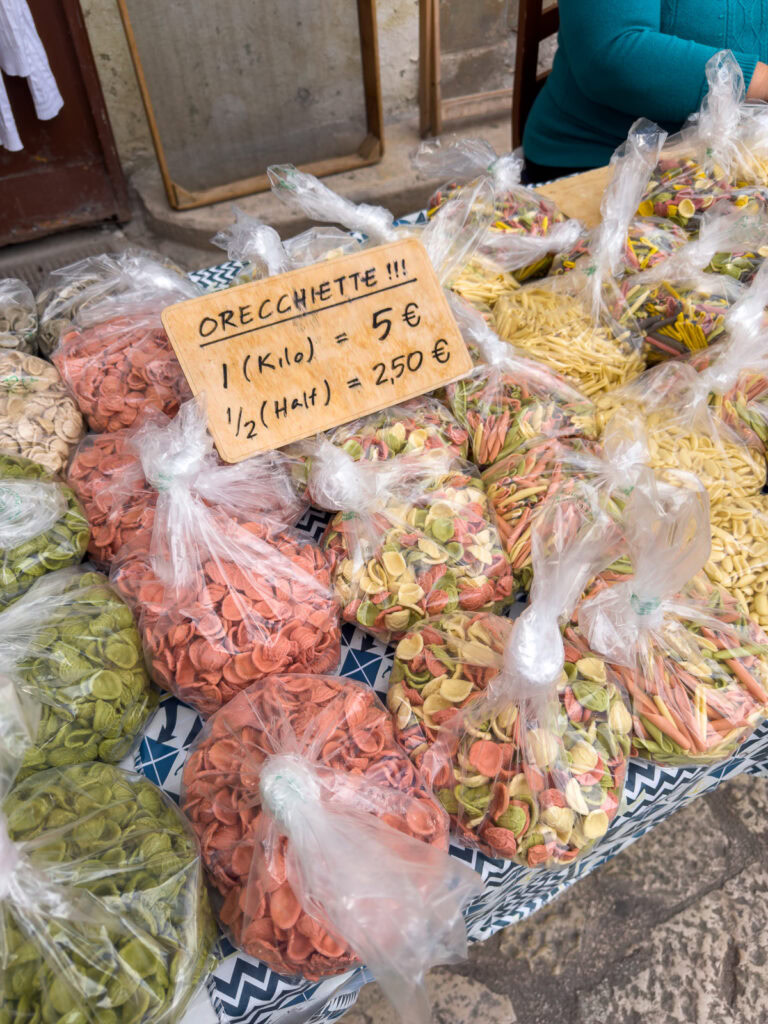
Unique stays in Puglia
One of my faaaavourite things about Puglia is that the region punches well above its weight in terms of unique accommodation, and there are a few different overnight experiences you can find here that you won’t find elsewhere in Italy.
A trullo (plural: trulli) is a stone house with a cone-shaped roof found in Alberobello and Locorotondo, as well as the countryside throughout the Itria Valley. One for the bucket list!
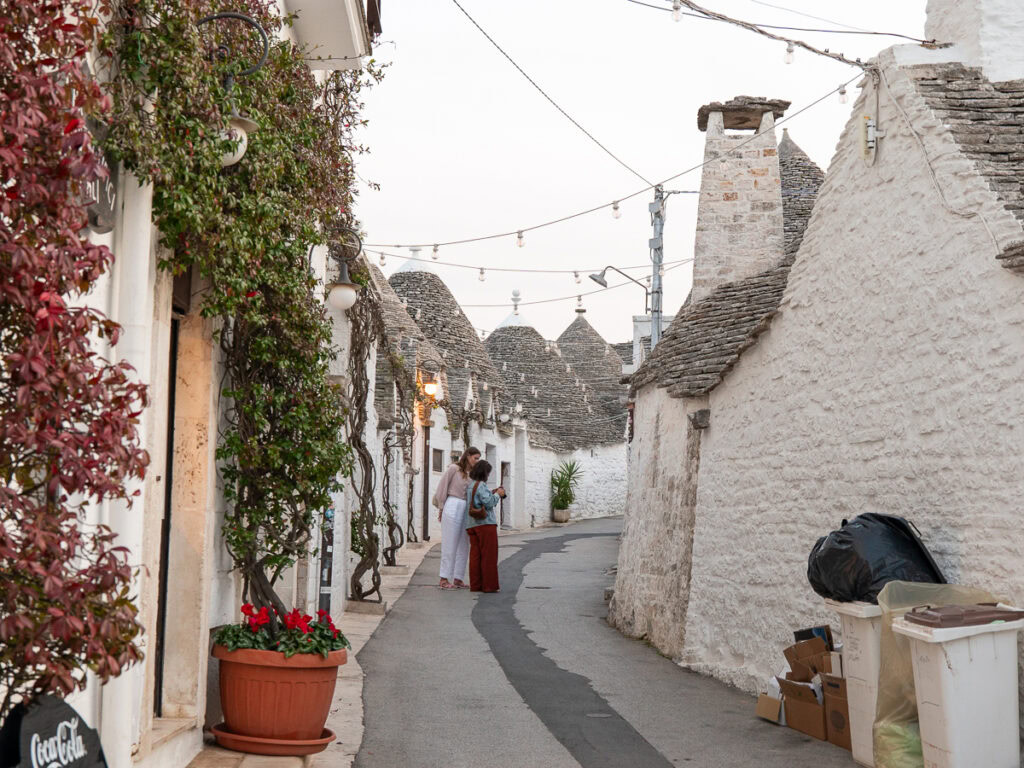
A masseria (plural: masserie) is a traditional fortified farmhouse, once used to house all the workers for a particular farm but now they’ve been transformed to hospitality experiences, offering peace and quiet away from touristy old towns and buzzing beaches.
You can find masserie that range from rustic and affordable through to boutique luxury, and everything in between. Most have their own gardens and olive groves, serving breakfast at a minimum or some might do lunch and dinner too.
A masseria stay is a bit tricky without a car as they’re located in the countryside, but some might offer transfers to and from the nearest town, or you could try find one that’s on a bus route.
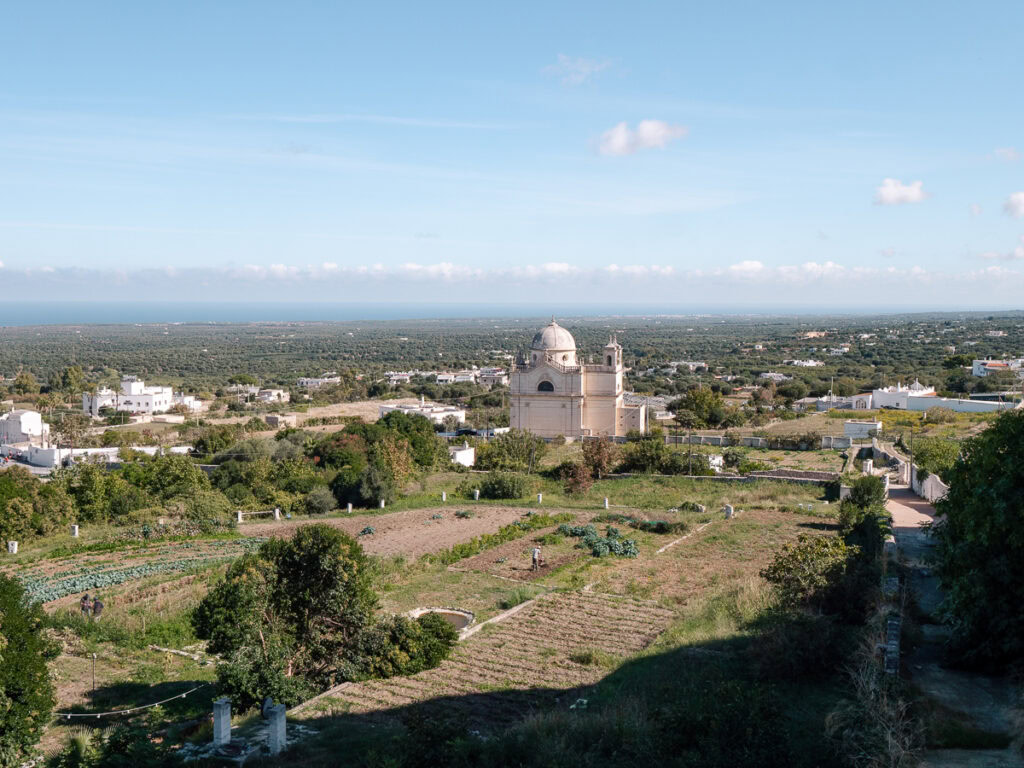
And another overnighter that’s worth making a special trip for is a cave hotel/house in Sassi di Matera, one of the oldest cities in Europe! I’d recommend choosing one with a terrace (I stayed here) because seeing the Sassi lit up at night is pure magic.
📌 Important to know: Matera isn’t actually in Puglia, it’s in the Basilicata region, but it’s only an hour form Bari by car and less than 15km from the Puglia regional border so it’s a very popular add on to a Puglia trip. Just don’t tell a Matera local ‘I’m loving my time in Puglia’ because they might take offence haha.
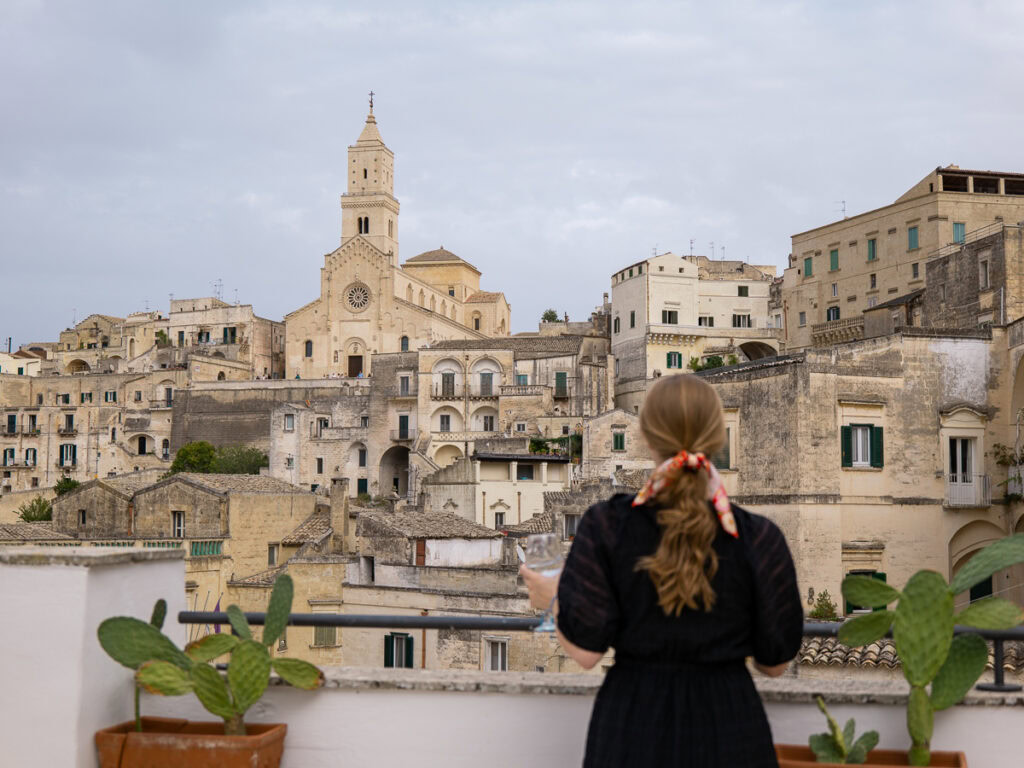
What to budget for travelling Puglia without a car
Overall I found Puglia to be quite a bit cheaper than other coastal hot spots like the Amalfi Coast or Cinque Terre, but prices do vary a lot depending on season.
🛌🏼 Accommodation
Prices below are typical starting prices per room per night in shoulder season, expect to add 30-50% for peak summer or public holidays.
Bari (significantly more expensive than other towns)
- Hostel dorm beds: €35-50
- Guesthouses/apartments outside of Bari Vecchia (the old town): €65-90
- Bari Vecchia guesthouses/apartments: €100-150
- Mid-range hotel: €100-150
- Luxury hotels: €250+
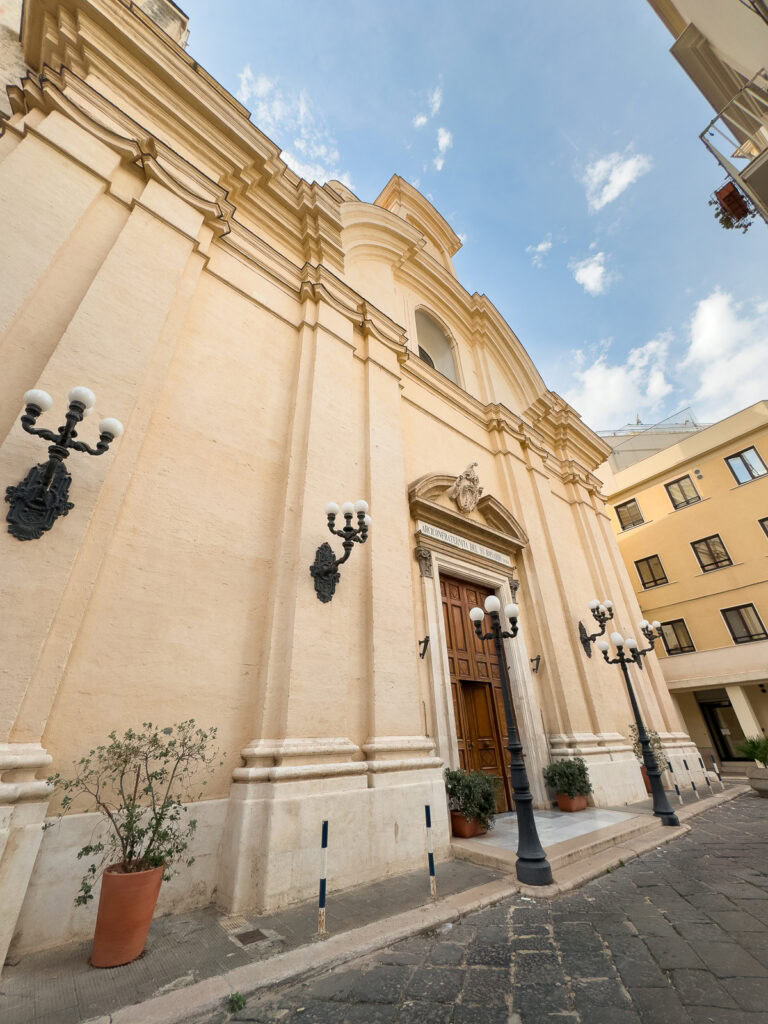
Smaller cities (Lecce, Brindisi, Ostuni etc.)
- Hostel dorm beds: €20-25
- Guesthouses: €40-50
- Apartments: €50-80
- Luxury hotels: €150-250
Unique accommodation
- Trulli in Alberobello/Locorotondo from €80 in the shoulder season (expect to spend at least €110-140 in summer)
- Masserie from €100 for the affordable options, €150-250 for boutique, some luxury ones are four figures 🤯
- Sassi di Matera cave houses from €50 without a view, places with a view or access to a terrace are around €120+ *but* I managed to get a last minute deal for €90 the day before I went, so it’s worth checking to see if you can snag a bargain
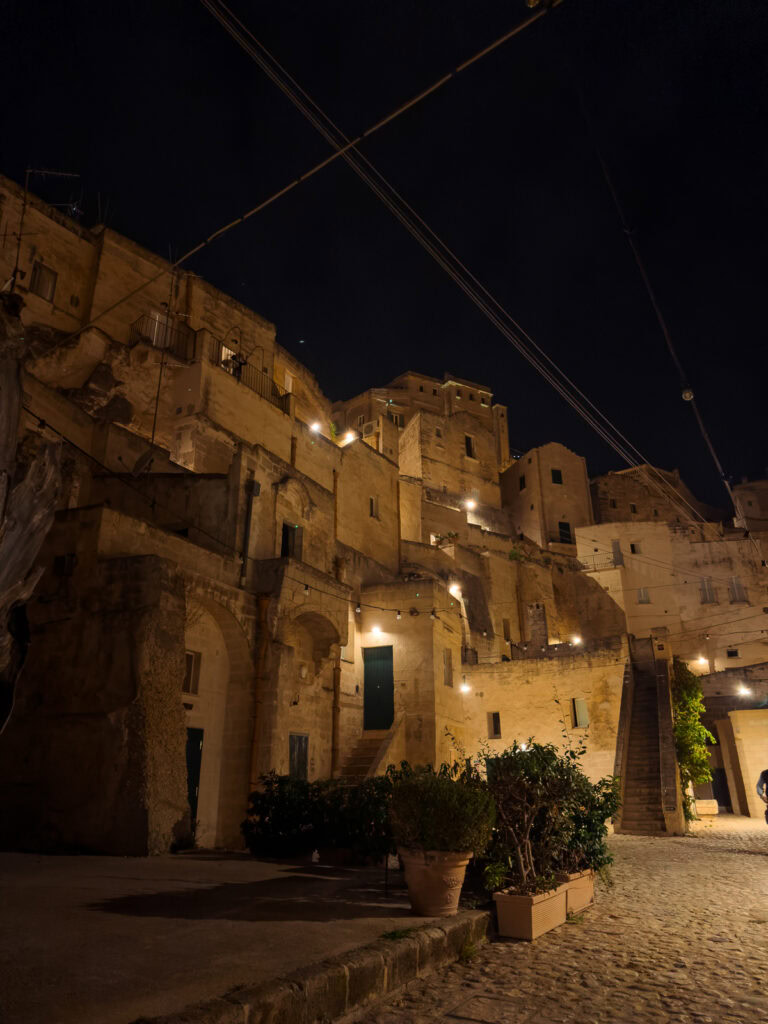
🚌 Transport
- Local transport is cheap, prices depend on start and end point but expect to pay €1-3 for short bus trips or trains, and €5-12 for longer trips within the region
- One thing to note is that the Bari to Matera bus route is operated by FlixBus, and their tickets are dynamically-priced which means they go up with demand. I made the mistake of leaving it to the last minute and my one way ticket was €32 🫠 if I had booked it a week earlier it would’ve been €8!
- Taxis are quite expensive and can be hard to find in the smaller towns, I’d only use these as a last resort. Try to book accommodation that’s convenient for your exploring plans!
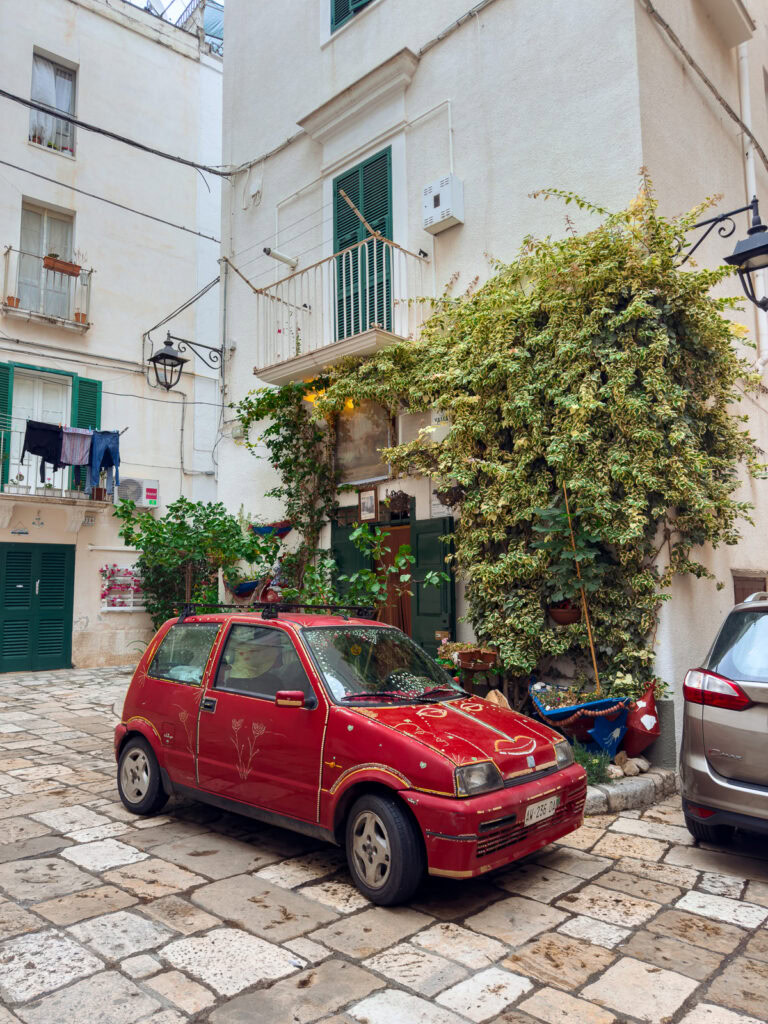
🍝 Food
- You can find light bites and snacks from €1-5 like focaccia, panzerotti, a bag of tarallini etc.
- Meals at restaurants start from €6-8 for casual eateries or expect to pay €20-40 per person for a two-course dinner somewhere nice
- Puglia has lots of faaancy restaurants that have set menus for €150+, but the overall quality of food across the whole region is fantastic, you don’t have to spend lots of money to enjoy your meal!
- Supermarkets and local markets are great if you’re on a budget
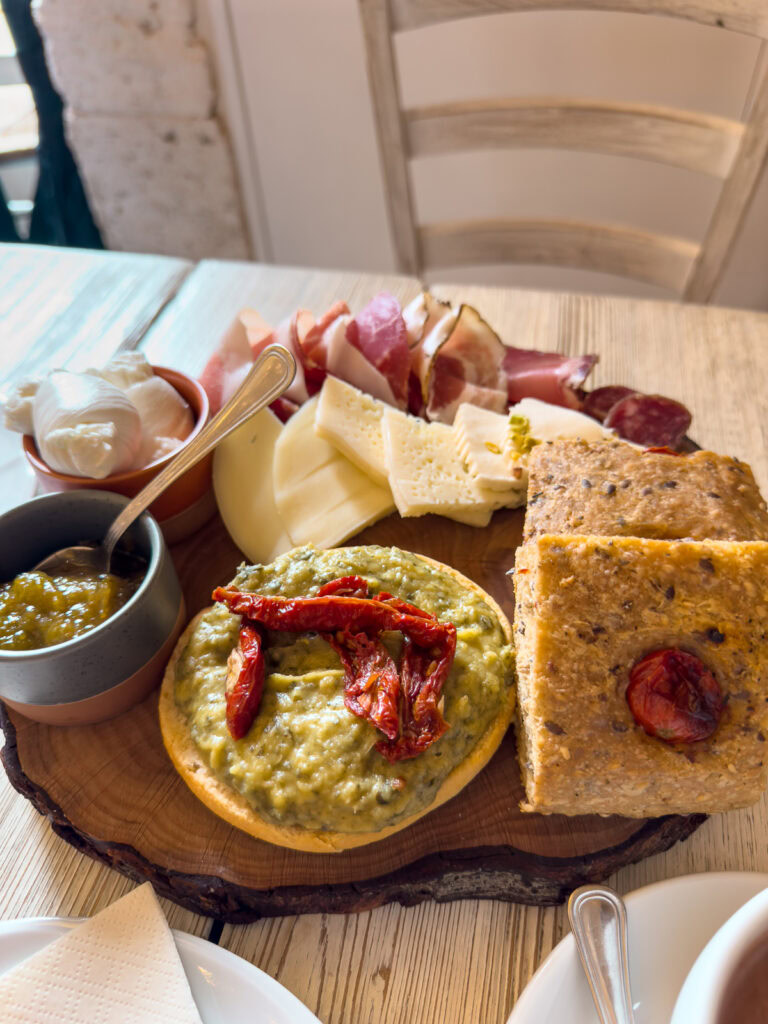
🎟️ Activities
One of the best things about Puglia is that you don’t actually have to do that much, the magic is just in the vibe, the views, the experience! Wandering the streets is free, the cuisine is a huge part of the region’s allure, and there are lots of public beaches that won’t set you back anything.
But if you’re an active relaxer, some activities you might want to budget for are:
- Food tours from €40-50
- Pasta cooking classes from €120
- Boat tours along the coast from €35
- Day trips to other towns if you’re going to stick to one base, from €70-120
- City tours from €25
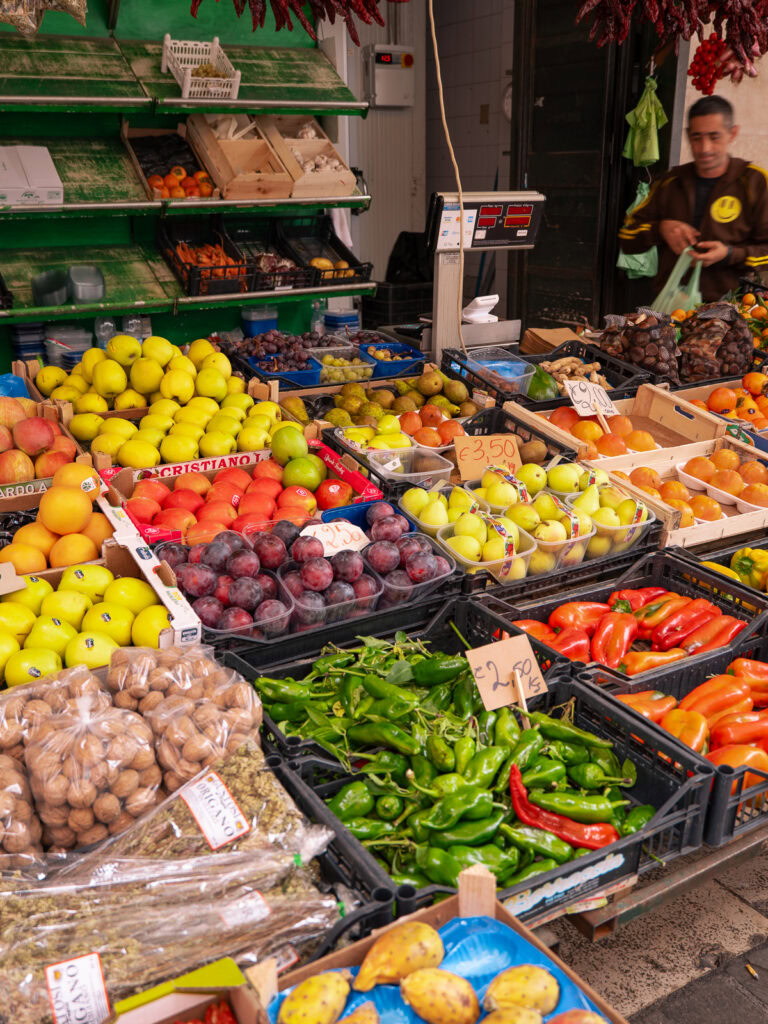
Pennichella/riposo/la pausa (the Italian siesta)
I’ve been to Italy more than 15 times, and never have I ever seen somewhere take the afternoon nap tradition so seriously as Puglia does!
‘Siesta’ is what they call it in Spain, but in Italy it’s called ‘riposo’ in the north and sometimes called ‘pennichella’ or ‘la pausa’ in the south. It refers to the afternoon break that people take to head home and rest, and in Puglia it’s common for restaurants, shops, all services to close from the early afternoon (generally 2pm-ish, sometimes earlier) until 5pm or 6pm.
You really need to keep this in mind when planning out your days, because there’s nothing worse than exploring in the midday heat until you finally decide it’s time to sit down for a meal, aaaand realise everything is closed. And not just closed for an hour or two, closed until the early evening 🙃
In Bari you will find fast food, chain clothing retailers and some touristy restaurants might stay open, but in smaller towns literally everything shuts down except for big supermarkets.
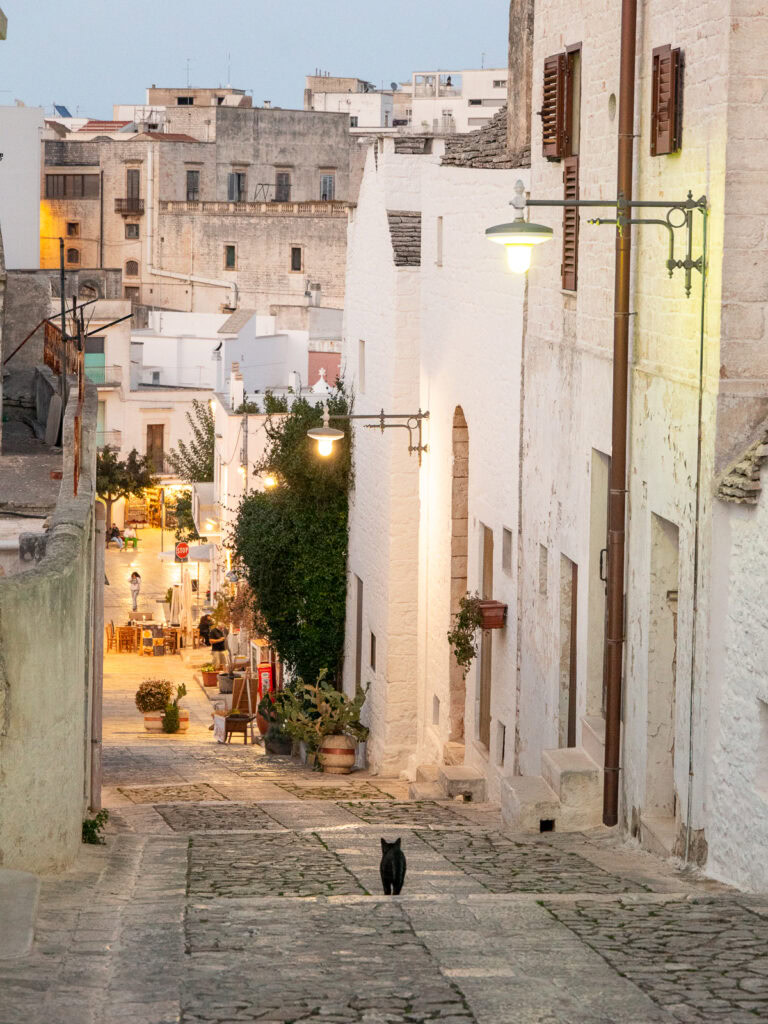
Safety in Puglia
The region of Puglia is considered to be safe for tourists, violent crime is rare and there are no particular safety concerns that make it different from anywhere else in Italy.
Bari is the least safe place, only in that it’s a busy city so you need to take the usual precautions of keeping valuables secure, avoiding dark streets at night, etc. The area around Bari train station isn’t very nice and lots of young people congregate there after dark which can be intimidating, but I didn’t feel anywhere near as on edge here vs. walking around Milano Centrale, Roma Termini or Napoli Centrale.
Other parts of Puglia felt extremely safe to me, like Ostuni, Alberobello, Lecce, Monopoli, etc., and I had no issues walking around at night from my accommodation to restaurants and back.
Puglia feels very local and it seemed to be that the communities are generally a bit older and very respectful of tourists, I didn’t experience or witness any catcalling or street harassment. Quite a change from the big cities in the north!
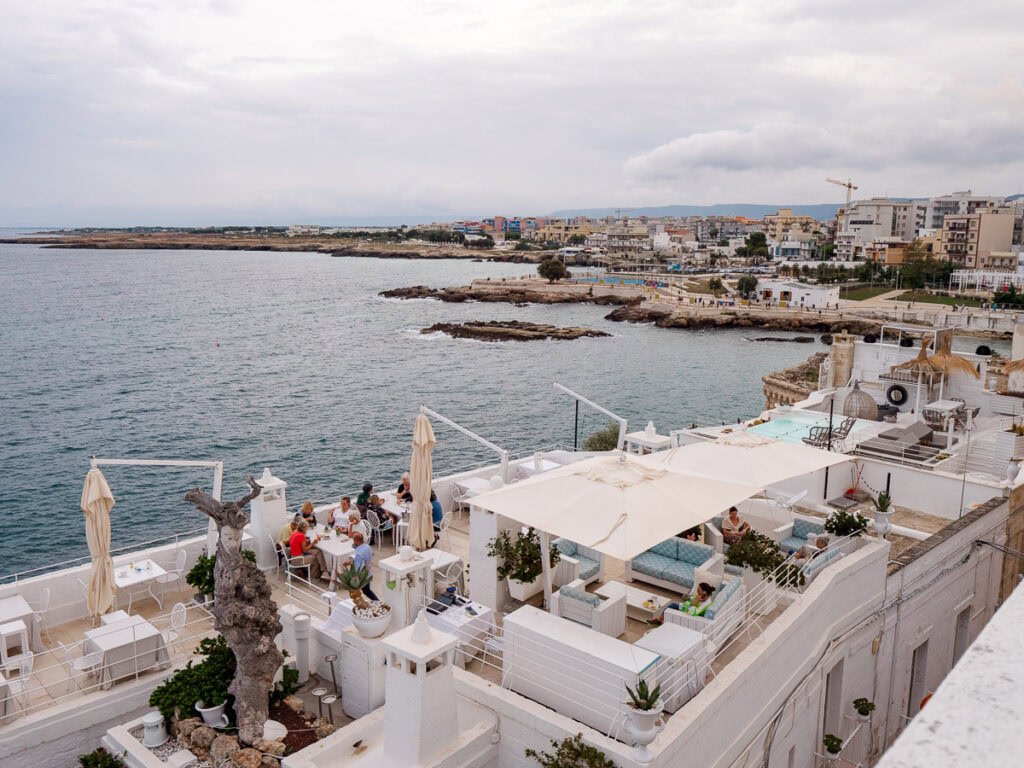
The best eSIM for Puglia
Gone are the days where we need to waste money on expensive roaming plans or line up at the airport to change out our physical SIM card, most phones these days are eSIM-compatible which means we can download an eSIM and load it with a local plan for where we’re visiting. Super convenient, very cheap!
But you should be warned, many eSIM companies are absolutely ripping you off. Particularly the ones you’ve probably seen promoted all over social media!
I use MobiMatter for almost all of my travels, I’ve partnered with them in the past but I was a paying customer for a year first, I have no ongoing contract with them right now but I still buy their SIMs when they’re the cheapest option, which is the case in nearly every country I visit. But don’t take my word for it, here’s a comparison with links to check for yourself:
- Mobimatter: 50GB in Italy only for €34 or 60GB in Europe over 60 days for €51
- Airalo: 20GB in Italy only for €33.50 or 50GB in Europe for €100.50
- Orange: 30GB in Europe for €39.99 or 70GB in Europe for €49.99 (but only 28 days)
- Nomad: 20GB in Italy only for €32.50
- Saily: 50GB in Europe for €92
- Jetpac: 30GB in Italy only for €23 (slightly cheaper than MobiMatter but only 4G, not 5G)
- Holafly: 10 days unlimited in Italy for €33.90
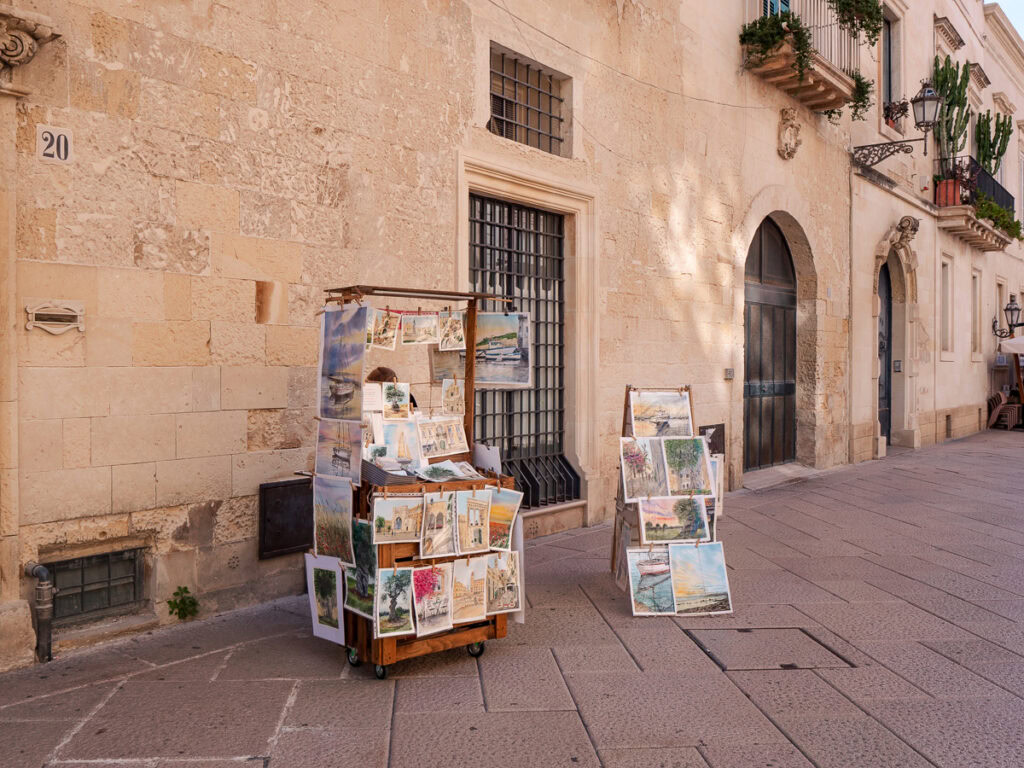
Places to visit in Puglia without a car
Bari
How to get to Bari
- Most travellers arrive into Bari by air, it’s the main airport in Puglia and you can get cheap flights on RyanAir, EasyJet and other low cost carriers
- If you’re travelling by train there are direct options from Rome, Milan, Naples and Florence
- And if you’re coming from the other side of the Adriatic, you can catch a ferry to Bari from Albania, Greece or Croatia.
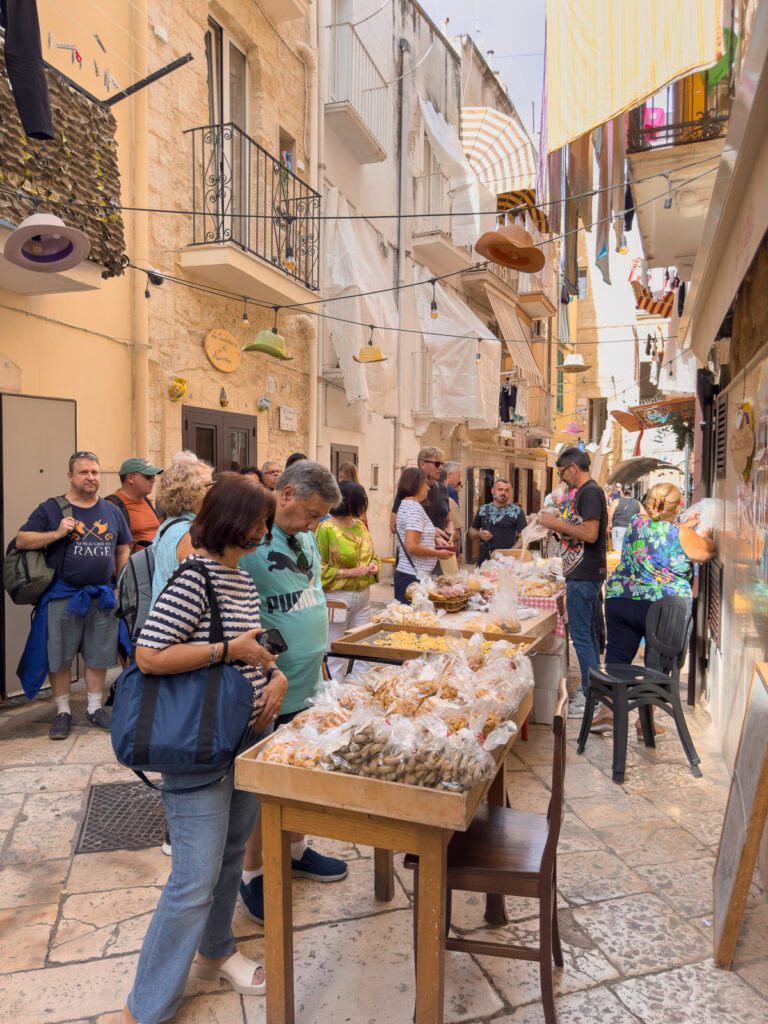
About Bari
Puglia’s biggest city might not be the prettiest destination on this list, but spend some time wandering through the charming Bari Vecchia (the old town) and you’ll soon see it’s worth more than just a train station transfer. Nonnas folding orecchiette pasta outside their homes, revered bakeries serving up focaccia to the lines of visitors outside, and restaurants offering ocean-to-table seafood and traditional Puglian specialties.
Outside of the old town you can still see the glimpses of Bari’s gritty past, though these days it’s much like any Italian city with loads of students, international retailers, transport links to other hubs and plenty of good food scattered throughout.
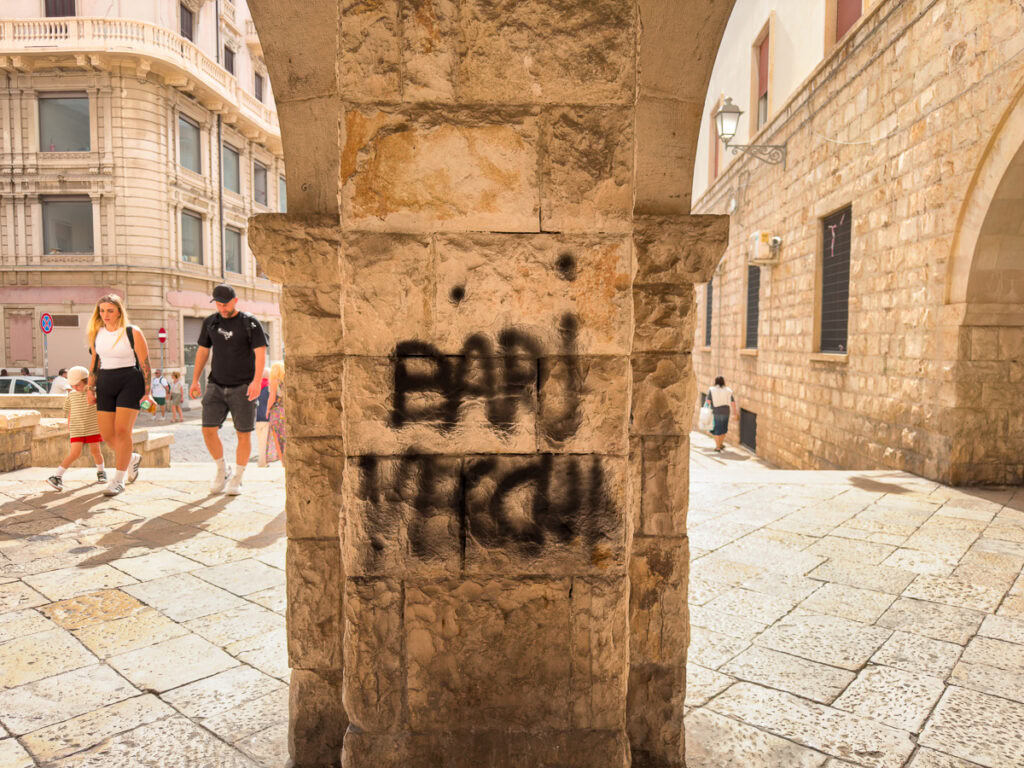
Things to do in Bari
- Top must do: A cooking class with a local!
- Get lost in the maze of Bari Vecchia
- Sample local cuisine on a street food tour
- Watch the fishermen sell their catch at Porto Vecchio
- Head up to the rooftop bar at Oriente Hotel for a sunset cocktail
- Visit Basilica di San Nicola, an 11th century church and the final resting place of Saint Nicholas (a.k.a. the real Santa Claus!)
- See the medieval Castello Normanno-Svevo di Sannicandro
- Take a walking tour, bike tour or rickshaw tour to learn about Bari’s varied history
- Or set sail for a small boat cruise with aperitivo to admire the city from the water
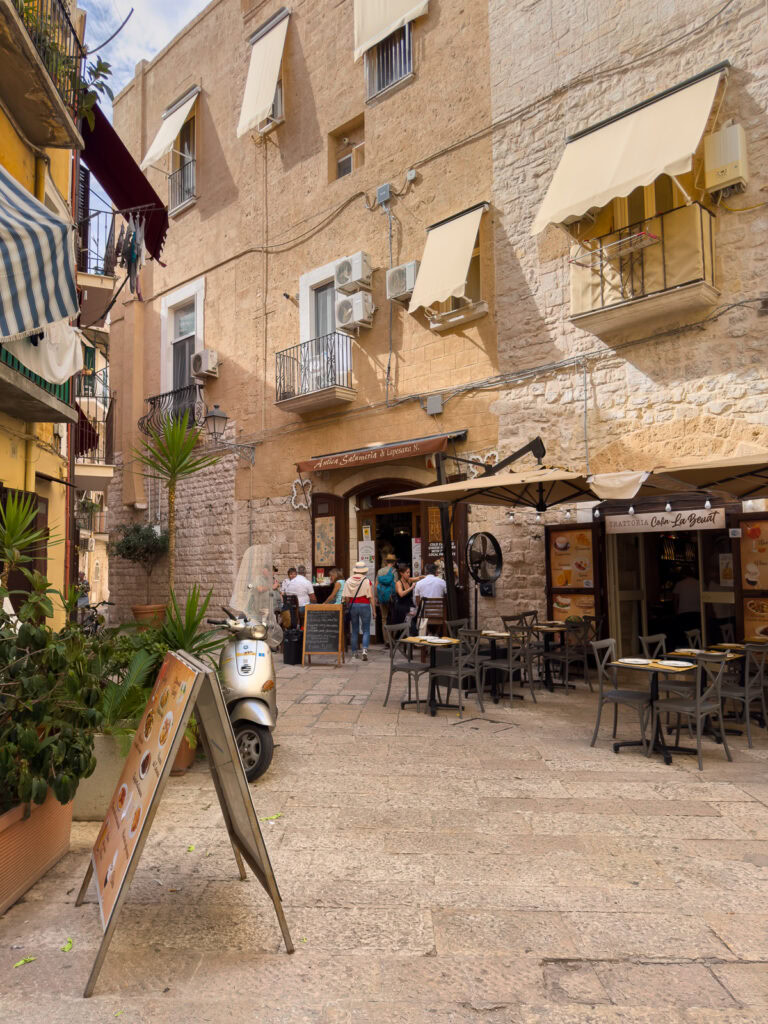
Where to stay in Bari
Budget
- Habari We Dorm is my top budget pick, they have simple dorms and cosy private rooms with a full kitchen, helpful staff and a super homely vibe
- Trulli & Case Fichi 3 (well-rated basic guesthouse in Bari Vecchia)
- C & S Cavour (cheap guesthouse right by the train station)
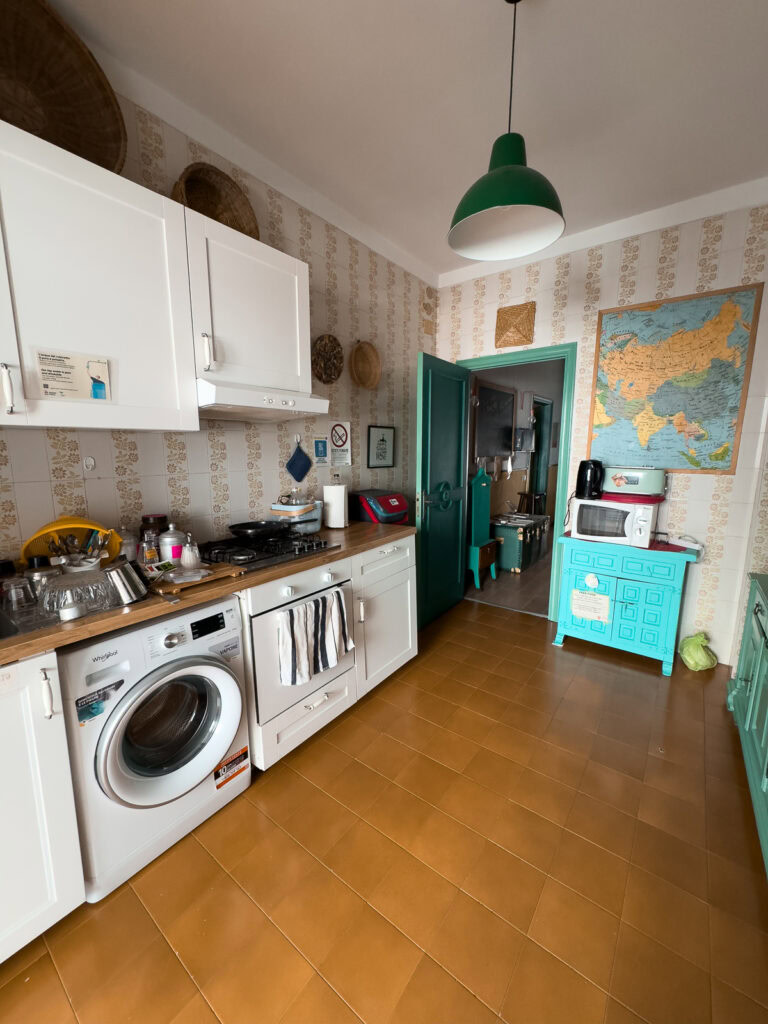
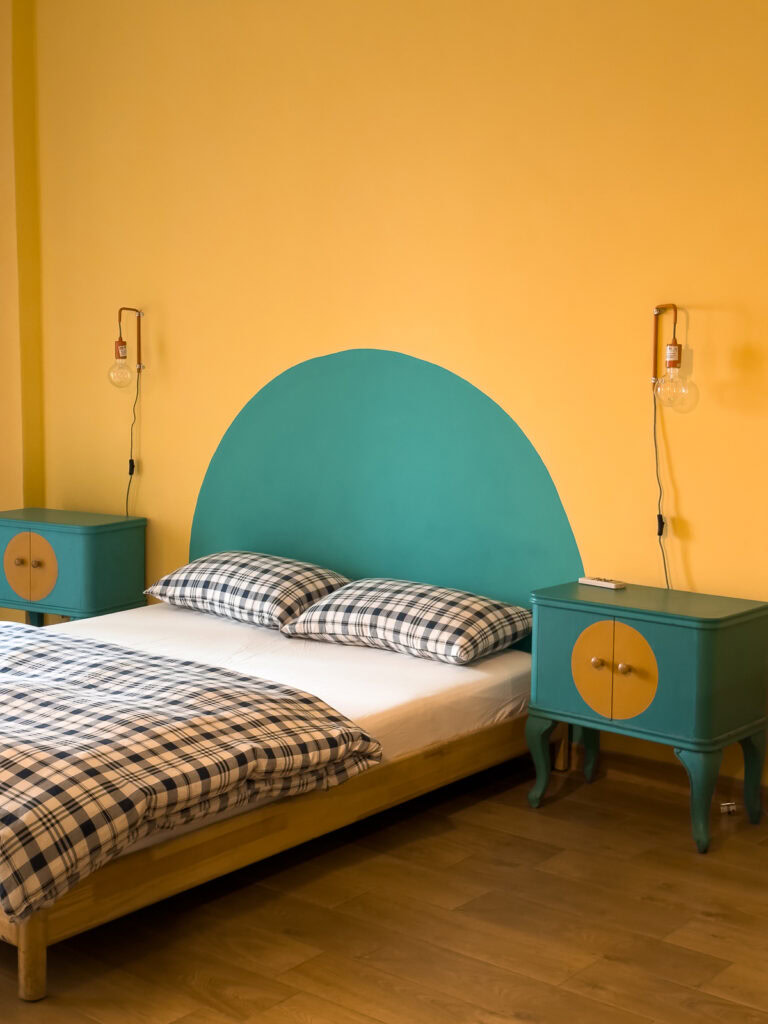
In-between
- Casa Maya is my go-to if you’ve got a bit more spending money, a true home away from home. A super comfortable newly-renovated guesthouse with access to a shared kitchen (extremely well-equipped, only one other room to share with), just a short walk from Bari Centrale.
- Timeless Apulian Luxury Suite (affordable apartment in Bari Vecchia)
- Casa dei Visionari (top-rated apartment steps from the water)
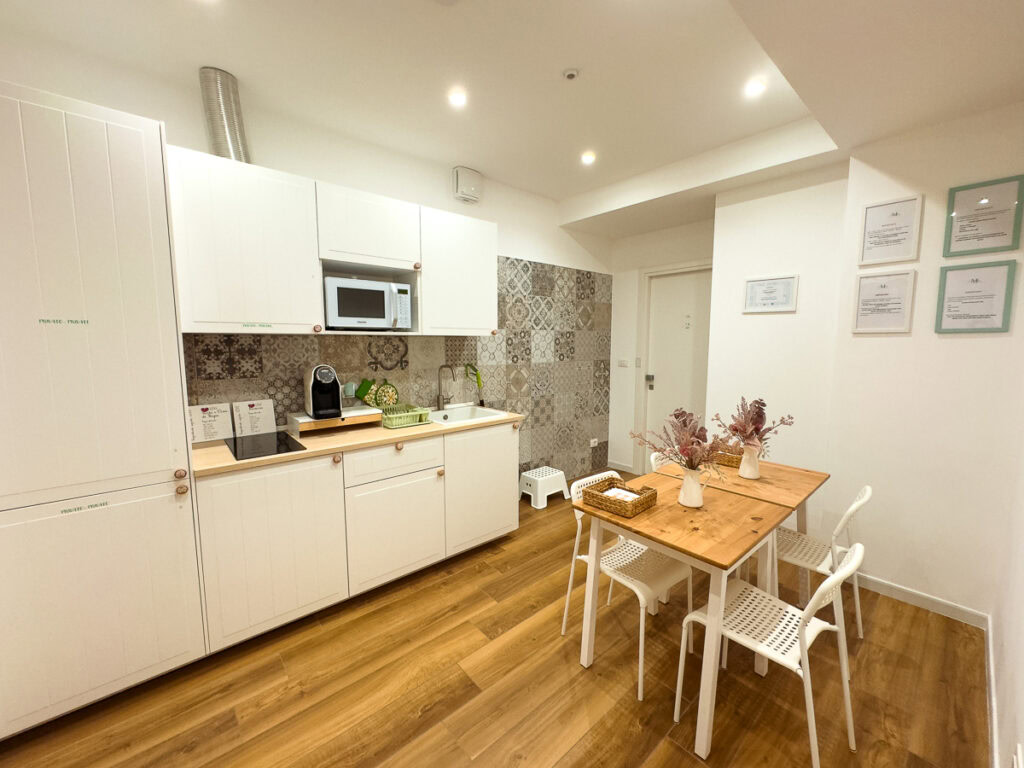
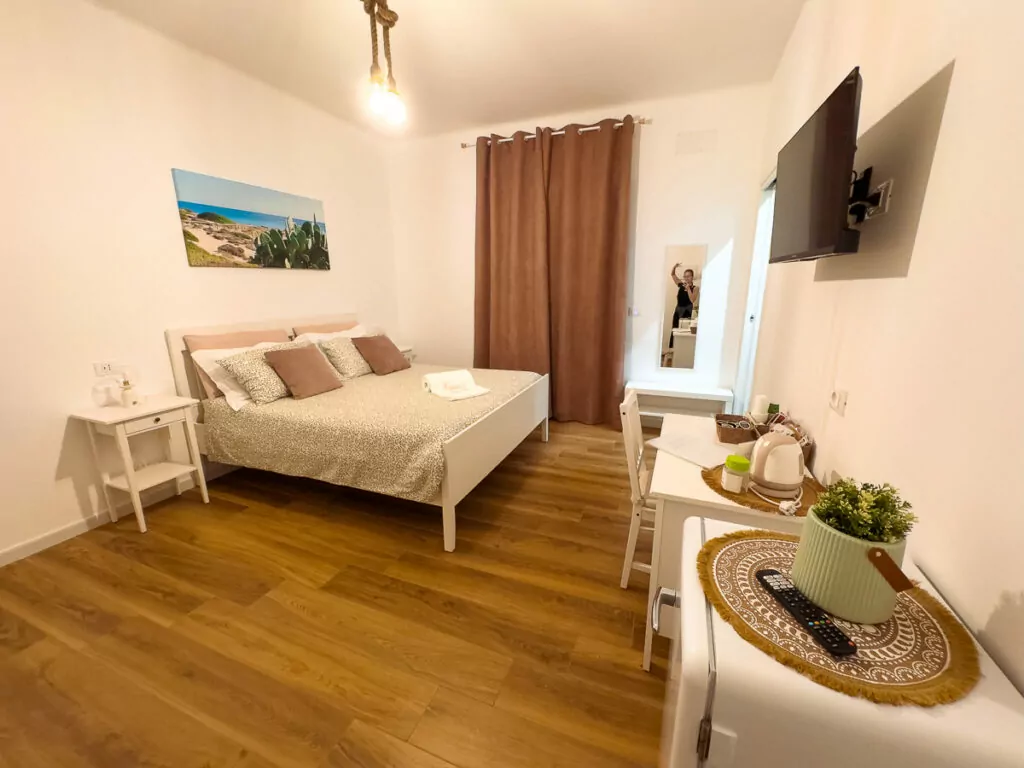
Luxury
- Bra Hotel (Bari’s only 5* hotel, opened in 2024 and has received brilliant reviews. Not cheap though!)
Matera
How to get from Bari to Matera without a car
- The easiest way is by bus, multiple operators service this route and the journey takes 1h to 1h 15m. You can find all the available buses and book tickets on Trainline.
- Buses leave from the bus stops behind Bari Centrale on Via Capruzzi, it’s not a very nice area at night so try and travel during daylight hours if you can help it
- There are a few different bus stations in Matera so make sure you know where you’ll be dropped off so you can organise how to get to your accomm
- There is also a private train company called Ferrovie Appulo Lucane who has trains from Bari to Matera, most of them require a change in Altamura but there is one a day that runs direct. These trains are separate to the national railway system so they don’t come up on Trenitalia’s website or other transportation apps, and they have their own section at Bari Centrale away from the normal platforms. The trains take around two hours so they’re longer than the bus, I don’t see why you’d want to use them haha but if you do you can check the timetables here.
- Matera isn’t well connected to other Puglia destinations by public transport so after your time here you’ll want to catch the bus back to Bari to continue your trip
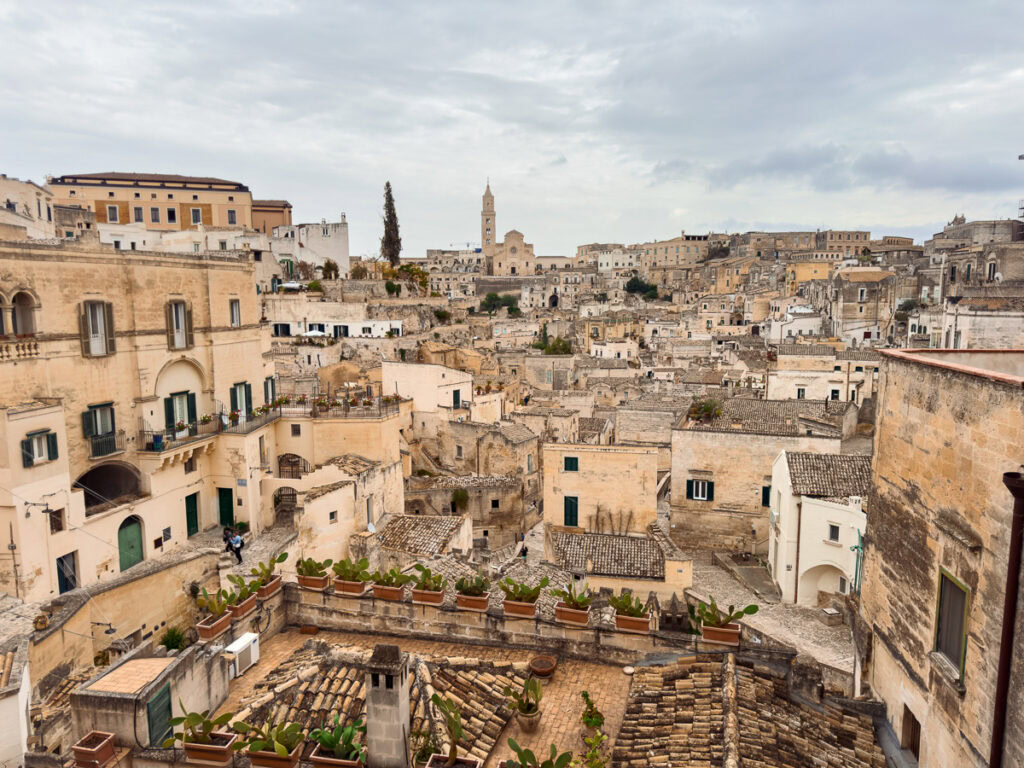
About Matera
Matera isn’t actually in Puglia, it’s just across the border in the Basilicata region, but it’s so close to Bari that it would be a crime to come all this way and not visit. How often do you get to wander 10,000 year old streets and sleep in ancient cave rooms?!
This city is genuinely like nowhere else I’ve ever been. I’m not reeeally a huge history buff (I like learning about it but I just prefer travelling for food, landscapes and experiences rather than stepping into the history books) but seeing Sassi di Matera with my own eyes honestly took my breath away. It’s hard to describe, you have to see it to believe it.
Matera’s cave dwellings have been occupied for millennia, making it the oldest city in Europe and third oldest in the world, and awarding it a spot on UNESCO’s World Heritage list. There are grand churches with frescoes to marvel at, luxury hotels and spas built into the rock, and plenty of terraces where you can relax with a glass of vino while you soak up the spectacular Sassi view.
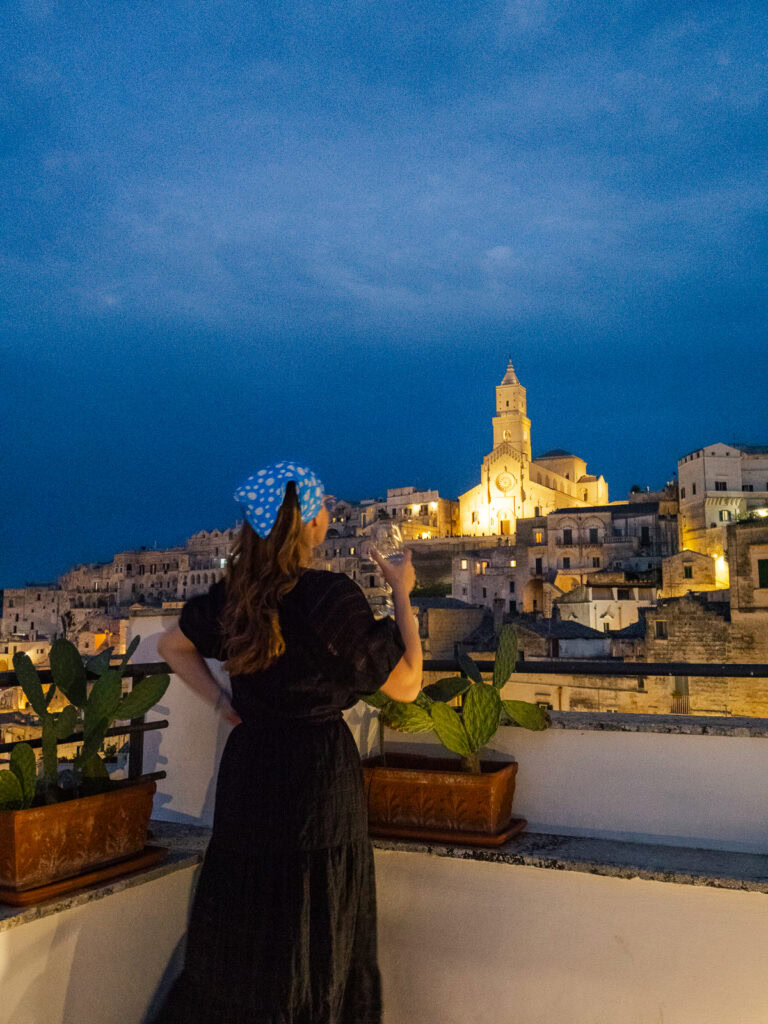
Things to do in Matera
- Join a walking tour around the Sassi, the best way to learn about the city’s ancient past
- Or enjoy seeing Matera at a faster pace with a panoramic tuk-tuk tour or this open top eco-bus
- Get a proper history lesson at Casa Noha, a short multimedia exhibit
- Find a terrace for sunset, watching the lights of Matera switch on as the sun goes down is something special
- Embrace the new travel trend of ‘set-jetting’! Matera was on the big screen in the James Bond film No Time to Die, and you can take a James Bond tour around the film locations.
- Eat the most insane sandwich I’ve ever had in my life (until I got to Alberobello, more on that soon), a pesto burrata prosciutto sandwich from Il Fiore del Latte! Yes, this is an entire pot of pesto dumped onto the burrata 😲 this sent me into a food coma but it was worth it.
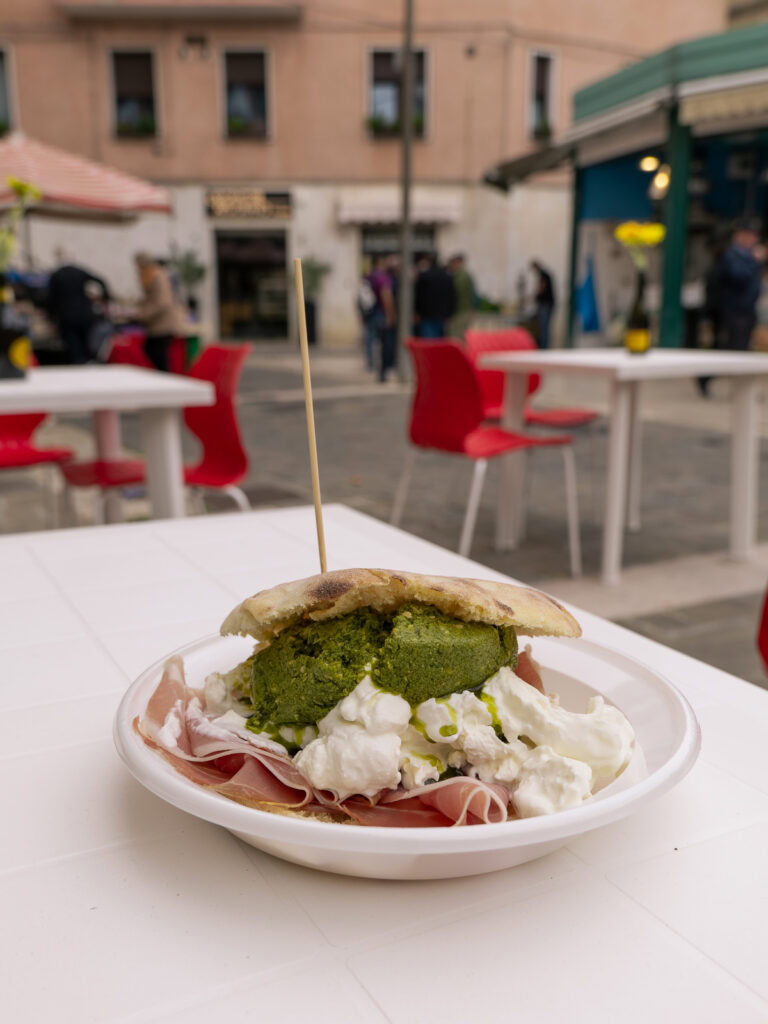
- If you’ve got time for a half day trip from Matera you could visit an olive grove for a tour and tastings or do a hike to the Gravina Gorge and to the Tibetan Bridge
- Please for the love of truffle can someone try this six course truffle tasting experience and report back to let me know how it is?! It wasn’t available when I was in Matera and I’m wondering if it’s worth coming allllll the way back for it (I’m leaning towards a yes).
- Treat yourself to a bit of pampering in a cave spa at Palazzo Gattini
- See Matera from a hot air balloon!
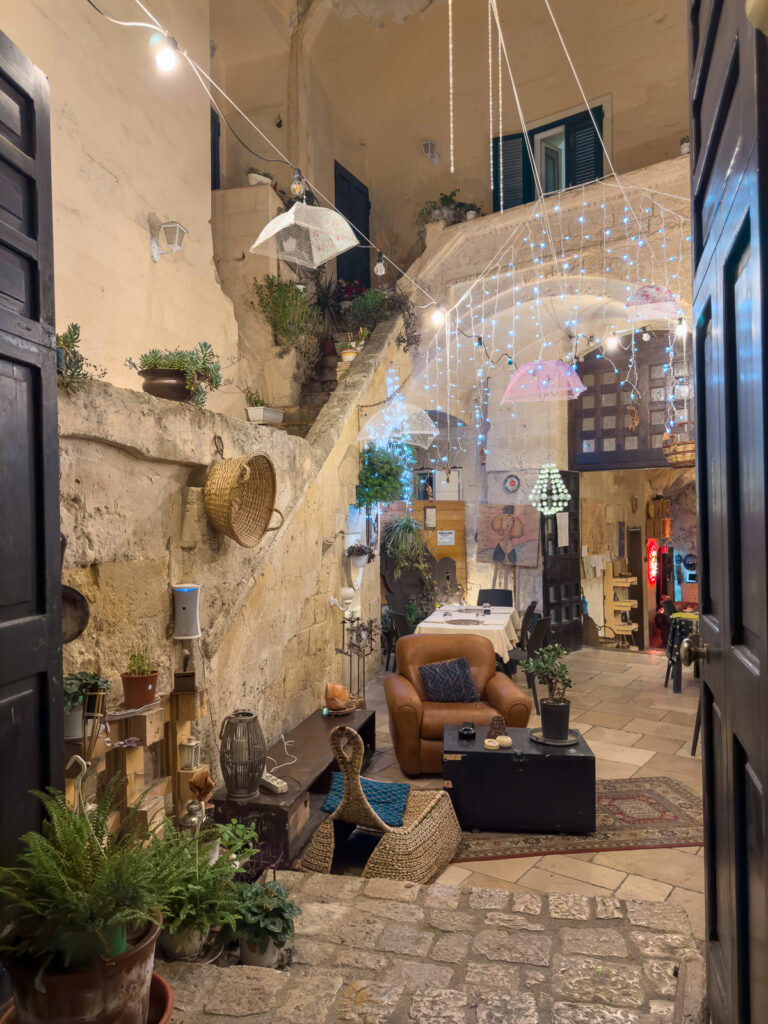
Where to stay in Matera
Budget
- The Rock Hostel (cheapest option in Matera, basic but has great reviews)
- Le Due Arcate (simple guesthouse with a kitchen, 20 mins from the Sassi)
- Myricae (top-rated rooms just a few blocks from Matera Centrale station)
In-between
- Lo splendore dei Sassi is BRILLIANT, I was so lucky to have stumbled across it. I stayed in the Deluxe con Terrazza cave room and I’d honestly say this has got to be the best terrace in all of Matera, high up for optimum viewing, it blew my mind.
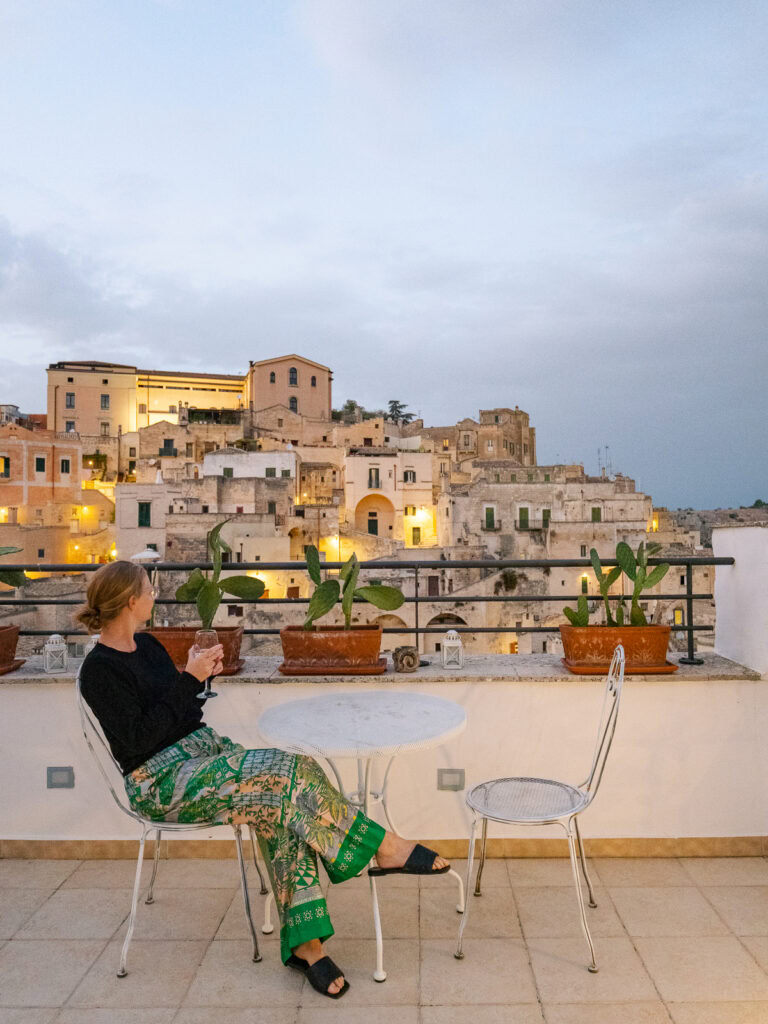
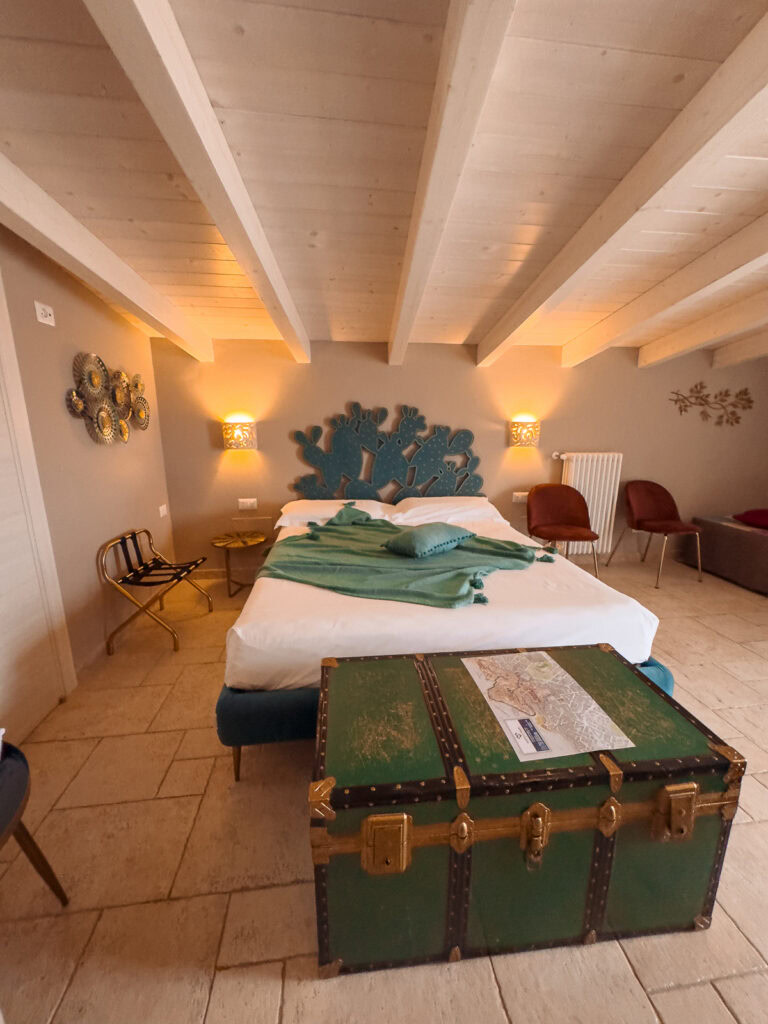
- Hotel Sassi (iconic 3* hotel with lovely views and a shared courtyard)
- Casa Festa Rooms (good value rooms, some have views of the ravine behind the Sassi)
- Giù nei Sassi (spacious apartment with Sassi views)
Luxury
- Palazzo Gattini (5* wellness hotel with old-fashioned interiors and a cave spa)
- La Suite Matera (modern 5* hotel with excellent reviews)
- Sant’Angelo, Matera (elegant rooms, some cave some not, with magical views)
- Quarry Resort (5* resort built into the rocks with an epic breakfast terrace)
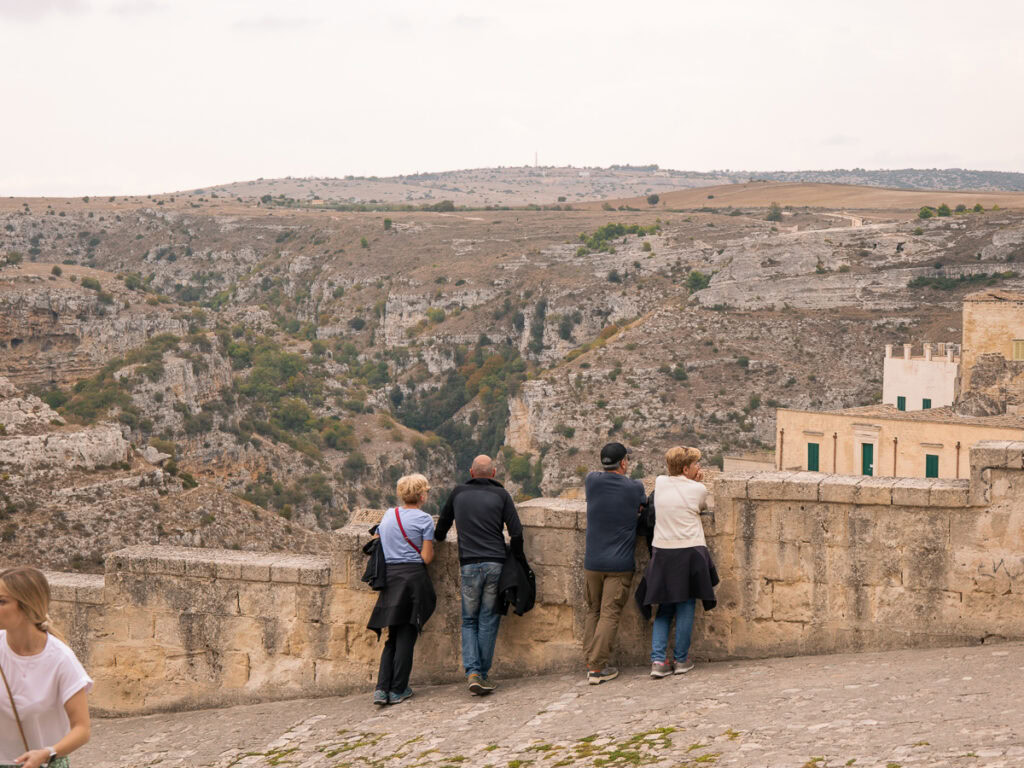
Monopoli
How to get from Bari to Monopoli
An easy direct train, the fast trains take 25 minutes and there are slower trains that take 35-50 minutes.
One thing to note is that the Monopoli train station is a 15 minute walk from the middle of Centro Storico (the old town), it’s a flat walk but the footpaths are annoyingly uneven so it’s not enjoyable if you’re rolling a heavy suitcase. Do as I say and not as I do, pack light!
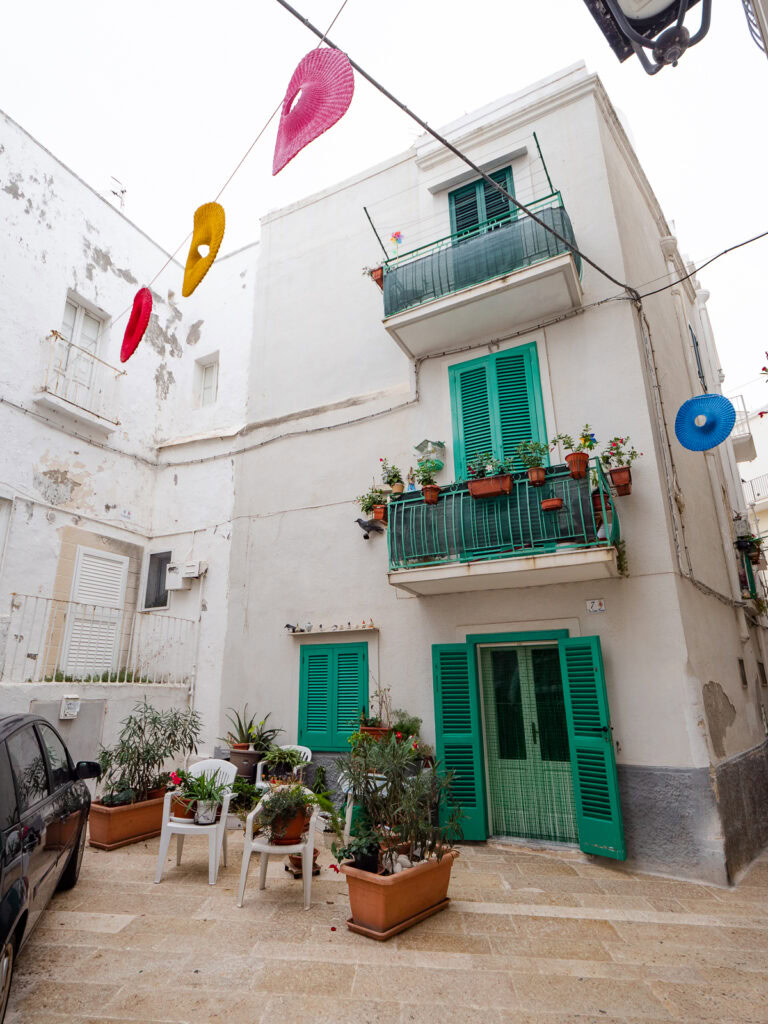
About Monopoli
This quintessential Puglian fishermen’s town is heavy on the charm, white houses with coloured shutters towering over narrow lanes, colourful fishing vessels floating in the harbour and rooftop terraces overlooking the Adriatic.
The historical centre is brilliant for map-free strolling, you’ll find cute boutiques, hole-in-the-wall eateries and local artists working on their next masterpiece in their workshop-turned-gallery. If you’re here for sun and sea, there are beaches galore! The ones close to the old town get busy (understandably) so your best bet without a car is to book a boat tour to hit some swim spots along the coast.
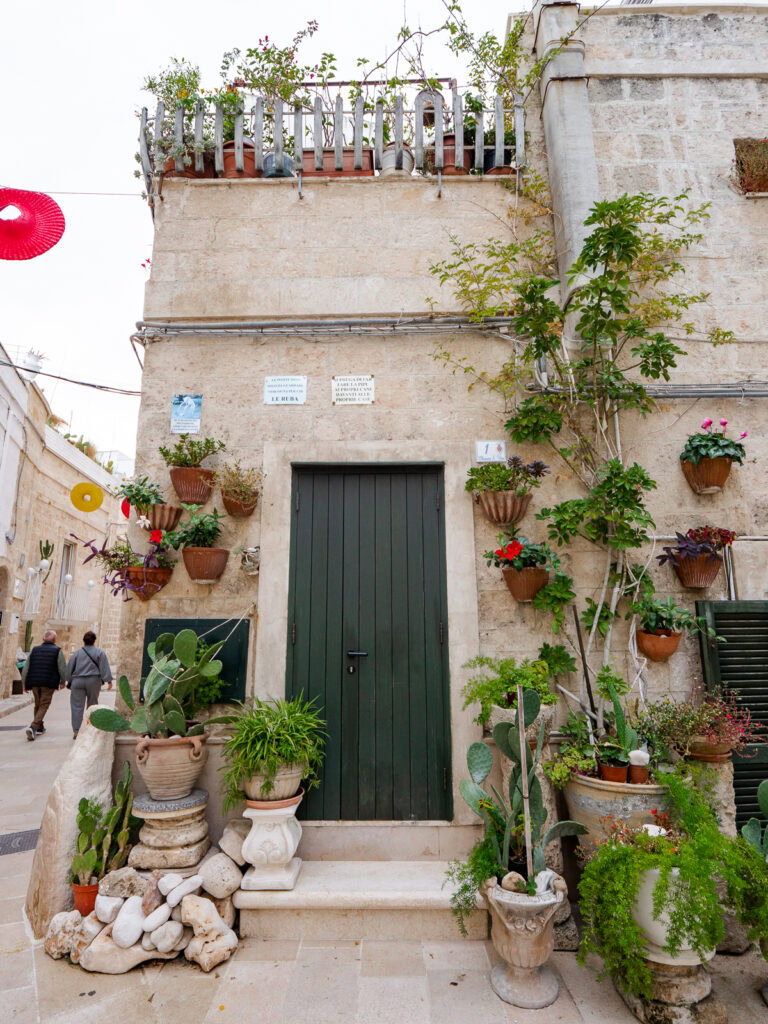
Things to do in Monopoli
- Download a good podcast or audiobook and take to the streets for some aimless wandering! The best parts of Monopoli are tucked down winding alleyways away from the touristy courtyards.
- Indulge in fresh seafood, Trattoria La Locanda dei Mercanti and La Locanda sul Porto are widely regarded as two of the best in town
- Marvel at the magnificent Basilica of the Madonna della Madia, the town’s 12th century cathedral
- Taste a range of local delicacies with a street food tour (yes, I will recommend a street food tour in every city in Puglia!)
- Jump on a boat tour, this 30 minute option is cheap and cheerful or go for a 2.5 hour trip including drinks and swim stops
- Get a true Monopoli experience with a fishing tour
- Enjoy an early morning SUP session on the water
- Get an understanding about Monopoli’s historical significant with a walking tour
- Order a scoop (or three…) of stracciatella from Il Capriccio and eat it by the sea
- Don’t miss The King Street Food for delicious and affordable meals!
- Admire the facade of the Church of Saint Vitus Martyr, a private family chapel decorated with vines and pot plants. My accommodation (more info below) was right next door!
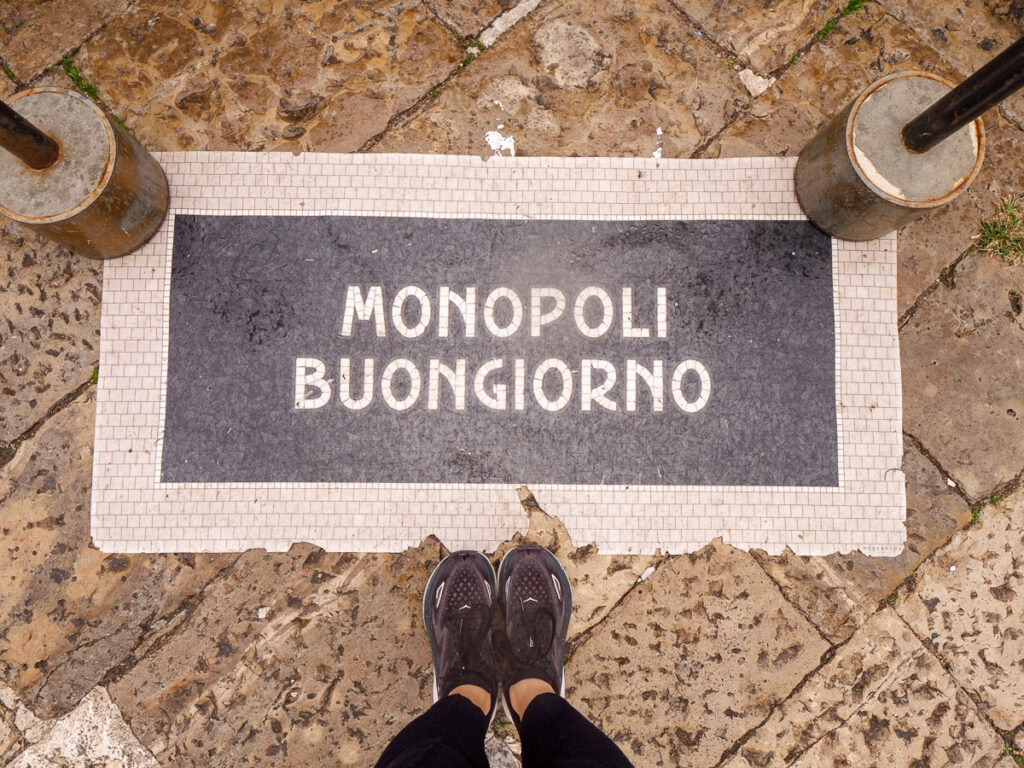
Where to stay in Monopoli
Budget
- Grotta San Vito is, and I cannot stress this enough, the best budget-friendly place to stay in Monopoli. It’s run by Mrs Franca who is the Nonna I never knew I needed! She speaks minimal English, I speak zero Italian, but somehow her hospitality transcends language barriers and though the room was basic, it is genuinely one of the most memorable places I’ve stayed. Ideal location too, unbeatable value for money.
- Appartamento Gioberti is another well-rated cheap option if Grotta San Vito is booked

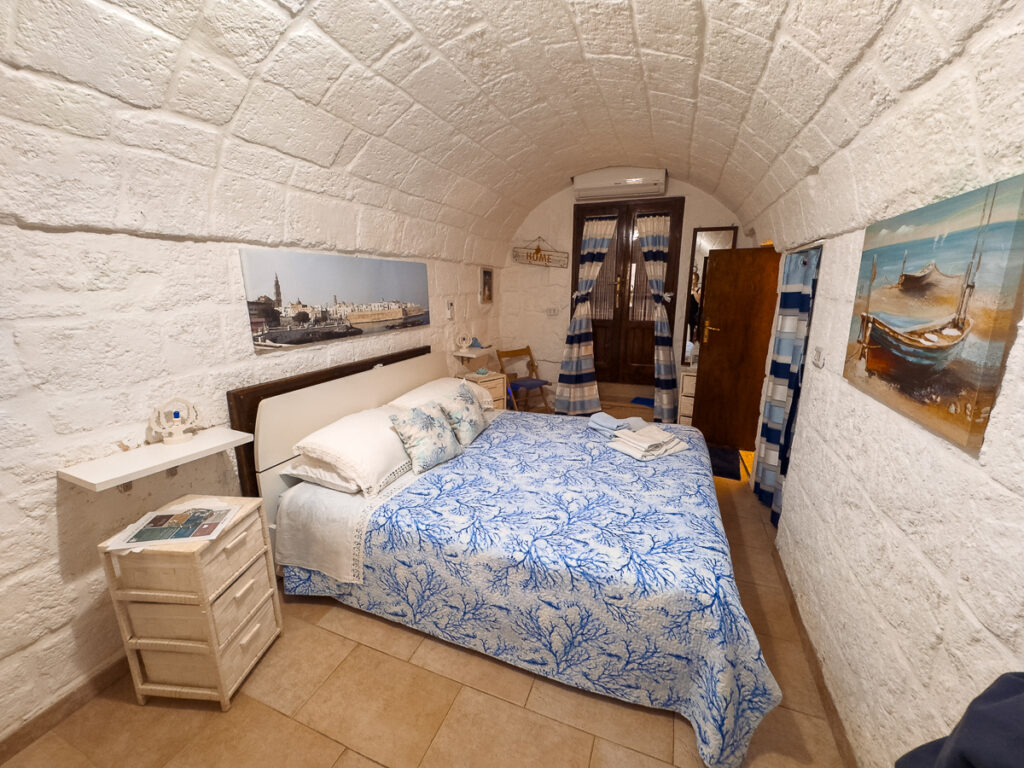
In-between
- Casa Roberto is also managed by Mrs Franca, with a slightly bigger/brighter/more modern room
- B&B A C-Caste (top-rated minimalist but stylish rooms)
- Dimora Minelli Suites (clean and comfortable rooms right by the train station)
Luxury
- Hotel Don Ferrante (5* luxury hotel on the water)
- Palazzo Manzoni (beautifully designed luxury apartment)
- Suite & Spa Via Veneto (romantic stone apartment with a sauna and a jacuzzi in the lounge)
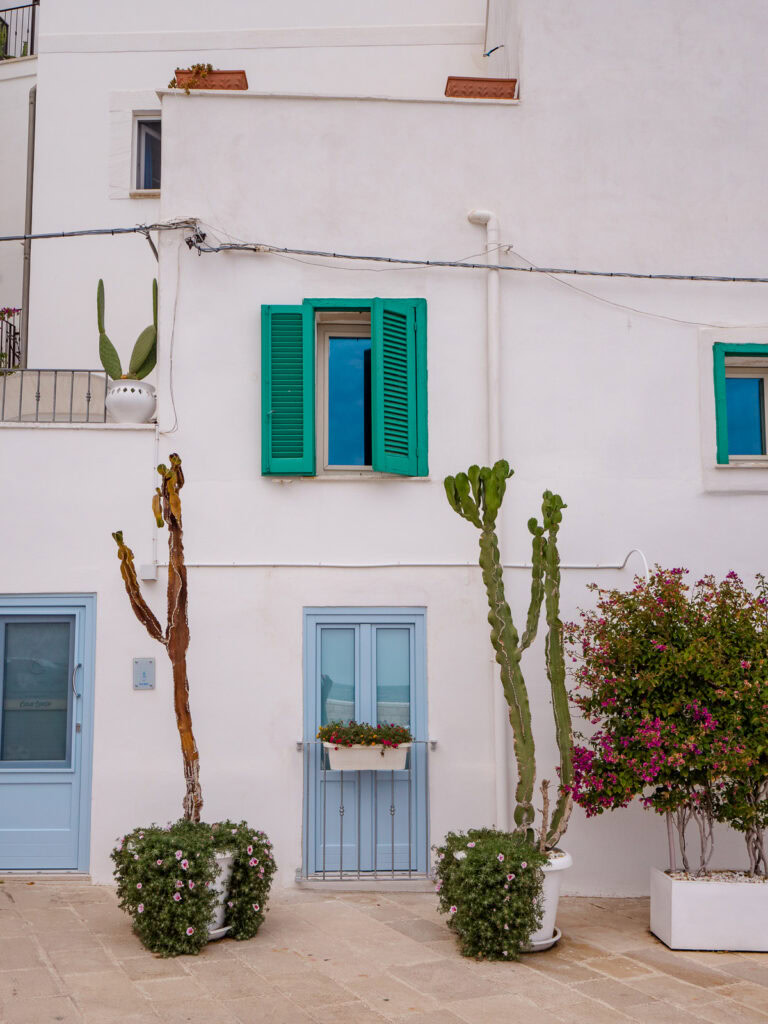
Polignano a Mare
How to get to Polignano a Mare
Polignano a Mare is just five minutes from Monopoli by train or 30-45 minutes from Bari, both run frequently. Some trains from Bari to Monopoli will stop in Polignano a Mare but the high speed trains might skip it, so be sure to get on the right one.
About Polignano a Mare
Known for its whitewashed old town perched above craggy rocks, with cliffside terraces overlooking hidden beaches and (not-so-)secret cave restaurants, Polignano a Mare is the most popular day trip destination along the Puglian coast.
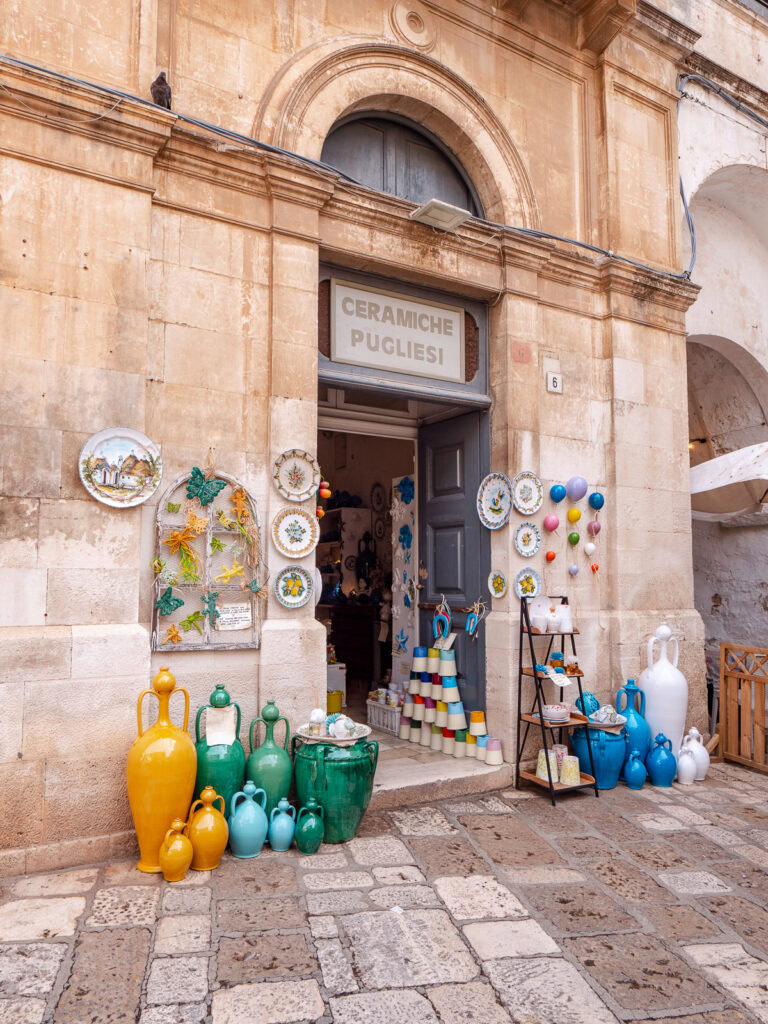
Accommodation here is quite limited so most people stay in nearby Monopoli or even further afield in Bari or elsewhere, then they get here by train and head to the buzzing old town for a hearty lunch, refreshing scoop of gelato and a spot of shopping, before cooling down at Lama Monachile, the most recognisable beach in Puglia.
If you manage to snag a coveted night staying in the historical centre, you’ll be able to experience real Polignano a Mare away from the tourist crowds once they leave in the early evening. See where locals eat, enjoy some local wine at a hidden wine bar, and then have a wake up swim before the day’s bus tours arrive.
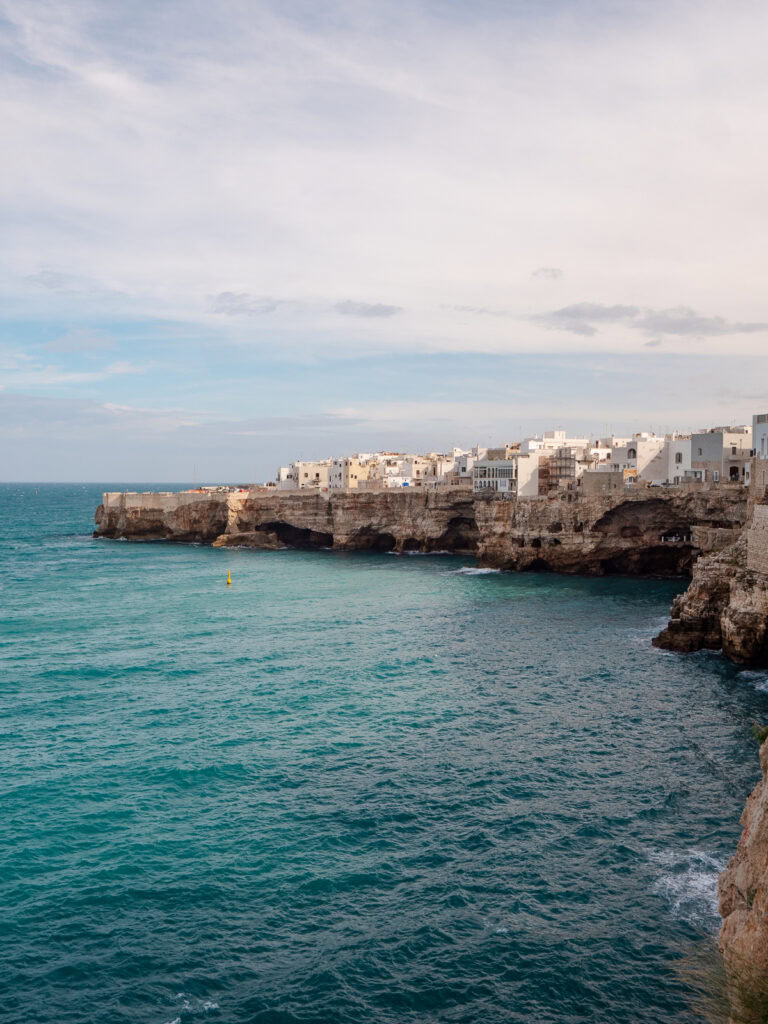
Things to do in Polignano a Mare
- Swim! Polignano is the perfect place for time in the water, with looooads of boat tours running travellers along the coast to see sea caves and jump in for a dip or five
- For something a little fancier you could opt for a catamaran tour with aperitif included
- A street food tour, duh
- A tuk-tuk tour along the coast
- Scuba dive to see Puglia below the surface, you don’t have to be certified with this tour so it’s great for beginners
- Learn to make orecchiette at a cooking class
- Join an e-bike tour from Polignano a Mare along the rocky coast to get to the fishing village of San Vito
- This is where you’ll find the famous Grotta Palazzese cave restaurant, but I can’t recommend it to you because it is wildly expensive and the food is apparently very sub-par. You can see it from this viewpoint though!
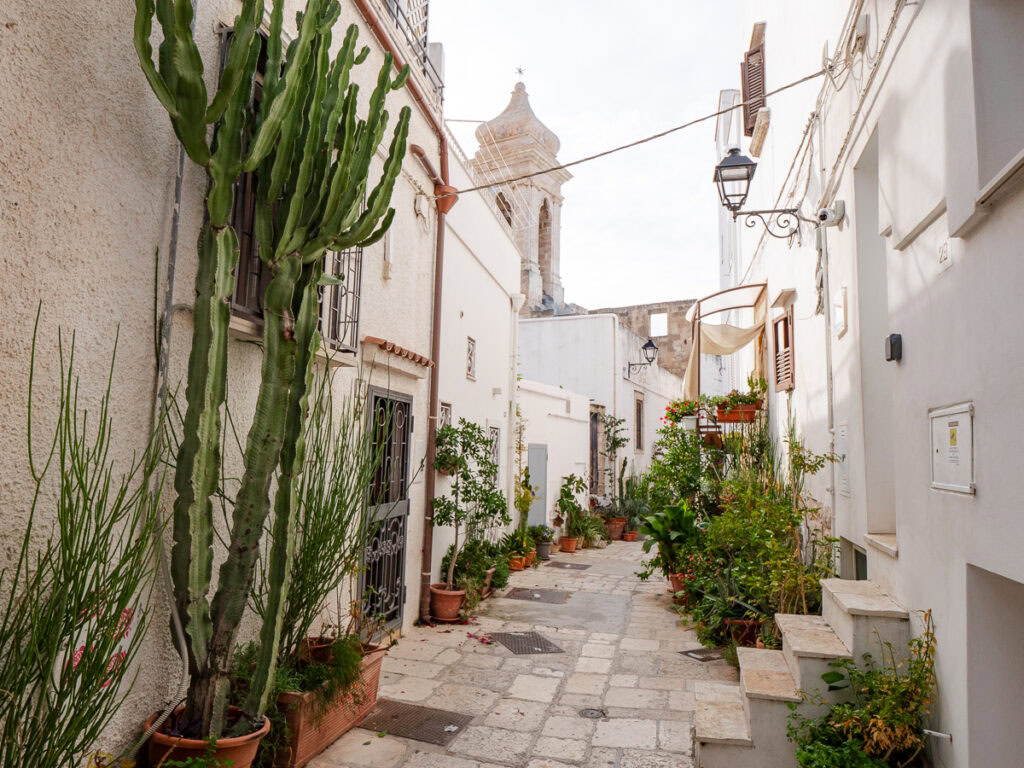
Where to stay in Polignano a Mare
Budget
- Casa Filomena (cheap and cosy guesthouse)
- Petali Rosa Dimora Sirene (affordable guesthouse with a rooftop terrace)
In-between
- B&B Casa Laforgia Soffio Mediterraneo (guesthouse with spacious rooms close to the train station)
- Trame – La Naca sul Porto (top-rated apartment in the old town)
- L’Arco Antico (cute and comfy guesthouse with fantastic reviews)
Luxury
- San Michele Suite (boutique suites with incredible views)
- Sei Stelle Mama (stylish design rooms with a shared terrace)
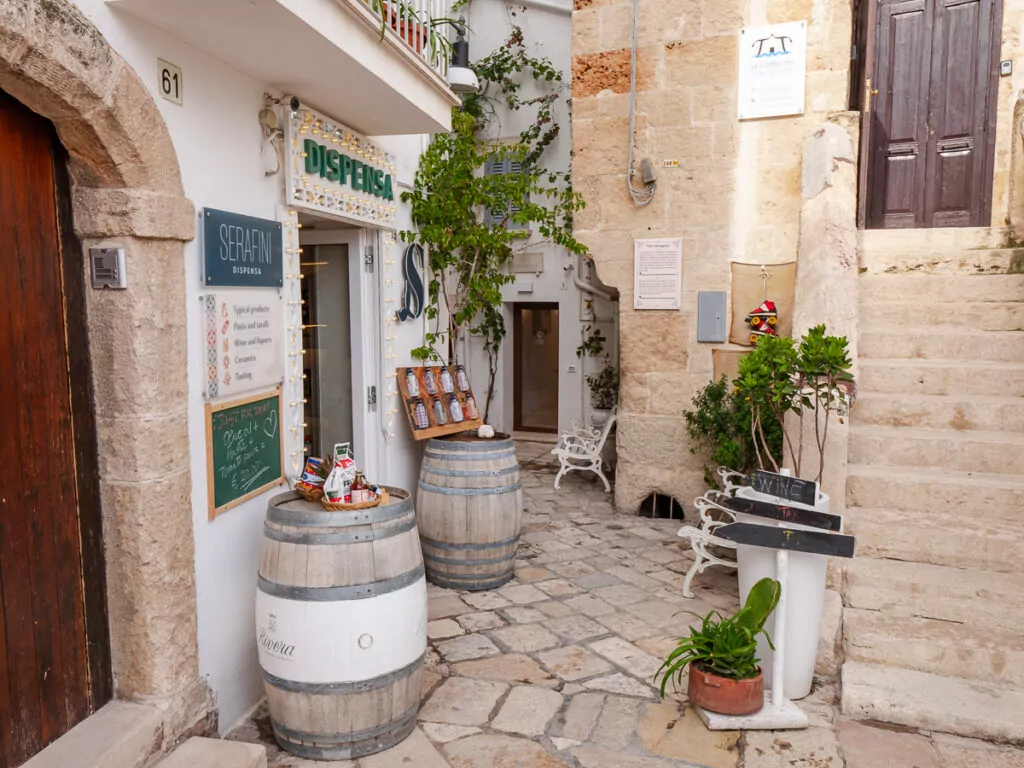
Alberobello
How to get from Monopoli to Alberobello
This is one route where the info online is very confusing!
There is a 55 minute direct bus that runs three times a day from Monday to Saturday, it’s bus #584 operated by Lentini, it shows up on Google Maps but doesn’t show up on any other transport apps. You can search the timetable and buy tickets here >>
If those bus times don’t work for you there are lots of easy one-change options throughout the day that end up taking about 1.5h.
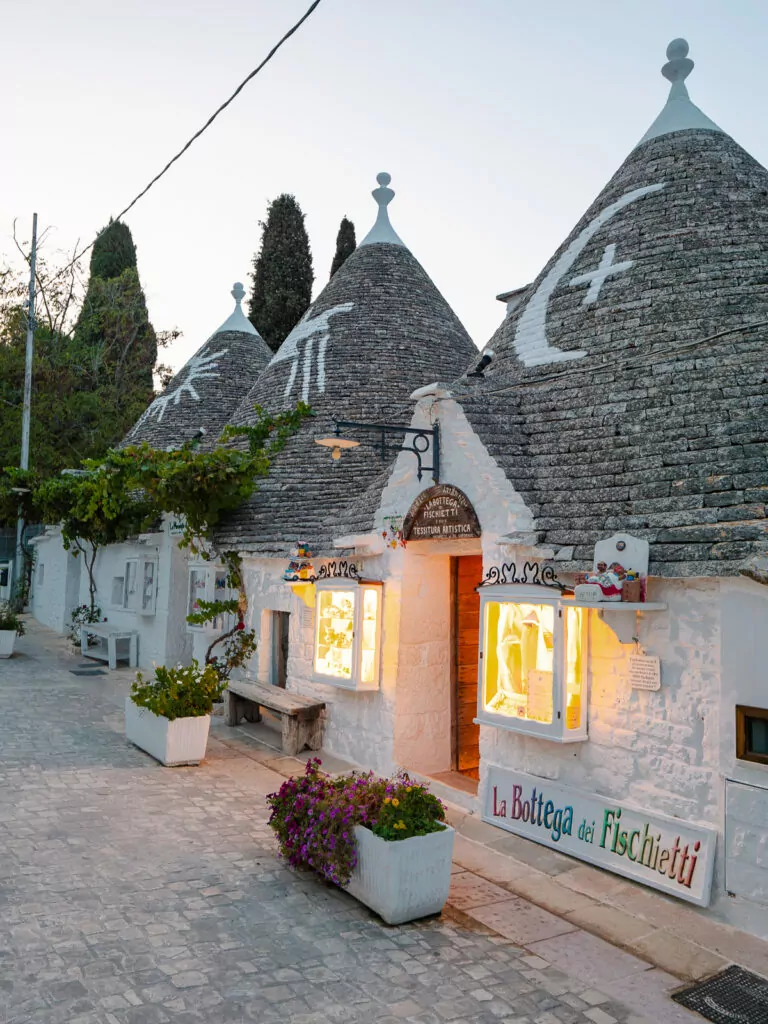
About Alberobello
This place is a fairytale, I know that’s a bit of a travel cliché but there is no other way to describe it! Quirky trulli houses are stacked up the hillside, retailers sell local handicrafts and regional delicacies, and cats roam the cobblestone streets looking for a cosy resting place, like a souvenir shop shelf…?
It’s touristy for sure, it’s a gem that’s no longer hidden, but despite the day trips crowds it is 1000% still worth a visit.
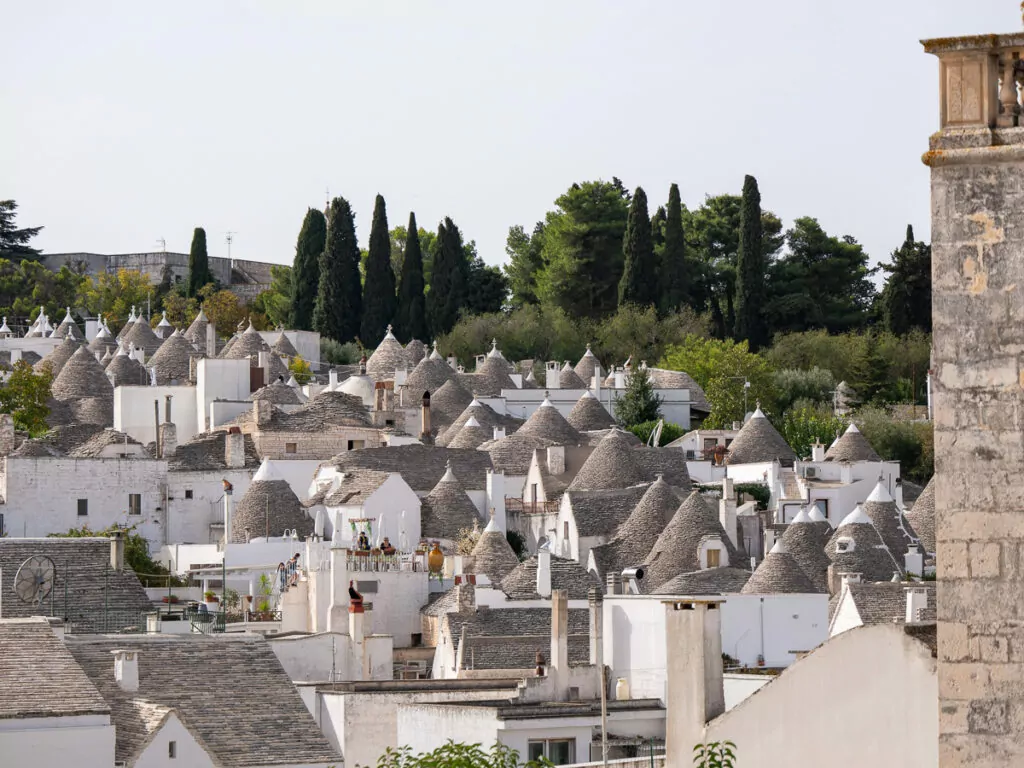
Things to do in Alberobello
- A trip to Alberobello wouldn’t be complete without sleeping in a trullo! The oldest ones in town date back to the late 14th century, but many of the ones available to rent have been modernised with comforts like air con
- Wander the streets of Rione Monti, the main trulli area where you’ll find loads of shops, restaurants and bars
- But head over to Via A. La Marmora to experience a more authentic residential neighbourhood, just be respectful (i.e. don’t be loud, don’t step onto doorsteps or private property, don’t take photos of locals without their permission)
- Take a tuk-tuk tour with an audio guide to learn about the region
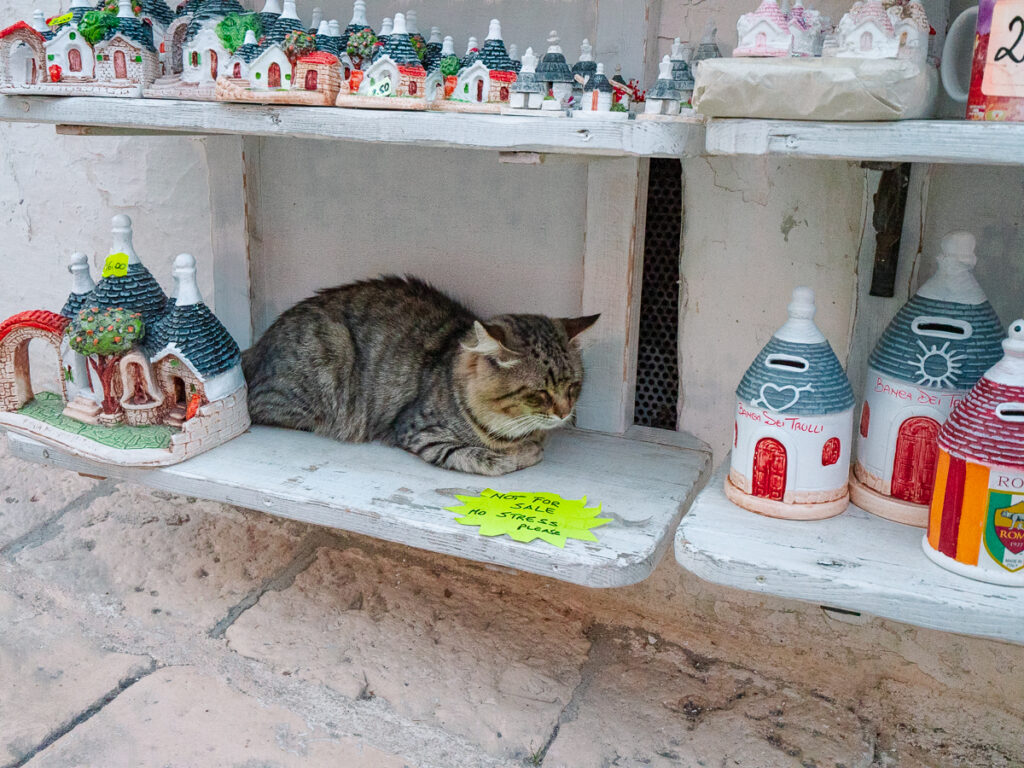
- See the sea of trulli from the Vista Panoramica dei Trulli viewpoint (Google Maps link here)
- Learn about the history of Alberobello and its unique architecture at Trullo Sovrano
- My pesto burrata sandwich in Matera was short-lived sitting at the top of my best-sandwich-ever list, because MaDó Filoneria Pugliese came in strong with a braised beef, rosemary potato and gorgonzola sandwich which climbed up to share the number one spot. DO NOT MISS THIS PLACE.
- Other delicious food I had in Alberobello was truffle carbonara at Corte dei Trulli (10/10), a farmer’s brunch plate at Cosi Com’era and ‘Focapizza’ (if focaccia and pizza had a baby) at La Lira Focacceria
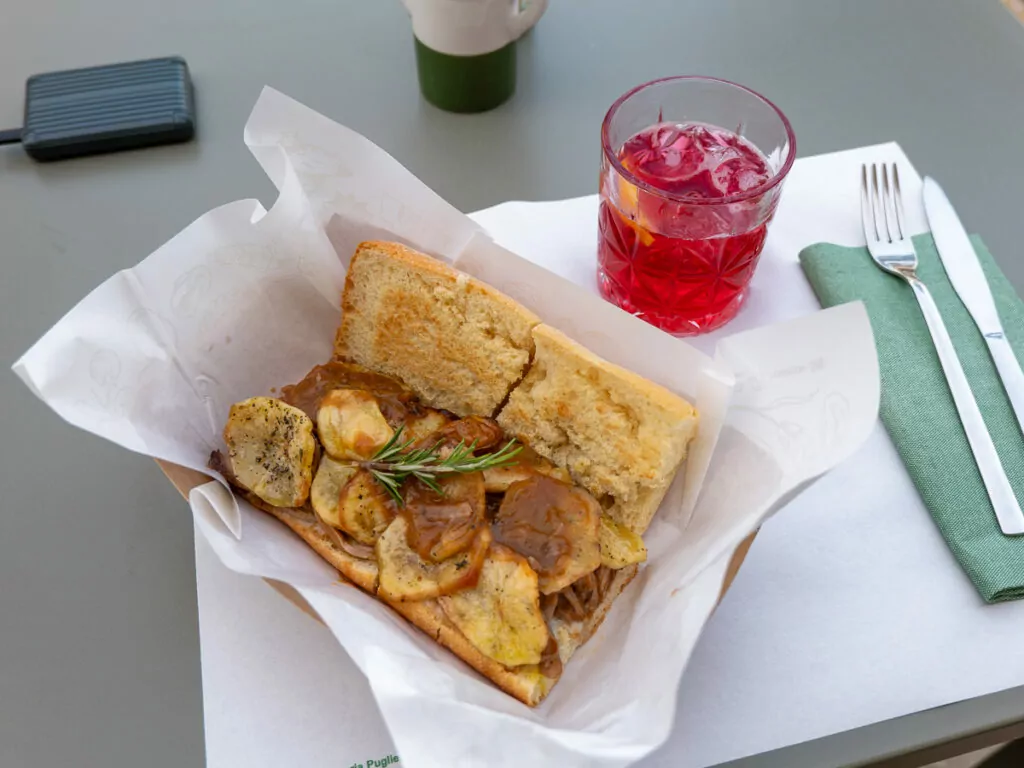
Where to stay in Alberobello
Budget
- La Casetta di zia Giuseppina (one of the cheapest trulli houses in town)
- B&B Pentagramma (budget-friendly B&B close to public transport)
- Dimora Panoramica (affordable apartment with a terrace overlooking the trulli)
In-between
- I stayed at Trullieu Guesthouse Alberobello, it was a simple and affordable trullo in a quieter part of town. Perfect!
- San Marco Boutique Rooms (design hotel in the middle of Alberobello)
- Trulli Antichi Mestieri (traditional trullo with top reviews)
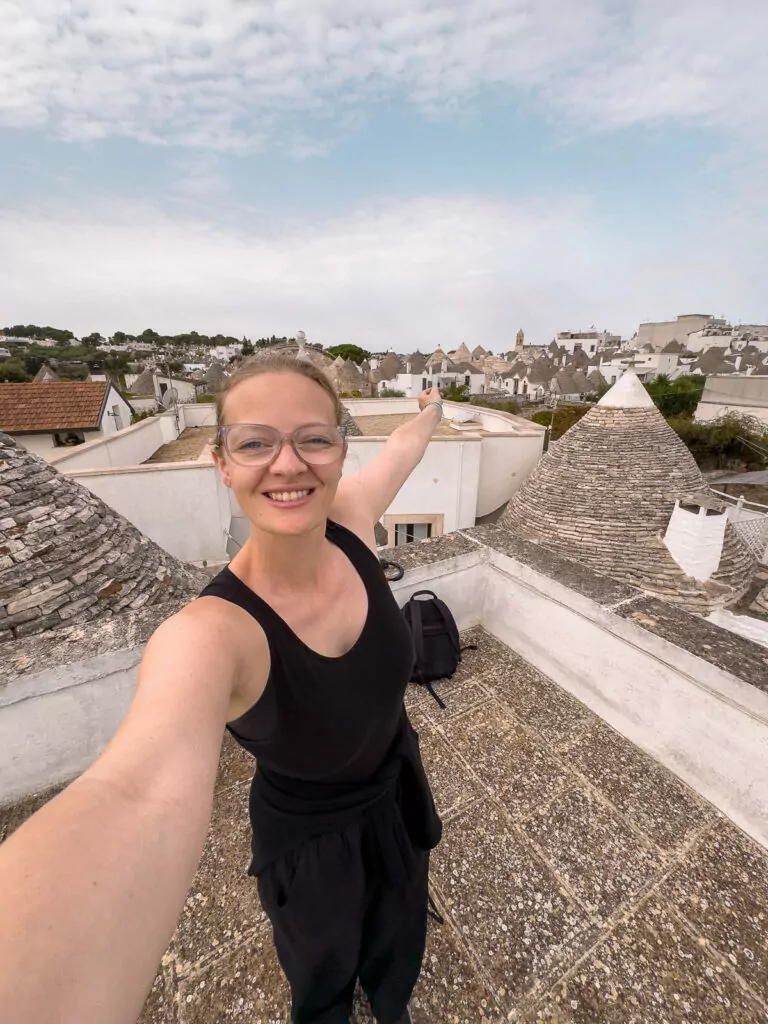

Luxury
- Trulli e Puglia Luxury Suite (romantic trullo with a hot tub)
- Trulli Resort (the best of both worlds, trulli with beautiful interiors set on a semi-rural property with a pool and olive trees, still walkable to the main Trulli Zone)
Alternatives/add ons to Alberobello
Locorotondo
Locorotondo is just 10 minutes from Alberobello by bus, it has lots of trulli houses dotted around the outskirts but the historical centre is best known for its tall, narrow buildings with steeply-pitched rooftops, called ‘Cummerse’.
Prices here are generally cheaper than Alberobello, there are a few trulli near the bus stop so if you’re on a budget it might suit you better than being in Alberobello itself.
Some accommodation options:
- CivicoDodici or La Dimora nel Borgo for a good value apartment
- Bella Itria for a traditional stay in the Centro Storico
- Trulli Manuela 2 for a cheap trullo near the bus stop
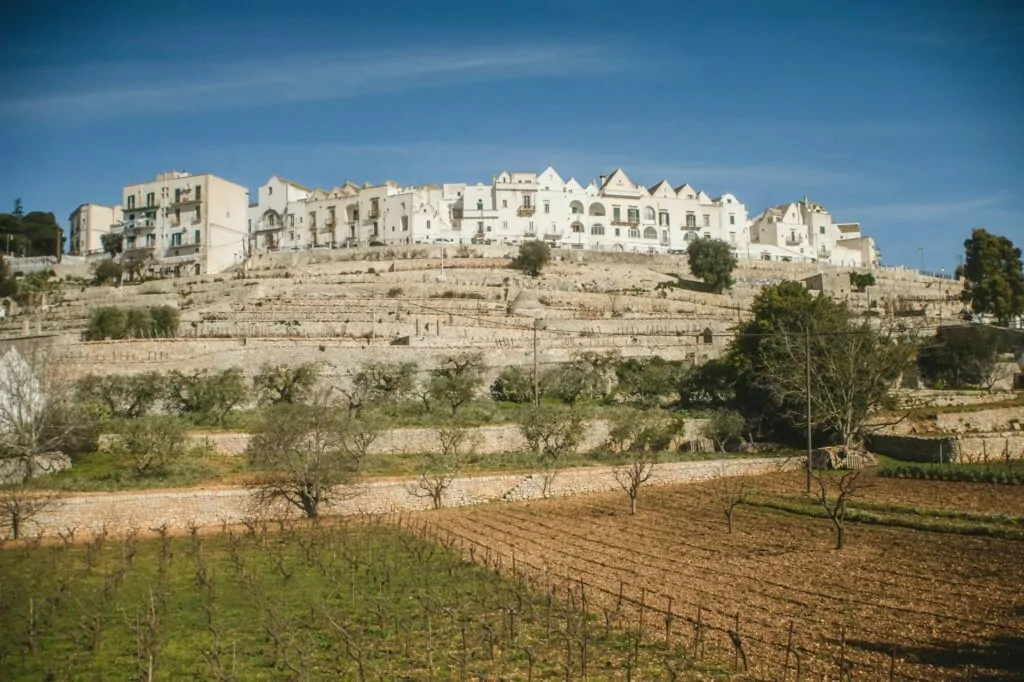
Cisternino
Another low key, laidback option for an Itria Valley stay is Cisternino, probably the least touristy easily-accessible village in Puglia! It feels like a mini Ostuni, the Centro Storico is impossibly charming and there’s an endless selection of restaurants that’ ‘ll keep you satisfied.
A bus connects Locorotondo with Cisternino in 15-20 minutes.
Some accomm options:
- La Lanterna and DeaDomus 55 and both excellent value budget options
- La Casa di Alice is a top-rated one-bedroom apartment in the centre of the old town
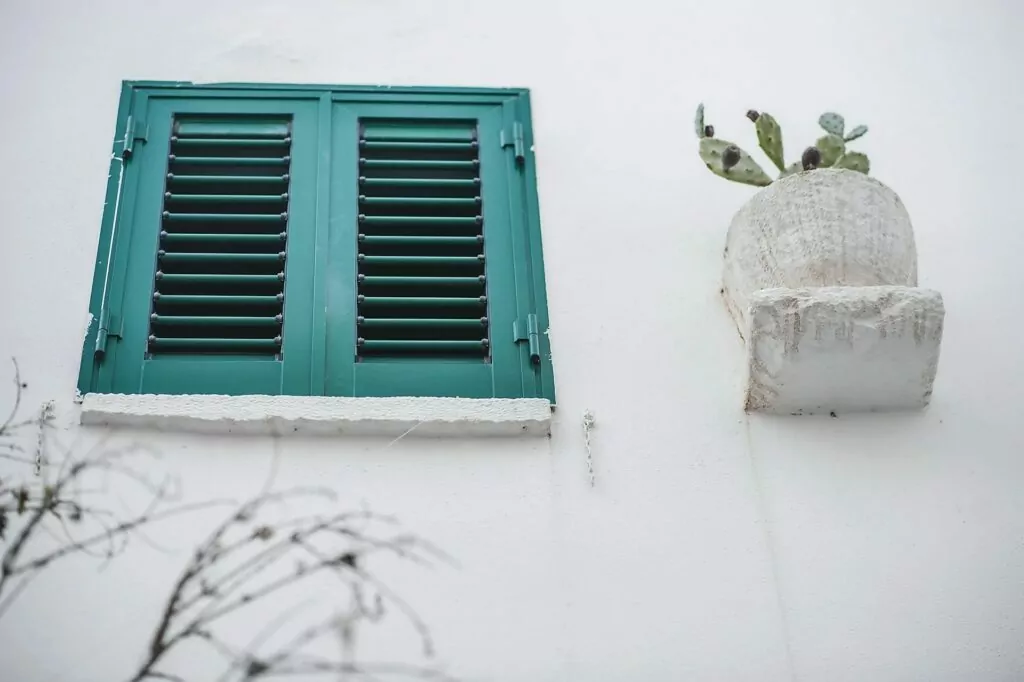
A rural Masseria
If you’ve got room in your budget for a taxi into the countryside, there are looooads of masserie (traditional farmhouses) dotted around the Itria Valley offering the most authentic Puglian hospitality experience you can find.
Options range from rustic agriturismo which are more affordable, to renovated trulli with lush gardens and olive groves, to luxurious properties straight off the cover of Architectural Digest.
Some noteworthy masserie to consider are:
- Masseria Marzalossa (understated but stylish interiors and a lush pool)
- Masseria Celeste (trulli masseria with lots of little details)
- Masseria Borgo San Marco (beautiful countryhouse with a lagoon-style swimming pool)
- Masseria Brigantino (frozen in time on the outside, comfy and homely on the inside)
- Masseria Torre Maizza (world-class 5* masseria if you’re looking to splurge)
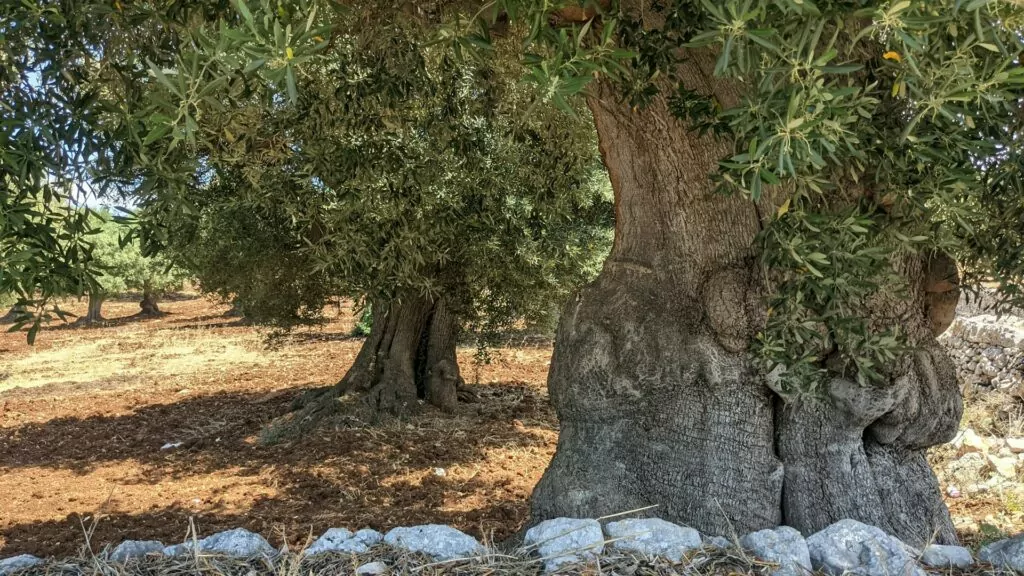
Ostuni
How to get from Alberobello to Ostuni
Another route that has lots of incorrect info online. Some options to look into:
- This TripAdvisor thread says there’s a direct bus from Alberobello to Ostuni as of August 2024 but this is incorrect. I asked the information centre in Ostuni, they had never heard of a direct service, and it doesn’t show up on Google Maps or any other transport app or website.
- If you’re visiting in the warmer months (June to October definitely at least, they might extend the schedule either side), you can catch a two-bus journey with a stop in Martini Franca. The Alberobello to Martina Franca bus runs every two hours, but the Martina Franca to Ostuni bus only runs three times a day so you need to line up the times. Rome2Rio is a good starting place, but you’ll want to confirm the schedules with the bus operators in case of any changes.
- When I spoke to the information centre, they were hesitant to recommend the journey via Martina Franca because it’s mostly used by locals rather than tourists, and there’s not much room for error (e.g. miss the last bus and you’re stuck in Martina Franca for a night!). Their recommendation was to catch the train from Ostuni to Monopoli (10 min bus to Ostuni train station, 20 min train to Monopoli) and then catch the direct bus from Monopoli to Alberobello. That sounded even more confusing to me, so I stuck with the Martina Franca option and it was totally fine.
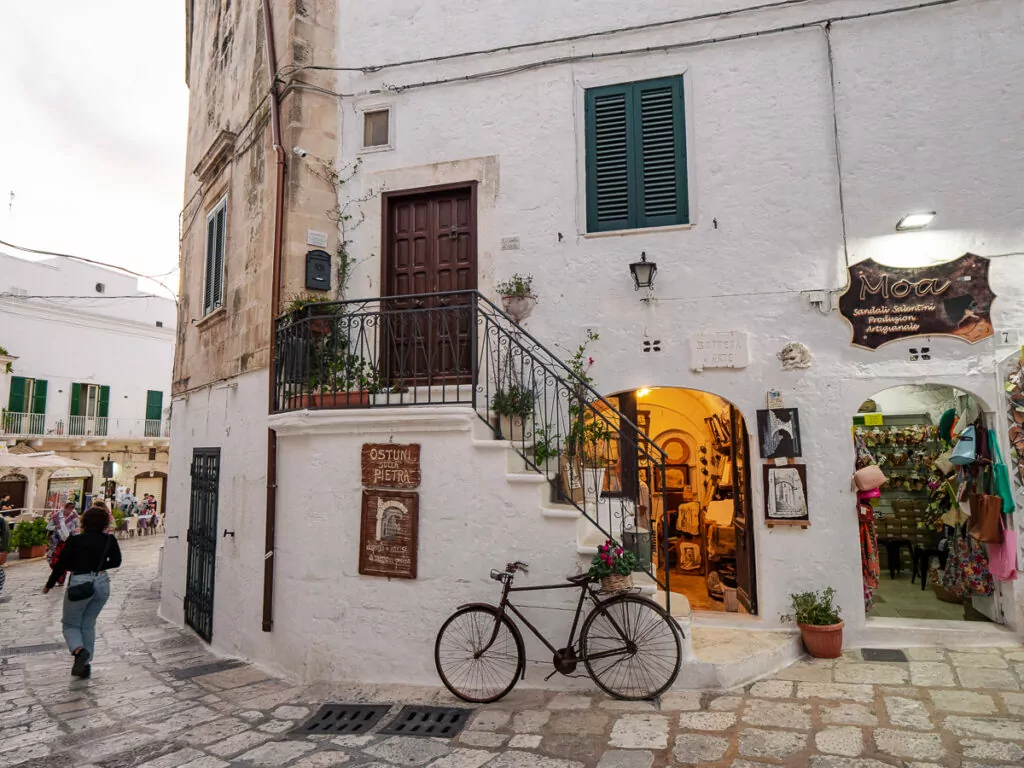
About Ostuni
Ahhh Ostuni has a piece of my heart ❤️ This is the official White City of Puglia, claiming that moniker despite the fact that there’s more than a handful of white-washed Puglian towns. I’m not going to argue!
It doesn’t have the hustle and bustle of Bari, the rocky beaches of Monopoli or the Smurf-like architecture of Alberobello, but it would be a mistake to leave Ostuni off your Puglia itinerary, especially if you’re a foodie or love an evening drink with a view.
Piazza della Libertà and the main streets of the Centro Historico receive their fair share of tourist attention, but wander a few streets beyond those and you’ll find hidden wine bars, bargain salumeria and panoramic viewpoints overlooking ancient olive groves stretching all the way to the Adriatic Sea.
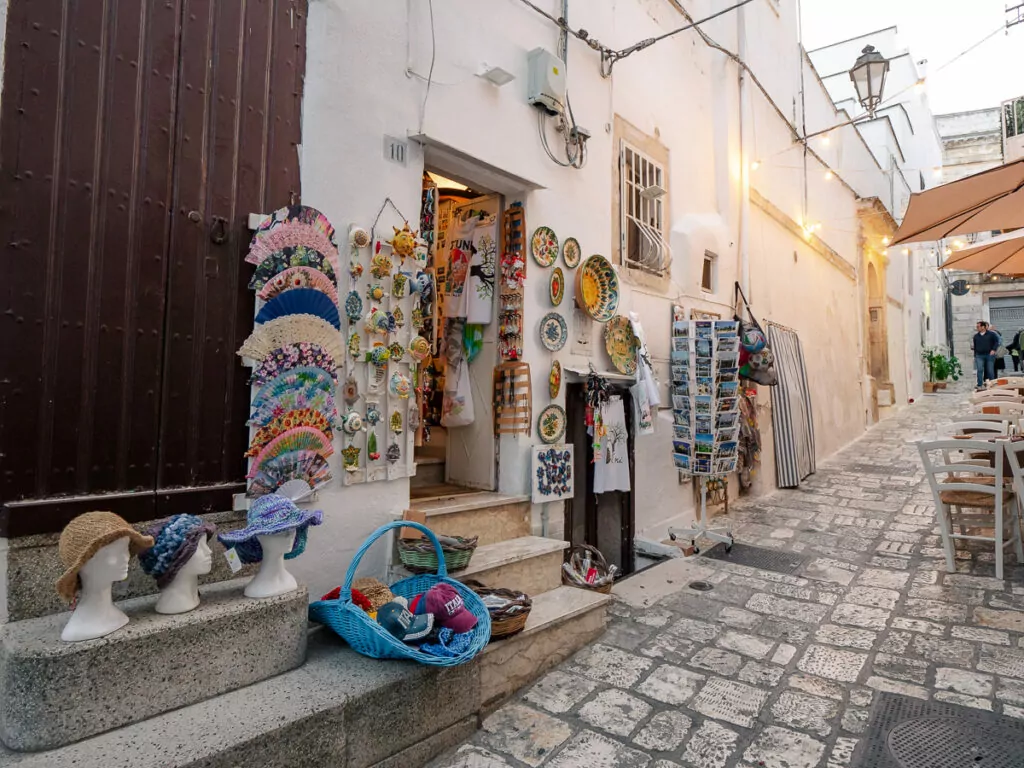
Things to do in Ostuni
- Search for the best photo spots in the Centro Historico, it’s insanely photogenic
- See the Duomo di Santa Maria Assunta, Ostuni’s 15th century cathedral
- Stay in an authentic historic stone house
- Ride an e-bike through the olive trees
- Or do a full olive grove tour with a visit to an 1840s oil mill
- Have a traditional dinner at an Ostuni local’s home
- Visit Cremerie alla Scala for a scoop of gelato on a buttery brioche bun
- Head to Bar Perso at sunset
- I have lots of food recs so I’ll just list them all here: Vulcani, Dish, Terra Nostra Salumeria, Asso di Spade (cheap panzerotti!), Casa San Giacomo, Passaporto Alchimia & Cucina, Ristorante La Vecchia Terrazza
- Don’t forget to leave the old town to find some more local and affordable eateries
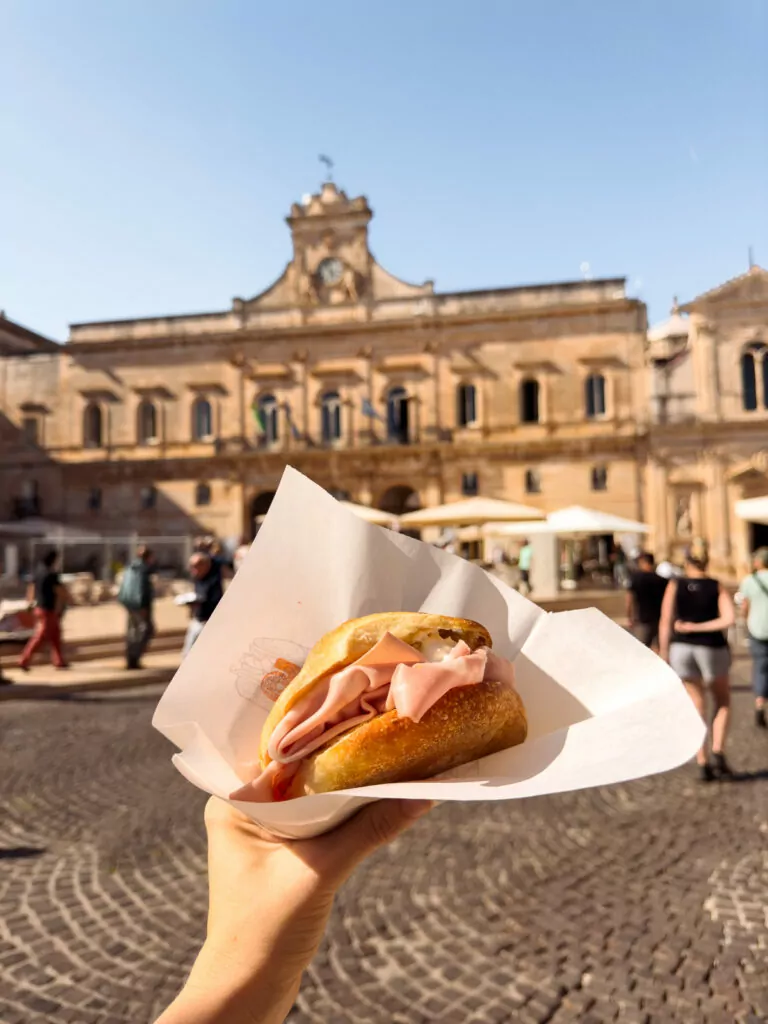
Where to stay in Ostuni
Budget
- I stayed at Liberty Bell, a small apartment in a residential area 10 mins from the historical centre. Cheap and cheerful!
- Ostuni Guesthouse (very cheap, around the corner from where I stayed)
- Casa Flami (budget-friendly option in the historical centre)
In-between
- Ariad Collection (super cool loft-style apartment)
- Atagio Luxury Room (top-rated old town guesthouse)
- Primo Ostuni Hotel (modern hotel right next to the bus stop, excellent reviews)
Luxury
- Paragon 700 Boutique Hotel (a divine 5* wellness hotel, on my bucket list!)
- La Sommità Relais & Chateaux (5* oasis hidden in the Centro Storico)
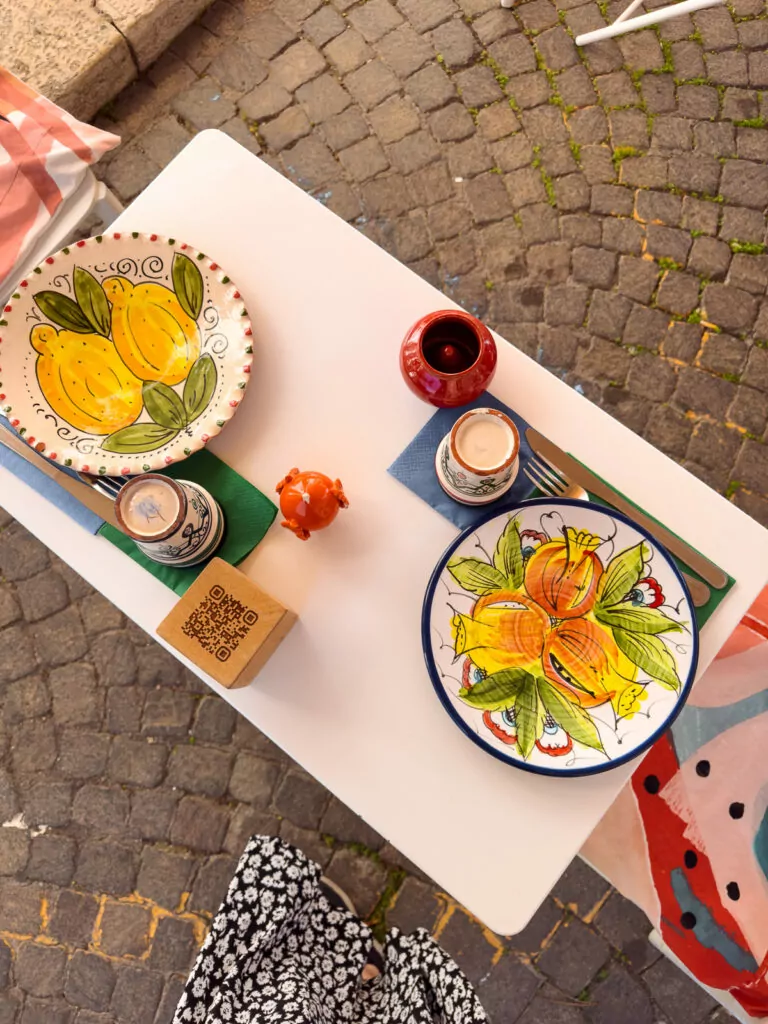
Brindisi
How to get from Ostuni to Brindisi
Annoyingly the Ostuni train station isn’t actually in Ostuni, it’s a 15 minute bus away from the town.
From the Ostuni Centro Storico bus stop (which is a short walk down the hill from the actual Centro Storico), you can catch a 15 minute bus which gets you to Ostuni’s train station. You can buy tickets for the bus from various tabaccheria and bars (any tabaccheria will be able to point you in the right direction) or pay with cash on board if you have the right amount, they won’t give you change.
From Ostuni train station you can jump onto the Puglia coastal train which will get you to Brindisi in less than 25 minutes.
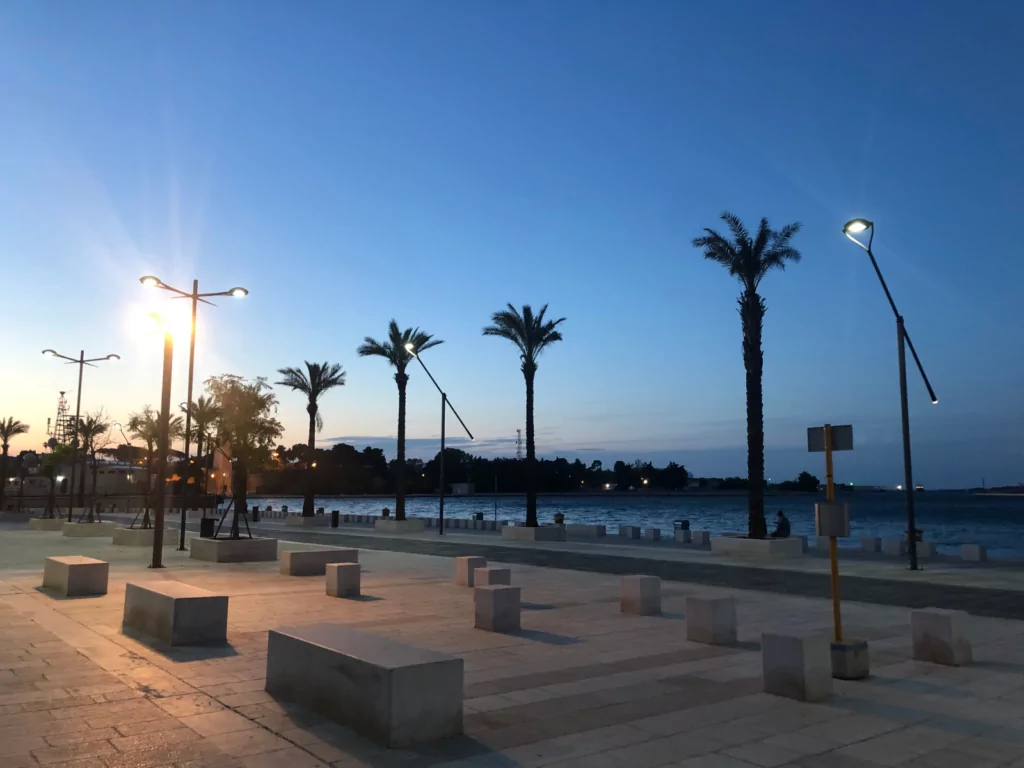
About Brindisi
After a little detour inland, we’re back by the sea! Brindisi is the second gateway to Puglia (after Bari), with an international airport and a ferry terminal which welcomes incoming travellers from Greece and Albania.
It’s more of a convenient base vs. a magical destination in its own right, but it does have a beautiful waterfront, lots of historical buildings and the seafood is as good as you’d expect for a port town. It’s also MUCH cheaper than the tourist towns and Bari, so if you’re pressed for money, it might be the right location to park up for day trips.
Things to do in Brindisi
- Stroll down the palm-lined lungomare
- Climb the 260 steps to the top of the Marinaio d’Italia, a memorial to sailors who died in WWI and WWII
- Take a tour around the medieval Castello Alfonsino
- See the Byzantine frescoes inside Church of Santa Maria del Casale
- My food recs are Taschino Lab, La Baracchina del Porto and Brunda Pizzeria
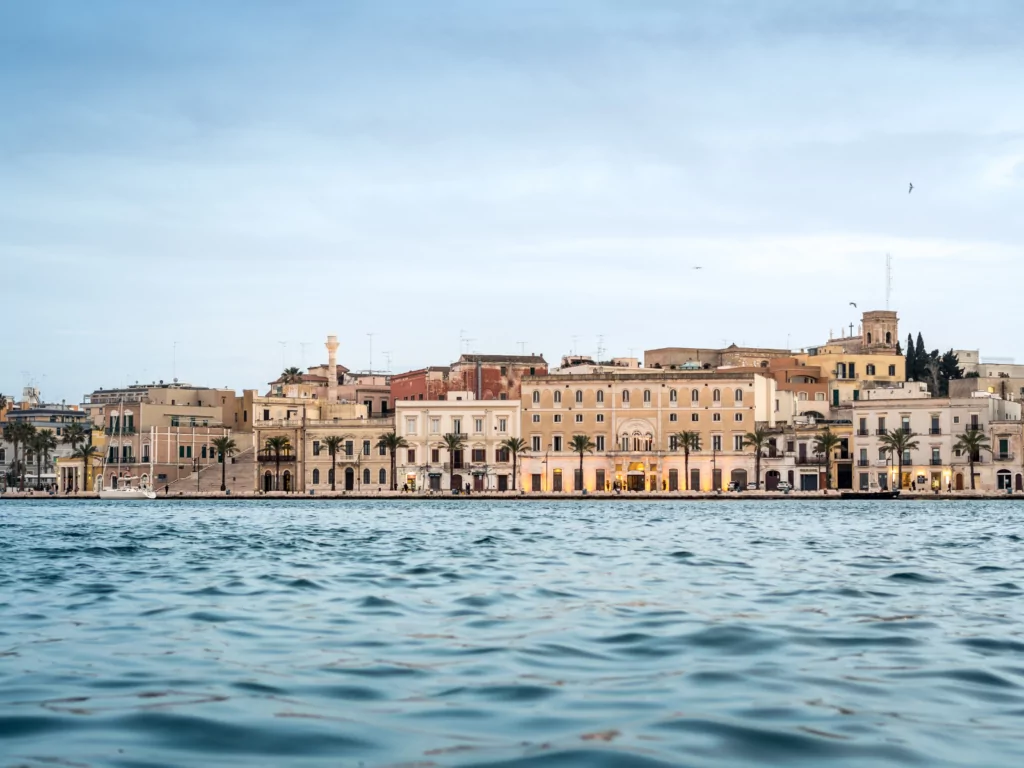
Where to stay in Brindisi
Budget
- Ostello della Gioventù Brindisi (clean and cheap boutique hostel)
- Bed & Breakfast Station (simple B&B right by the train station)
In-between
- Mare Fuori (simple, affordable apartment in a great location)
- Agorà Connect Space (modern, well-equipped studios)
- Loft Porta Sud Civ.33 (top-rated apartment in the historical centre)
Luxury
- ELLEMENTS (beautiful newly-renovated luxury suites)
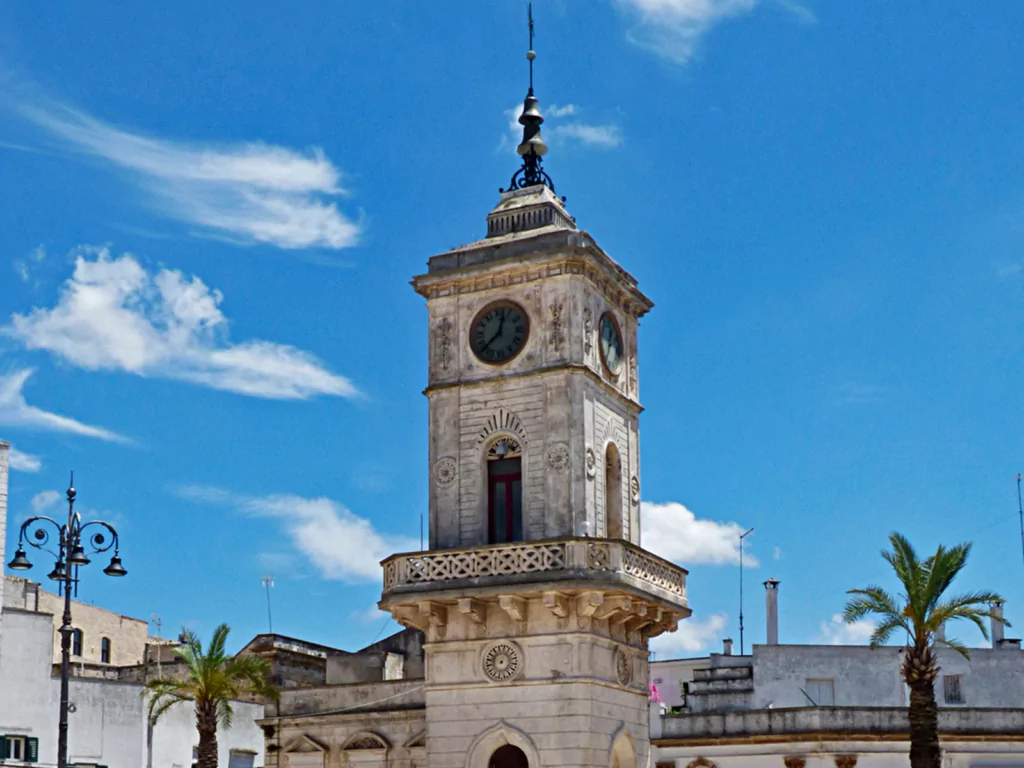
Lecce
How to get from Brindisi to Lecce
Direct 20 minute train, easy peasy.
About Lecce
Widely regarded as the ‘Florence of the South’, Lecce’s Baroque buildings made from local yellow limestone are a must-see for art enthusiasts and history buffs. The cultural scene is on fire here, with expert artisans selling their handiwork, elevated eateries and wine bars, and a packed calendar of arts, music and other entertainment year-round.
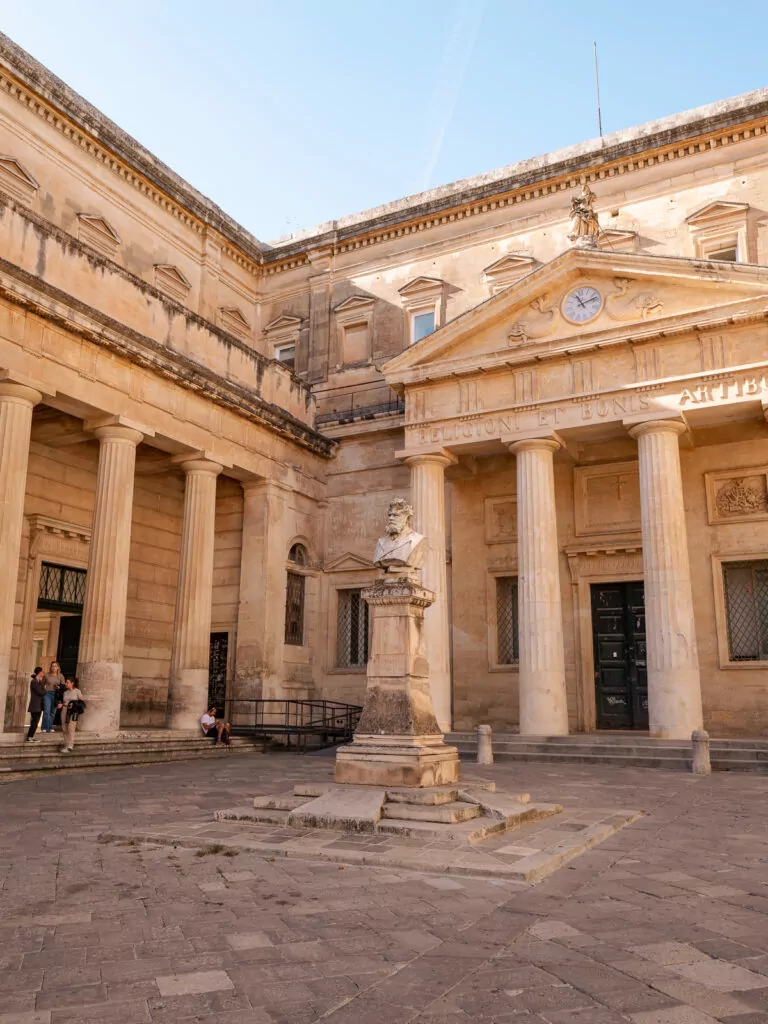
Things to do in Lecce
- A walking tour needs to be top of your Lecce list, it’s the perfect way to get your bearings and understand how the city’s past has shaped what you see today
- Or opt to tour the old town by bike instead
- Visit the magnificent Basilica di Santa Croce
- Make pasta by hand in a 15th century courtyard
- See the Roman Amphitheatre, it dates back to the 2nd century but was only discovered in 1901. As of January 2025 there’s a lot of construction around it but you can still see it from the piazza.
- Join the locals for their daily passeggiata (a post-riposo, pre-dinner stroll) around Piazza Sant’Oronzo
- Taste Lecce’s specialties with a street food tasting tour
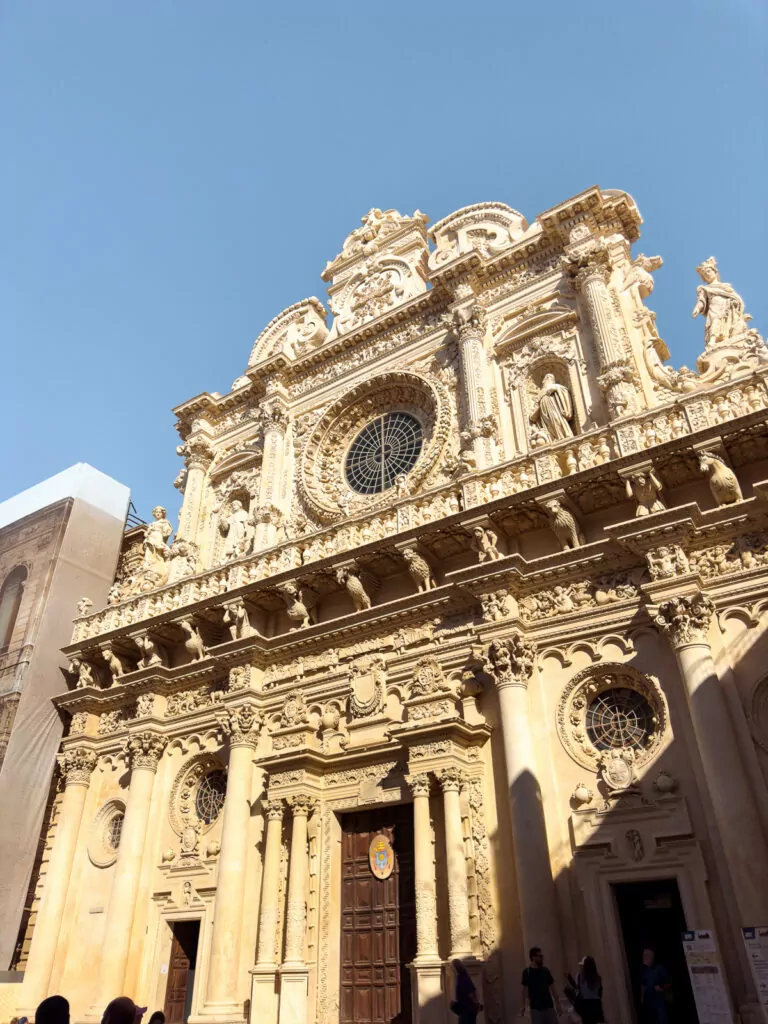
Where to stay in Lecce
Budget
- Lobby Collective Hostel (simple social hostel)
- Urban Oasis Hostel (basic but top-rated hostel)
- B&B Fenice Barocca (super cute guesthouse with cheap private rooms)
In-between
- Federico’s Vila (much-loved guesthouse experience with delicious breakfast)
- Dimi House (stylish rooms near all of Lecce’s must-sees)
- Prezioso Suites (trendy studios at decent prices)
Luxury
- La Fiermontina Luxury Hotel (stunning 5* property offering ultimate peace and quiet)
- Palazzo Sant’Anna Lecce (top-rated 4* hotel with a beautiful terrace)
- Palazzo Maresgallo Suites (4* boutique hotel and spa in the historical centre)
- Palazzo Zimara Boutique Hotel (newly opened with rave reviews)
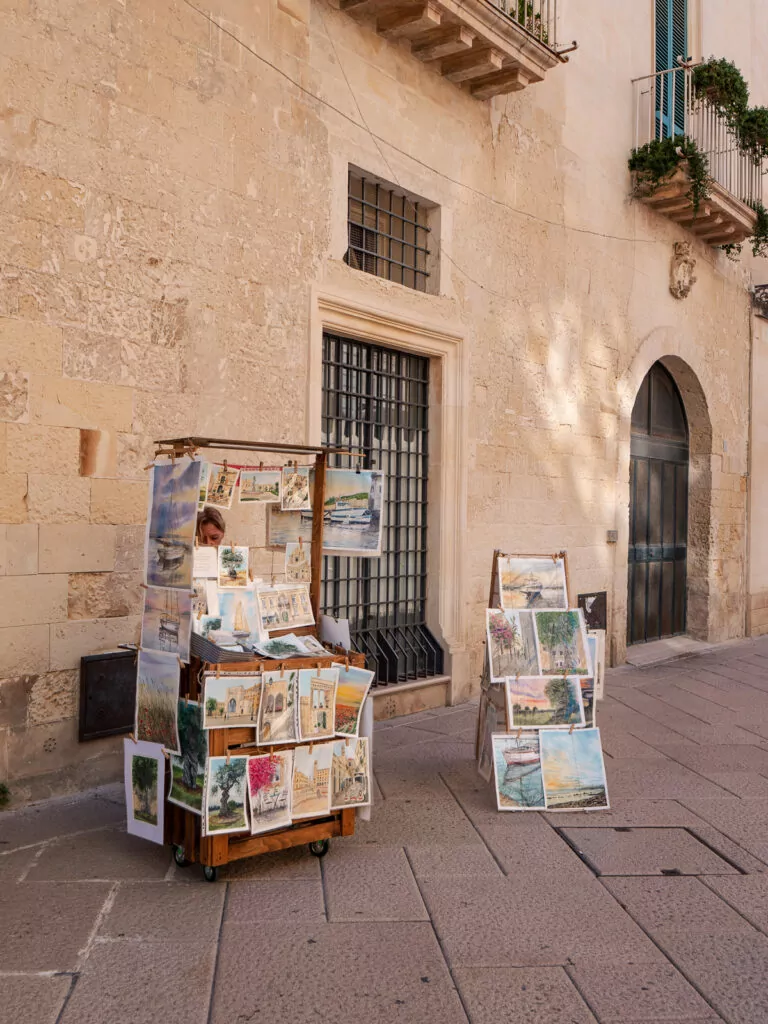
Car-free Puglia itineraries
Two weeks in Puglia without a car
This is essentially the exact itinerary I followed, except it took me three weeks because I kept making transport mistakes and was booking everything last minute 🙃
This is fast-paced and you’d be overnighting in 6/7 different towns, but it’s absolutely doable with public transport and covers a lot of ground. If you prefer a more relaxed style of travel, take the 10 day itinerary below and stretch it to fit two weeks instead.
- Day 1: Arrive in Bari, explore the old town
- Day 2: Bari food tour & subsequent food coma
- Day 3: Bus from Bari to Matera, dinner somewhere fancy with a view
- Day 4: Matera exploring! Book a guided tour or just wander.
- Day 5: Bus back to Bari, train to Monopoli, explore the old town
- Day 6: Day on the water. Book a boat tour, hire a paddleboard or relax at the beach.
- Day 7: Day trip to Polignano a Mare
- Day 8: Monopoli to Alberobello by bus, explore Alberobello once the daytrippers have departed
- Day 9 option 1: Day trip to Locorotondo & Cisternino by bus, then back to Alberobello
- Day 9 option 2: Alberobello morning, then a masseria for one night (this will be pricey but if you can afford it it’ll be worth it)
- Day 10: Alberobello or masseria to Ostuni by bus (might have to catch a cab from your masseria to the nearest bus stop), Ostuni sunset drinks and nice dinner
- Day 11: Full day Ostuni. Do a food tour, book a cooking class, or visit an olive grove.
- Day 12: Bus from Ostuni Centro Storico to the train station, then train to Lecce with an afternoon of exploring
- Day 13: Walking tour or food tour in Lecce
- Day 14: Depart Lecce by train if you’re heading elsewhere in Italy, or train to Brindisi/Bari to fly home
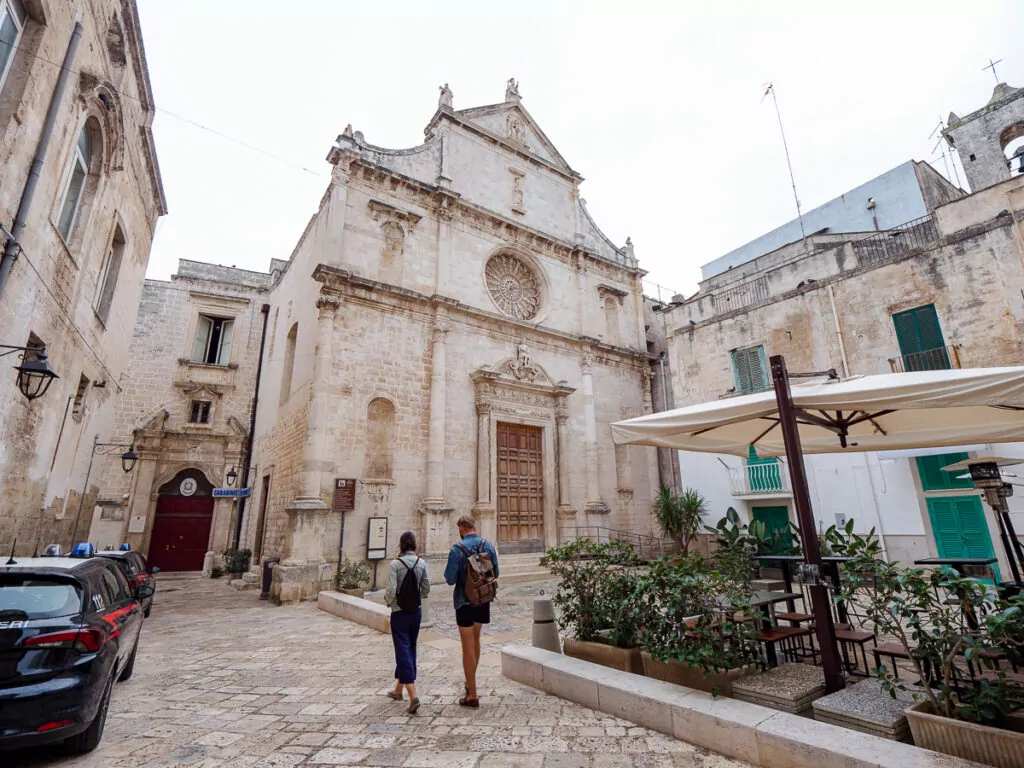
10 days in Puglia without a car
10 days overnighting in four different towns, with day trips to Matera and the Trulli Towns.
- Day 1: Arrive in Bari, Bari exploring
- Day 2: Day trip to Matera
- Day 3: Matera to Monopoli, Monopoli exploring
- Day 4: Full day Monopoli or Polignano a Mare
- Day 5: Monopoli to Ostuni, Ostuni exploring
- Day 6: Full day Ostuni
- Day 7: Day trip to Alberobello, Locorotondo and/or Cisternino
- Day 8: Ostuni to Lecce, Lecce exploring
- Day 9: Full day Lecce
- Day 10: Depart Lecce by train for your next Italian stop, or train to Brindisi/Bari to fly home
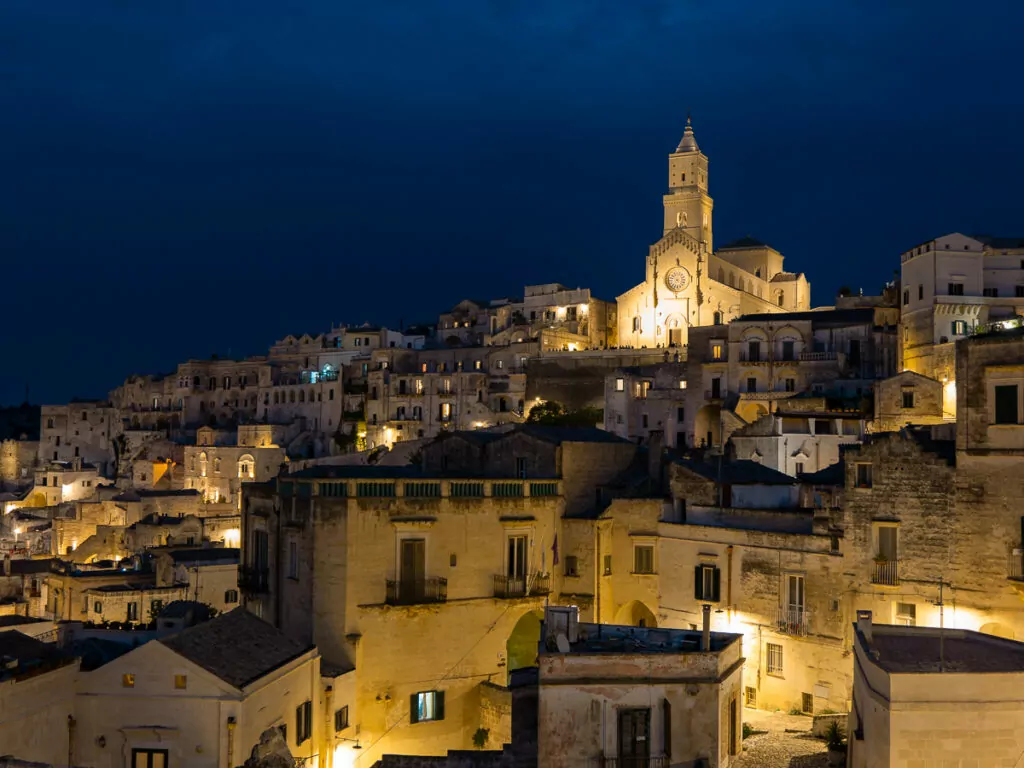
One week in Puglia without a car
Choose a base or two and do day trips! Which brings me to…
The best base in Puglia if you don’t have a car
If you’re pressed for time, sticking to a base (or splitting your time between two) will make your Puglia adventure much smoother. Here are some things to consider when choosing where to park up for your trip.
Bari as a base
- Brilliantly connected to everywhere!
- Direct bus to Matera (1h)
- Direct train to Monopoli (20-30m)
- Direct bus to Alberobello (1h 5m)
- Direct train to Ostuni (45m)
- Direct train to Lecce (1h 20m-1h 50m)
- Usually the cheapest place to fly into
- Quite expensive for what you get in terms of accommodation
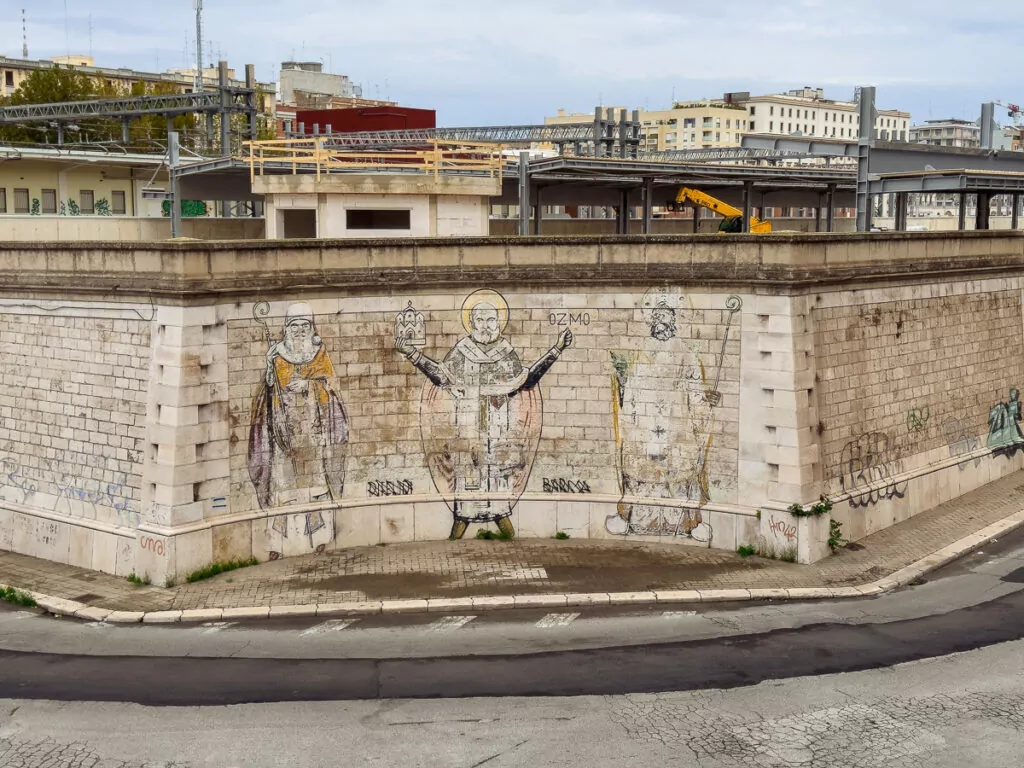
Monopoli as a base
- No hostels or real budget options for accomm but lots in the mid-range
- Just good vibes
- Lots of beaches nearby
- Well-connected to most places in Puglia but you’d have to go via Bari to reach Matera
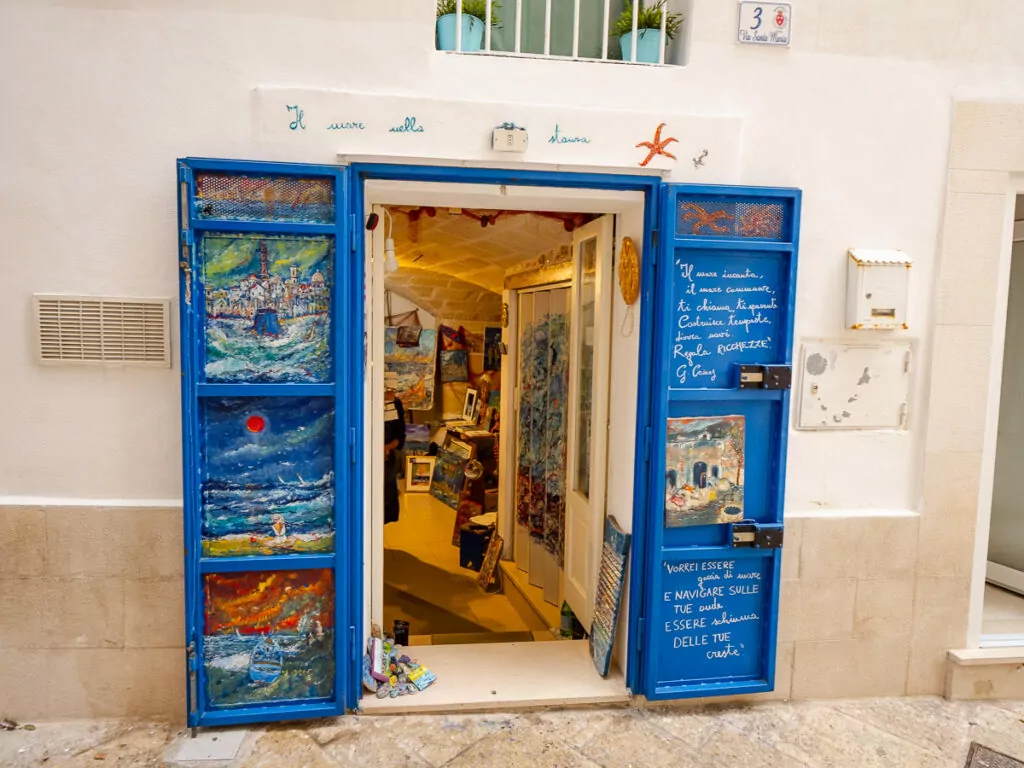
Brindisi as a base
- Super affordable with one hostel and lots of cheap guesthouses
- Not a huge amount to see and do in the city but excellent food
- Very industrial, not charming like the other spots
- Well-connected to Bari, Monopoli, Ostuni and Lecce but for Alberobello you’d need to go via Monopoli for the simplest way, and for Matera you’d have to go via Bari
- Low cost carriers sometimes have cheeeap flights
- Could be split with Bari: Four nights Brindisi for Lecce, Ostuni and Monopoli day trips, then three nights Bari for Alberobello and Matera
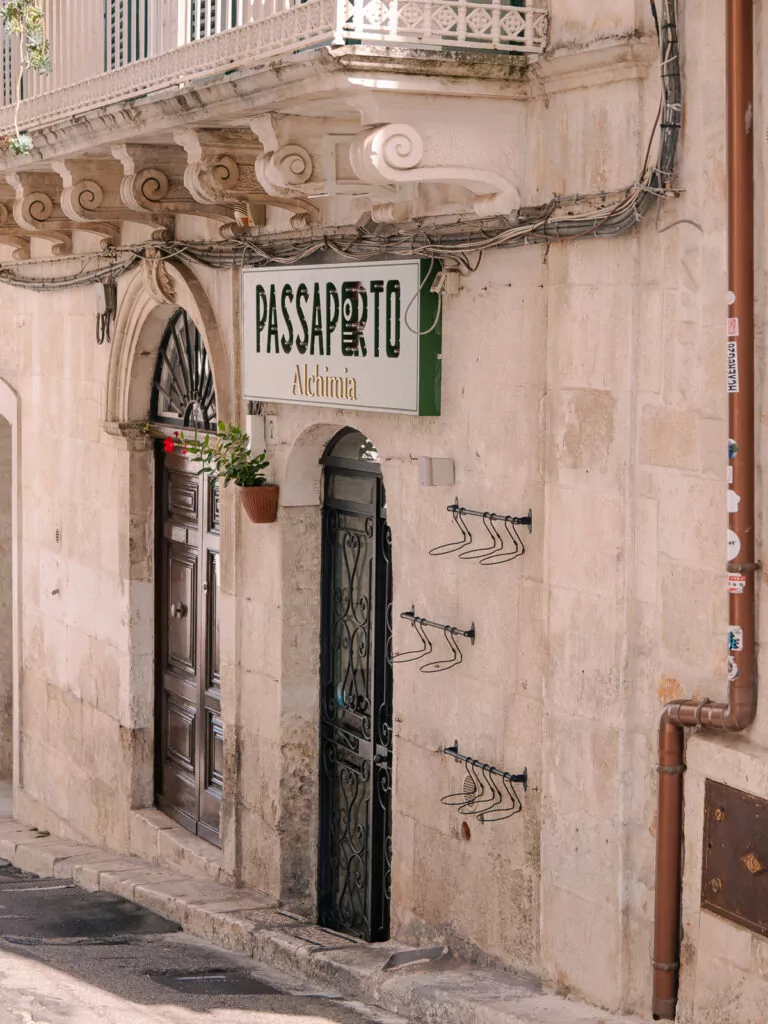
Lecce as a base
- Also better value than the northern Puglia options
- Excellent for history nerds and art lovers
- Easy access to southern Puglia like Otranto and Gallipoli (I didn’t make it here because they have a shorter season and I was there in mid-October)
- Too far for day trips to Ostuni, Alberobello, Matera etc.
- Could be split with Bari if you’re keen to do explore the south + then use Bari to see Matera, Ostuni, Alberobello
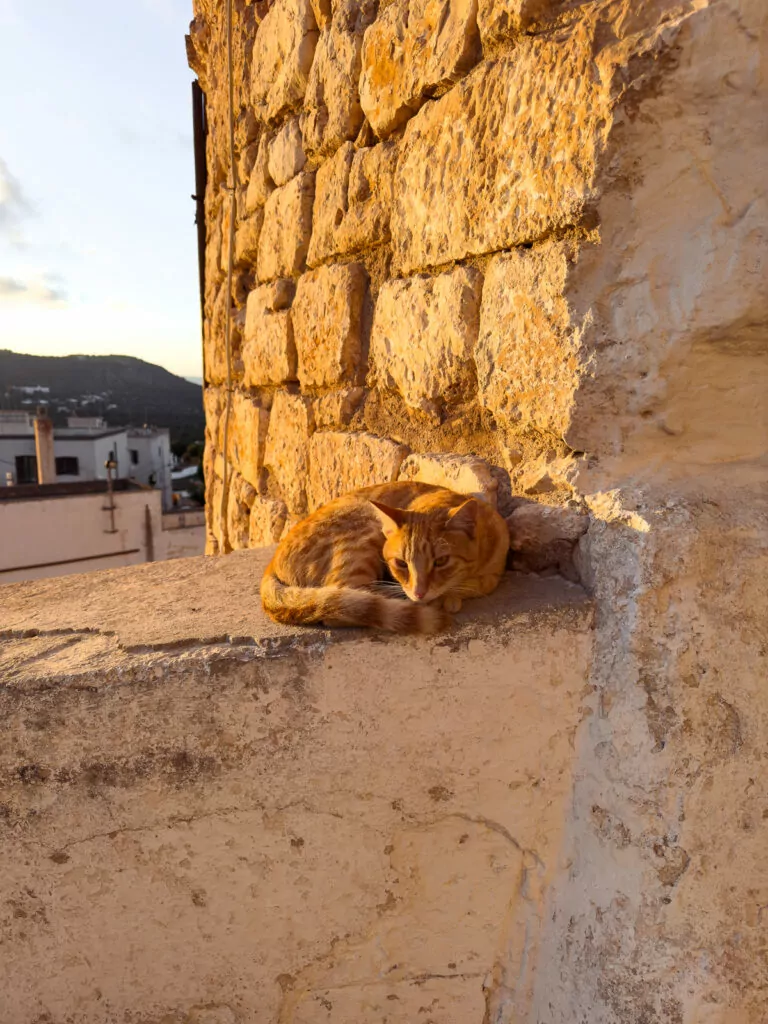
FAQs about travelling Puglia without a car
Is it possible to travel around Puglia without a car?
Absolutely, if you don’t mind navigating public transport and planning out your travel in advance then it’s definitely possible to travel around Puglia without a car.
What are the best ways to get around Puglia without a car?
Trains for the coastal route (Bari, Polignano a Mare, Monopoli, Ostuni, Brindisi and Lecce), buses for the inland towns (Alberobello, Locorotondo, Matera in Basilicata).
Can you take day trips from Bari without a car?
Definitely, you can do day trips to places like Matera, Alberobello, Monopoli, Lecce and more, either by public transport or by booking an organised tour.
How much does public transportation cost in Puglia?
Fares depend on the exact route and operator but overall it’s very cheap, less than €12 for most trips within the region. The FlixBus from Bari to Matera is priced based on demand though and can get expensive if you book last minute, so book your seat early.
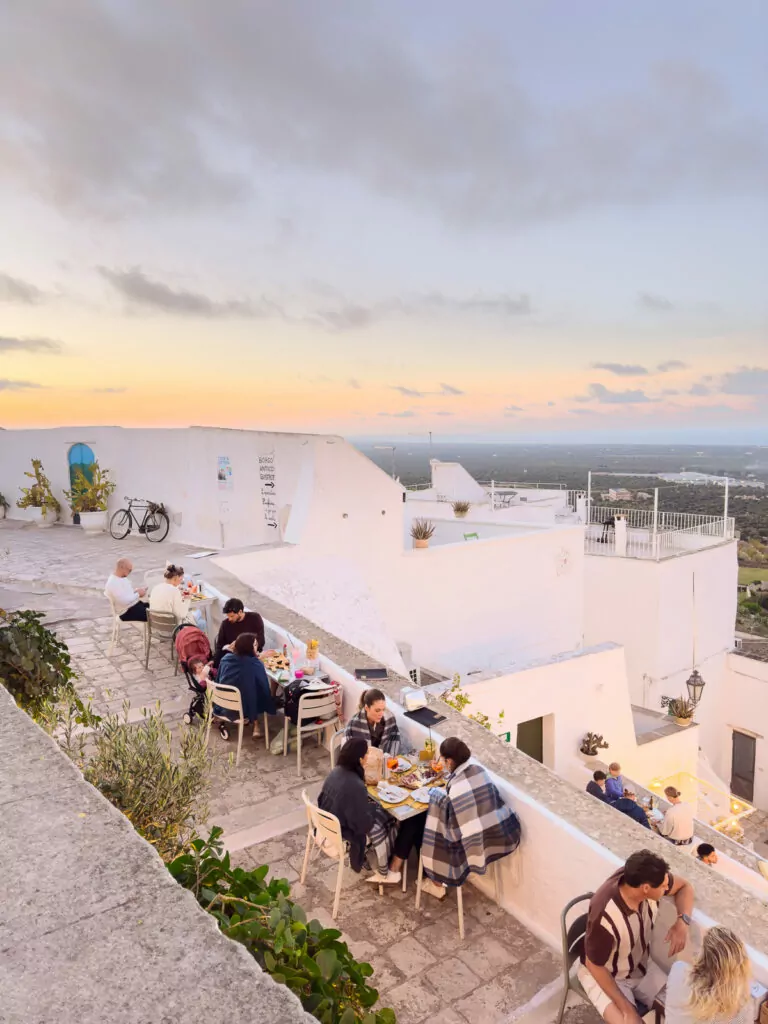
Where can I find reliable information about train and bus schedules in Puglia?
I wish that was an easy question to answer, but there are sooo many different operators and there’s no one platform that’s always kept up to date. Google Maps is a good starting point, and you can check with local information centres in the destination to make sure you’ve got the right info.
What are the pros and cons of travelling Puglia without a car?
Pros: Cheaper than rental car, no need to pay for parking, ideal if you aren’t a confident driver on Italian roads, lets you see a more local side of the region.
Cons: Logistically tricky, difficult to find up to date schedules, not great if you’ve got lots of luggage.
Is it difficult to travel with luggage on public transportation in Puglia?
Again it really depends on the mode of transport you take. Trains have space for luggage, some buses have under-bus compartments but some buses are normal ‘city’ buses with a small accessible area where you can hold a suitcase (not ideal for windy country roads, and you’ll struggle to fit on a busy day).
Can you reach beaches by public transport?
You can reach a lot of beaches by public transport, but these beaches are often very busy thanks to their easy access. The best way to see beaches without a car in Puglia is to book a boat tour from Monopoli or Polignano a Mare!
Do you need travel insurance for Puglia?
Travel insurance isn’t mandatory for Italy (unless you’re on a visa that requires it) but it’s highly, highly recommended. Non-EU-residents aren’t usually entitled to free healthcare beyond emergency treatment, and you could end up paying loads for hospital stays, scans or medication.
A good travel insurance policy will also cover things like cancellations, delayed luggage, stolen belongings and more. I use Cover-More Travel Insurance for all my trips (Australian residents can find Cover-More AU here).
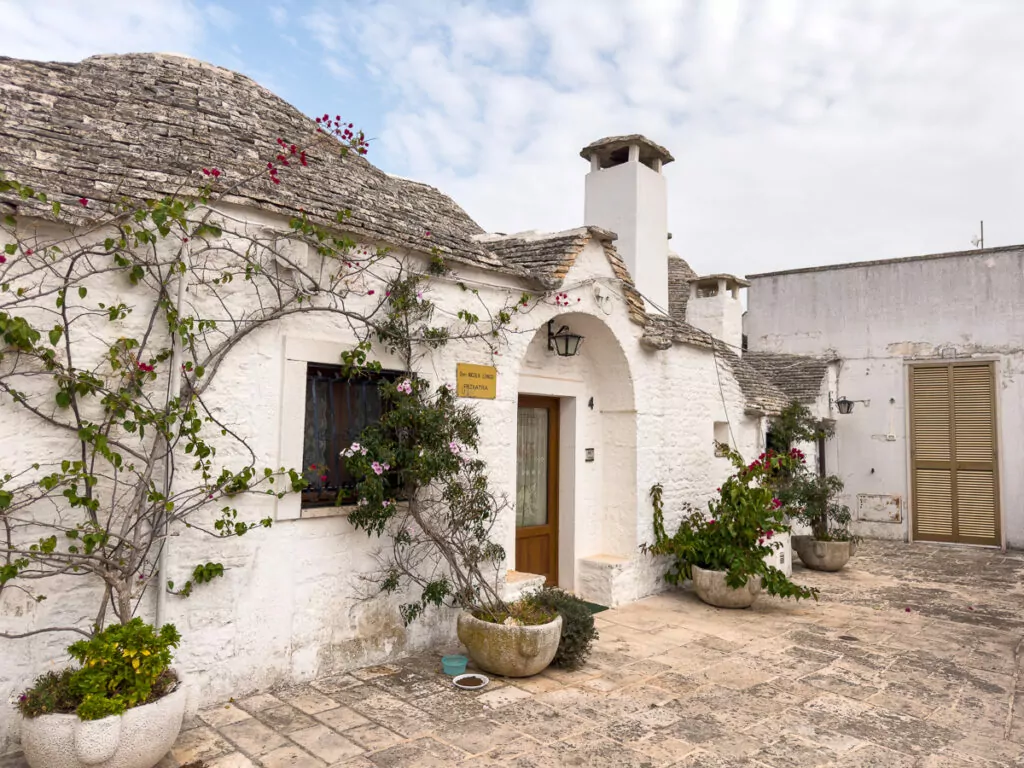
There you go, contrary to the internet’s consensus, Puglia without a car is possible with a bit of research, planning, and a healthy dose of patience! This region of Italy is so special, it would be a shame to miss out just because you’re not keen or not able to drive.
Just remember to pack light, embrace the logistical tangles, and eat ALL the food. Ciao for now, safe travels!
P.S. As always, if you have any questions or want to share your own Puglia tips then please feel free to leave a comment.
MORE ITALY BLOG POSTS:
- The ultimate itinerary for Northern Italy & Switzerland
- A guide to the Dolomites
- Everything you need to know before visiting the Dolomites without a car
- ADLER DOLOMITI: The best value wellness hotel in the Dolomites
- How to spend 2 days in Milan
- How to spend 24 hours in Florence
- The ultimate Italy bucket list
- Bernina Express guide: The scenic train from Tirano to Chur
MORE CAR-FREE EUROPE ITINERARIES:
- The *ultimate* three month Europe itinerary without flying or driving
- How to see the Europe Christmas markets by train
- How to spend 10 days in Switzerland by train
- 3 week Scandinavia itinerary by train
- How to spend 4 days in Norway
- How to spend two weeks in Poland without a car
- How to spend two weeks in Albania without a car
MY GO-TO TRAVEL PLANNING RESOURCES
Flights ✈️ I use Skyscanner to find the best flights for my trip and then I’ll always book direct with the airline to protect myself from having to deal with dodgy third parties if anything goes wrong.
Trains 🚂 If I’m travelling through Europe, I try to travel by train wherever possible! For an extended trip (2+ weeks) I’ll calculate if a Eurail Pass is worth it, or I’ll book point-to-point tickets through RailEurope or the local train operator.
Accommodation 🛎️ I book almost all of my accommodation through booking.com, they have a user-friendly website + app and many of their options are free cancellation, easily cancelled with a simple click of a button.
Activities 🗽I use GetYourGuide, Klook and Viator to look for activities in the places I visit, or I just Google ‘things to do in [city]’! P.S. If you book anything on Klook you can use the promocode FINDINGALEXXKLOOK to get 10% off
Travel cards 💳 I’m a Wise gal through and through, they’ve been my chosen travel card for more than five years now. You can easily top up your card from your bank account or through Apple Pay, convert your money to local currency, and spend money with minimal fees and the best exchange rates around.
Travel insurance 🩺 I use Cover-More NZ travel insurance for my own trips, I have a comprehensive policy and I’ve only had good experiences with them. Cover-More also has an Australian company, but if you’re from elsewhere then two popular insurance options for global travellers are SafetyWing (cheaper policy, lower coverage) and World Nomads (more expensive but significantly better coverage).
Luggage 💼 I travel with Samsonite Cosmolite suitcases, one 75cm check in bag and a 55cm carry on bag, and I absolutely adore them and will never travel with anything else! They are SUPER lightweight (2.8kg and 1.9kg respectively) so I have much more space for my actual stuff.
Camera gear 📸 I use a iPhone 15 Pro Max for phone photos/videos, and my camera kit includes a Lumix S9 (incredible lightweight full-frame camera, a game changer for travel creators!) with a 20-60mm lens, a Lumix G9 with an 8-18mm and 12-60mm lens, a DJI Mini 3 Pro drone and a GoPro Hero 10. I do all my writing and editing on my ASUS Zenbook 14, it’s lightweight but powerful enough for photo editing and intense blogging sessions.

Going to Puglia in July for a wedding I read all your recommendations can’t wait love what you wrote thanks
Have the best time 🙂